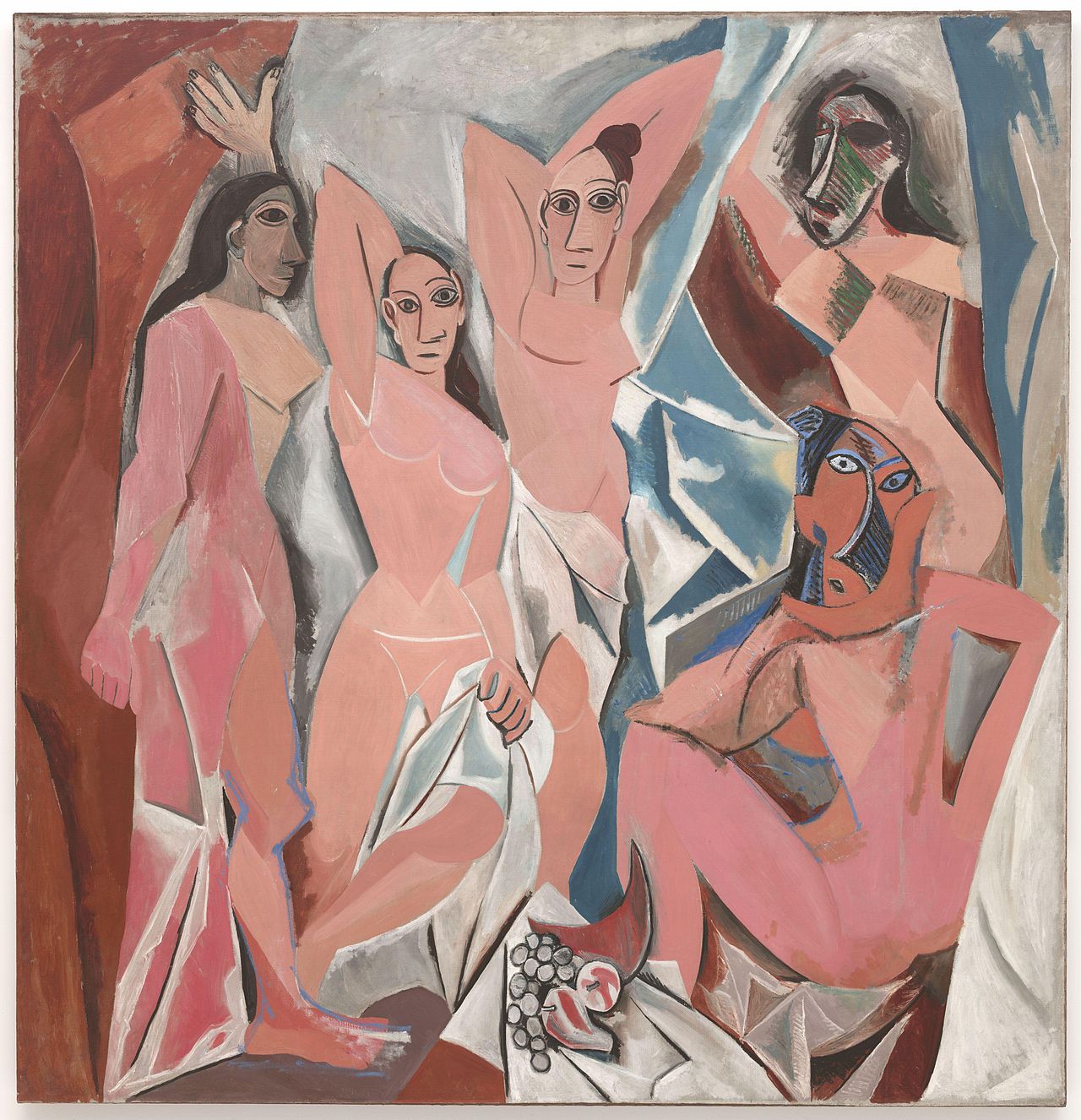
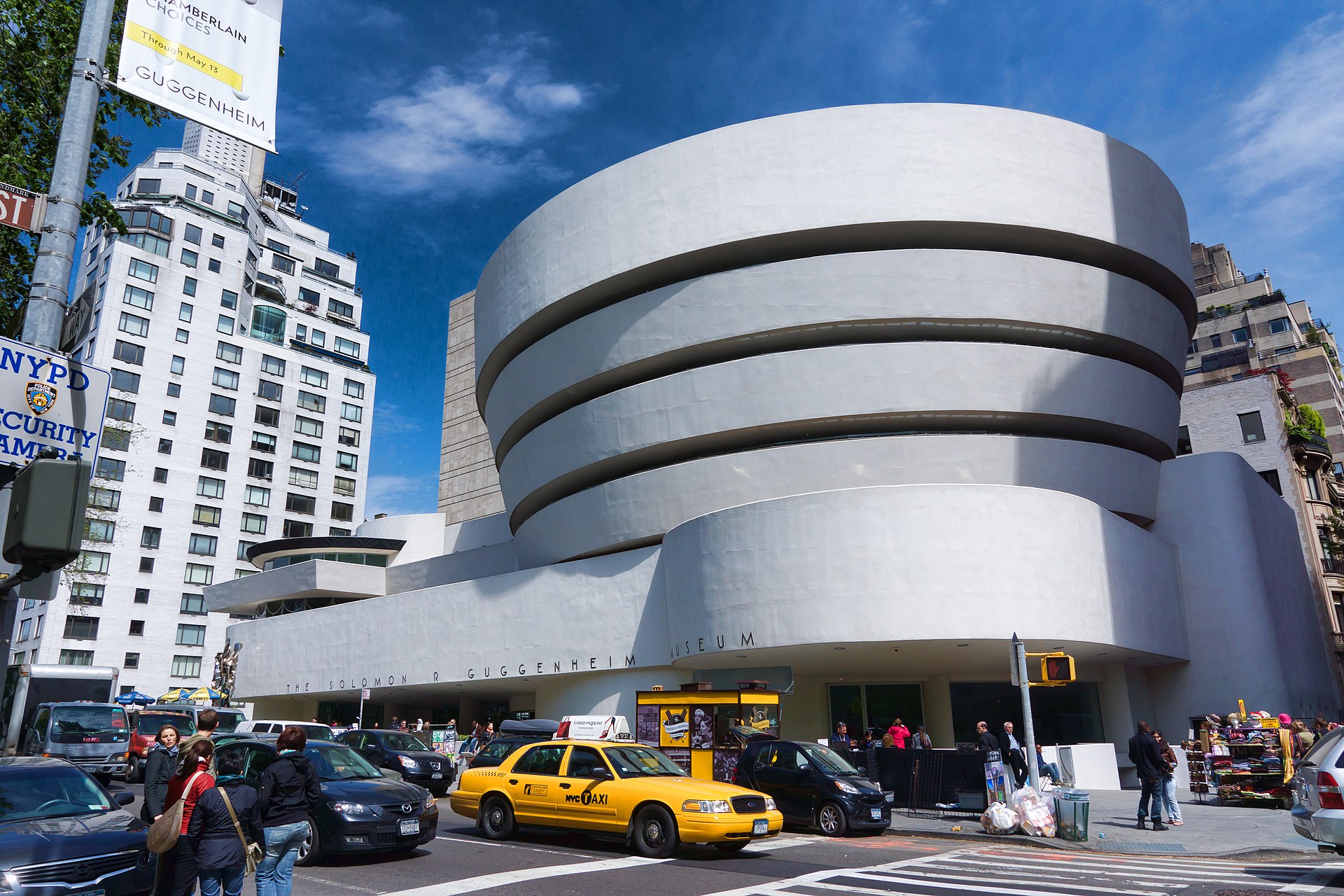
モダニズム
Modernism


Les Demoiselles d'Avignon, Pablo
Picasso, 1907, oil on canvas, 244 x 234 cm; arguably the first cubist
painting; Solomon R. Guggenheim Museum
☆ モダニズムとは、19世紀後半から20世紀初頭にかけて西洋社会が大き く変容したことから生まれた哲学、宗教、芸術運動である。この運動は、都市化、建築、新技術、戦争などの特徴を含む、新しく出現した産業世界を反映した芸 術、哲学、社会組織の新しい形態の創造への願望を反映している。芸術家たちは、彼らが時代遅れ、あるいは時代遅れと考えた伝統的な芸術の形式から離れよう とした。詩人エズラ・パウンドが1934年に発した「Make it New」という命令が、この運動のアプローチの試金石となった。
★ポストモダンにおける時間性を考えるヒント;
1)モダンという時間の中に「発展」という考え方がある
2)「発展」はつねに右肩あがりである
3)プレモダン→アーリーモダン→ミッドモダン→レイトモダン→ポストモダンという時間の進行のうち「アーリーモダン→ミッドモダン→レイトモダン」が、モダンという時間性である。
4)モダンというもの(概念)の中に完成という概念があるので、モダニストにとって、ポストモダンは、厄介な時間、新しい問題性が生じる時間、取り組まなければならない新しい(sui generis)課題があると考える。
| Modernism is a
philosophical, religious, and arts movement that arose from broad
transformations in Western society during the late 19th and early 20th
centuries. The movement reflected a desire for the creation of new
forms of art, philosophy, and social organization which reflected the
newly emerging industrial world, including features such as
urbanization, architecture, new technologies, and war. Artists
attempted to depart from traditional forms of art, which they
considered outdated or obsolete. The poet Ezra Pound's 1934 injunction
to "Make it New" was the touchstone of the movement's approach. Modernist innovations included abstract art, the stream-of-consciousness novel, montage cinema, atonal and twelve-tone music, divisionist painting and modern architecture. Modernism explicitly rejected the ideology of realism[a][2][3] and made use of the works of the past by the employment of reprise, incorporation, rewriting, recapitulation, revision and parody.[b][c][4] Modernism also rejected the certainty of Enlightenment thinking, and many modernists also rejected religious belief.[5][d] A notable characteristic of modernism is self-consciousness concerning artistic and social traditions, which often led to experimentation with form, along with the use of techniques that drew attention to the processes and materials used in creating works of art.[7] While some scholars see modernism continuing into the 21st century, others see it evolving into late modernism or high modernism.[8] Postmodernism is a departure from modernism and rejects its basic assumptions.[9][10][11] https://en.wikipedia.org/wiki/Modernism 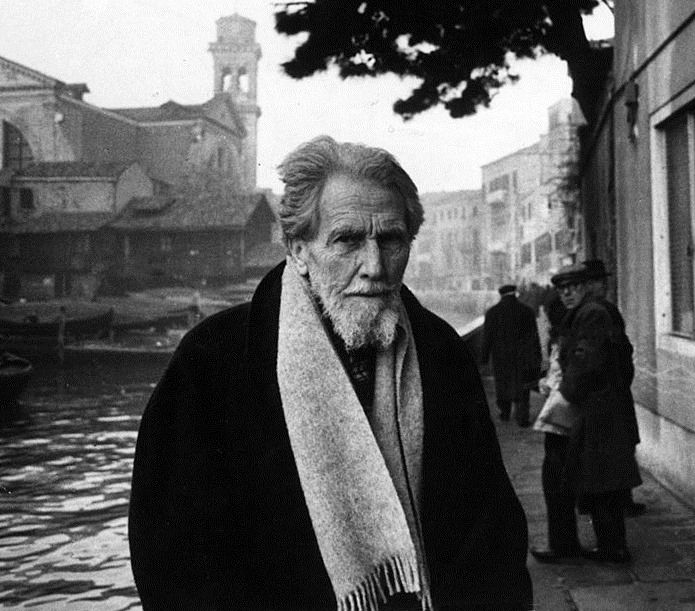 Ezra Pound in Venice, 1963 |
モダニズムとは、19世紀後半から20世紀初頭にかけて西洋社会が大き
く変容したことから生まれた哲学、宗教、芸術運動である。この運動は、都市化、建築、新技術、戦争などの特徴を含む、新しく出現した産業世界を反映した芸
術、哲学、社会組織の新しい形態の創造への願望を反映している。芸術家たちは、彼らが時代遅れ、あるいは時代遅れと考えた伝統的な芸術の形式から離れよう
とした。詩人エズラ・パウンドが1934年に発した「Make it New」という命令が、この運動のアプローチの試金石となった。 モダニズムの革新には、抽象芸術、意識の流れの小説、モンタージュ映画、無調音楽や十二音音楽、分割主義の絵画、近代建築などがあった。モダニズムはリア リズムのイデオロギーを明確に否定し[a][2][3]、再演、取り込み、書き直し、再現、改訂、パロディを用いることによって過去の作品を利用した [b][c][4]。モダニズムは啓蒙思想の確実性も否定し、多くのモダニストは宗教的信仰も否定した。 [5][d]モダニズムの顕著な特徴は、芸術的および社会的伝統に関する自意識であり、それはしばしば、芸術作品を創作する際に使用されるプロセスや素材 に注目させる技法の使用とともに、形式の実験につながった[7]。 ポストモダニズムはモダニズムからの逸脱であり、その基本的な前提を否定している[9][10][11]。  エズラ・パウンド(ヴェニス, 1963) |
| Definition Some commentators define modernism as a mode of thinking—one or more philosophically defined characteristics, like self-consciousness or self-reference, that run across all the novelties in the arts and the disciplines.[12] More common, especially in the West, are those who see it as a socially progressive trend of thought that affirms the power of human beings to create, improve, and reshape their environment with the aid of practical experimentation, scientific knowledge, or technology.[e] From this perspective, modernism encouraged the re-examination of every aspect of existence, from commerce to philosophy, with the goal of finding that which was holding back progress, and replacing it with new ways of reaching the same end. According to Roger Griffin, modernism can be defined as a broad cultural, social, or political initiative, sustained by the ethos of "the temporality of the new". Modernism sought to restore, Griffin writes, a "sense of sublime order and purpose to the contemporary world, thereby counteracting the (perceived) erosion of an overarching 'nomos', or 'sacred canopy', under the fragmenting and secularizing impact of modernity." Therefore, phenomena apparently unrelated to each other such as "Expressionism, Futurism, vitalism, Theosophy, psychoanalysis, nudism, eugenics, utopian town planning and architecture, modern dance, Bolshevism, organic nationalism – and even the cult of self-sacrifice that sustained the hecatomb of the First World War – disclose a common cause and psychological matrix in the fight against (perceived) decadence." All of them embody bids to access a "supra-personal experience of reality", in which individuals believed they could transcend their own mortality, and eventually that they had ceased to be victims of history to become instead its creators.[14] https://en.wikipedia.org/wiki/Modernism |
定義 モダニズムを、自己意識や自己言及のような、芸術や学問分野のあらゆる新しさを貫く、哲学的に定義された特徴、あるいはそれ以上の思考様式と定義する論者 もいる[12]。 より一般的なのは、特に西洋において、モダニズムを、実践的な実験や科学的知識、あるいは技術の助けを借りて、環境を創造し、改善し、再形成する人間の力 を肯定する、社会的に進歩的な思考傾向として捉える人々である。 [この観点から、モダニズムは商業から哲学に至るまで、存在のあらゆる側面の再検討を奨励し、進歩を妨げているものを見つけ出し、同じ目的に到達するため の新しい方法に置き換えることを目標とした。 ロジャー・グリフィンによれば、モダニズムとは、「新しいものの時間性」という倫理観に支えられた、広範な文化的、社会的、政治的イニシアチブと定義でき る。グリフィンは、モダニズムは「現代世界に崇高な秩序と目的の感覚を回復させることで、モダニティの断片化と世俗化の影響下で、包括的な『ノモス』、す なわち『聖なる天蓋』が侵食されている(と認識されている)ことに対抗しようとした」と書いている。したがって、「表現主義、未来派、活力主義、神智学、 精神分析、ヌーディズム、優生学、ユートピア的な都市計画や建築、モダンダンス、ボルシェヴィズム、有機的ナショナリズム、さらには第一次世界大戦の大惨 事を支えた自己犠牲のカルトなど、一見互いに無関係に見える現象は、(知覚された)退廃との闘いにおける共通の原因と心理的マトリックスを開示してい る」。それらはすべて、「超個人的な現実体験」にアクセスするための入札を具現化したものであり、そこでは個人は自らの死を超越し、最終的には歴史の犠牲 者であることをやめ、その代わりに歴史の創造者となることができると信じていた[14]。 |
| Modernism, Romanticism,
Philosophy and Symbol Literary modernism is often summed up in a line from W. B. Yeats: "Things fall apart; the centre cannot hold” (in 'The Second Coming').[15] Modernists often search for a metaphysical 'centre' but experience its collapse.[16] (Postmodernism, by way of contrast, celebrate that collapse, exposing the failure of metaphysics, for instance in Jacques Derrida's deconstruction of metaphysical claims.)[17] Philosophically, the collapse of metaphysics can be traced back to the Scottish philosopher David Hume (1711–1776), who argued that we never actually perceive one event causing another. We only experience the 'constant conjunction' of events, and do not perceive a metaphysical 'cause'. Similarly, Hume argues (without using the actual terms) that we never know the self as object, only the self as subject, and we are thus blind to our true natures.[18] More generally, if we only 'know' through sensory experience (seeing, touching, etc.), then we cannot 'know' or make metaphysical claims. Modernism is thus often driven emotionally by the desire for metaphysical truths, while understanding their impossibility. Modernist novels, for instance, feature characters like Marlow in Heart of Darkness or Nick Carraway in The Great Gatsby who believe that they have encountered some great truth about nature or character, truths that the novels themselves treat ironically, offering more mundane explanations.[19] Similarly, many poems of Wallace Stevens struggle with the sense of nature's significance, falling under two headings: poems in which the speaker denies that nature has meaning, only for nature to loom up by the end of the poem; and poems in which the speaker claims nature has meaning, only for that meaning to collapse by the end of the poem. Modernism often rejects nineteenth century realism, if the latter is understood as focusing on the embodiment of meaning within a naturalistic representation. At the same time, some modernists aim at a more 'real' realism, one that is decentred. Picasso's proto-cubist painting, Les Demoiselles d'Avignon of 1907 (see picture above) does not present its subjects from a single point of view (that of a single viewer), but instead presents a flat, two-dimensional picture plane. 'The Poet' of 1911 is similarly decentred, presenting the body from every point of view. As the Peggy Guggenheim Collections website puts it, 'Picasso presents multiple views of each object, as if he had moved around it, and synthesizes them into a single compound image'.[20] Modernism, with its sense that 'things fall apart,' can be seen as the apotheosis of romanticism, if romanticism is the (often frustrated) quest for metaphysical truths about character, nature, God and meaning in the world.[21] Modernism often yearns for a romantic or metaphysical centre, but finds only its collapse. This distinction between modernism and romanticism extends to their respective treatments of 'symbol'. The romantics at times see an essential relation (the 'ground') between the symbol (the 'vehicle', in I.A. Richards's terms)[22] and its 'tenor' (its meaning)—for example in Coleridge's description of nature as 'that eternal language which thy God / Utters'.[23] But while nature and its symbols may be God's language, for some romantic theorists it remains inscrutable. As Goethe (not quite a romantic) said, 'the idea [or meaning] remains eternally and infinitely active and inaccessible in the image'.[24] This was extended in modernist theory which, drawing on its Symbolist precursors, often emphasises the inscrutability and failure of symbol and metaphor—for example in Stevens who seeks and fails to find meaning in nature, even if he at times seems to sense such a meaning. As such, symbolists and modernists at times adopt a mystical approach to suggest a non-rational sense of meaning.[25] For these reasons, modernist metaphors are often unnatural, as for instance in T.S. Eliot's description of an evening 'spread out against the sky / Like a patient etherized upon a table'.[26] Similarly, in many later modernist poets nature is unnaturalised and at times mechanised, as for example in Stephen Oliver's image of the moon busily 'hoisting' itself into consciousness.[27] |
文学的モダニズムはしばしばW・B・イェイツの一節に要約される:
モダニストはしばしば形而上学的な「中心」を探し求めるが、その崩壊を経験する[16](ポストモダニズムは対照的にその崩壊を賞賛し、例えばジャック・
デリダの形而上学的主張の脱構築において形而上学の失敗を暴露する)[17]。 哲学的には、形而上学の崩壊はスコットランドの哲学者デイヴィッド・ヒューム(1711-1776)まで遡ることができる。私たちは事象の「絶え間ない連 関」を経験するだけであり、形而上学的な「原因」を認識することはない。同様に、ヒュームは(実際の用語を使わずに)、私たちは客体としての自己を知るこ とはなく、主体としての自己を知るのみであり、したがって私たちは自分の本性について盲目であると主張している[18]。より一般的には、もし私たちが感 覚的経験(見る、触れるなど)を通してしか「知らない」のであれば、私たちは「知る」ことも、形而上学的な主張をすることもできない。 したがって、モダニズムはしばしば形而上学的真理への欲求によって感情的に駆り立てられるが、その一方でその不可能性を理解している。例えばモダニズム小 説には、『闇の奥』のマーロウや『華麗なるギャツビー』のニック・キャラウェイのように、自然や性格に関する偉大な真理に出会ったと信じる人物が登場す る。 [19]同様に、ウォレス・スティーヴンスの詩の多くは、自然の意義の感覚と格闘しており、2つの見出しに分類される。すなわち、話し手が自然が意味を持 つことを否定し、ただ詩の終わりには自然が迫ってくる詩と、話し手が自然が意味を持つと主張し、ただ詩の終わりにはその意味が崩れてしまう詩である。 モダニズムはしばしば19世紀のリアリズムを否定するが、もし後者が自然主義的表象の中での意味の体現に焦点を当てていると理解するならば。同時に、より 「リアル」なリアリズムを目指すモダニストもいる。ピカソのキュビズムの原型ともいえる1907年の「アヴィニョンの娘」(上の写真参照)は、主題を単一 の視点(一人の鑑賞者の視点)からではなく、平面的な二次元の画面を提示している。1911年の『詩人』も同様に、あらゆる視点から身体を提示し、デッサ ンされている。ペギー・グッゲンハイム・コレクションのウェブサイトが言うように、「ピカソは、あたかもその周囲を動き回ったかのように、各オブジェクト の複数の視点を提示し、それらをひとつの複合的なイメージに統合している」[20]。 ロマン主義が、人格、自然、神、そして世界における意味についての形而上学的真理を探求する(しばしば挫折する)ものであるとすれば、「物事はバラバラに なる」という感覚を持つモダニズムは、ロマン主義の神格化と見ることができる[21]。モダニズムはしばしば、ロマン主義的あるいは形而上学的な中心を熱 望するが、その崩壊しか見出せない。 モダニズムとロマン主義のこの区別は、それぞれの「象徴」の扱いにも及んでいる。ロマン主義者たちは時に、象徴(I.A.リチャーズの用語で言うところの 「乗り物」)[22]とその「テノール」(その意味)の間に本質的な関係(「根拠」)を見出す。ゲーテ(ロマン主義者とは言い難い)が言ったように、「イ デア(あるいは意味)はイメージの中で永遠に、無限に活動し、アクセスできないままである」[24]。このことはモダニズム理論においても拡張され、象徴 主義の前身を引きながら、象徴や比喩の不可解さや失敗を強調することが多い。このように、象徴主義者とモダニストは時として、意味の非合理的な感覚を示唆 するために神秘主義的なアプローチを採用する[25]。 このような理由から、モダニズムのメタファーはしばしば不自然であり、例えばT.S.エリオットの「空に向かって広がる夕方/テーブルの上で恍惚とする患 者のような」[26]のような描写がそうである。同様に、多くの後期モダニズムの詩人たちにおいては、自然は不自然化され、例えばスティーヴン・オリ ヴァーの、意識に向かって忙しく自らを「吊り上げる」月のイメージのように、時には機械化されている[27]。 |
| Early history Origins 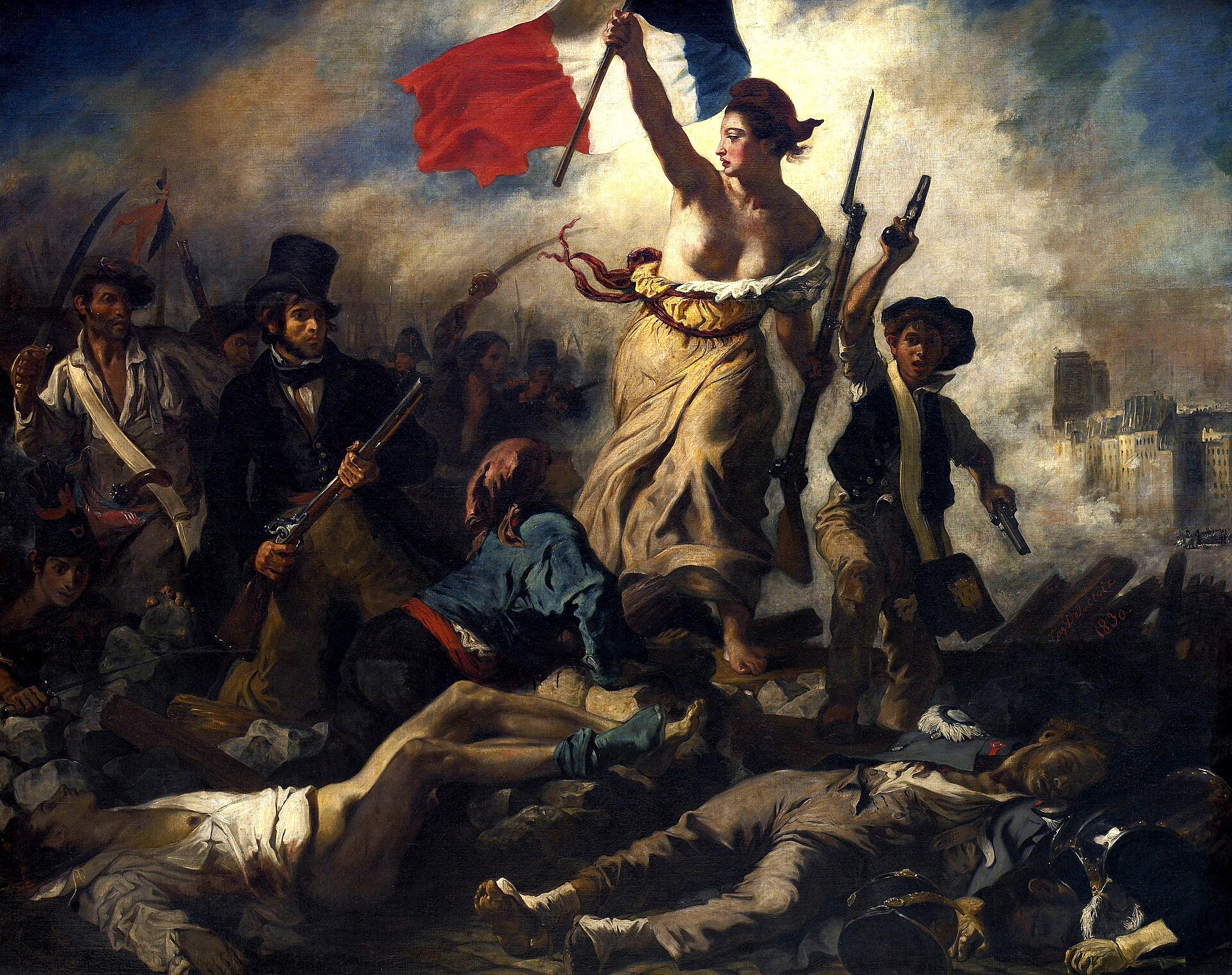 Eugène Delacroix's Liberty Leading the People, 1830, a Romantic work of art. According to a critic, modernism developed out of Romanticism's revolt against the effects of the Industrial Revolution and bourgeois values: "The ground motive of modernism, Graff asserts, was criticism of the nineteenth-century bourgeois social order and its world view [...] the modernists, carrying the torch of romanticism."[a][2][3] While J. M. W. Turner (1775–1851), one of the greatest landscape painters of the 19th century, was a member of the Romantic movement, as "a pioneer in the study of light, colour, and atmosphere", he "anticipated the French Impressionists" and therefore modernism "in breaking down conventional formulas of representation; [though] unlike them, he believed that his works should always express significant historical, mythological, literary, or other narrative themes."[29] 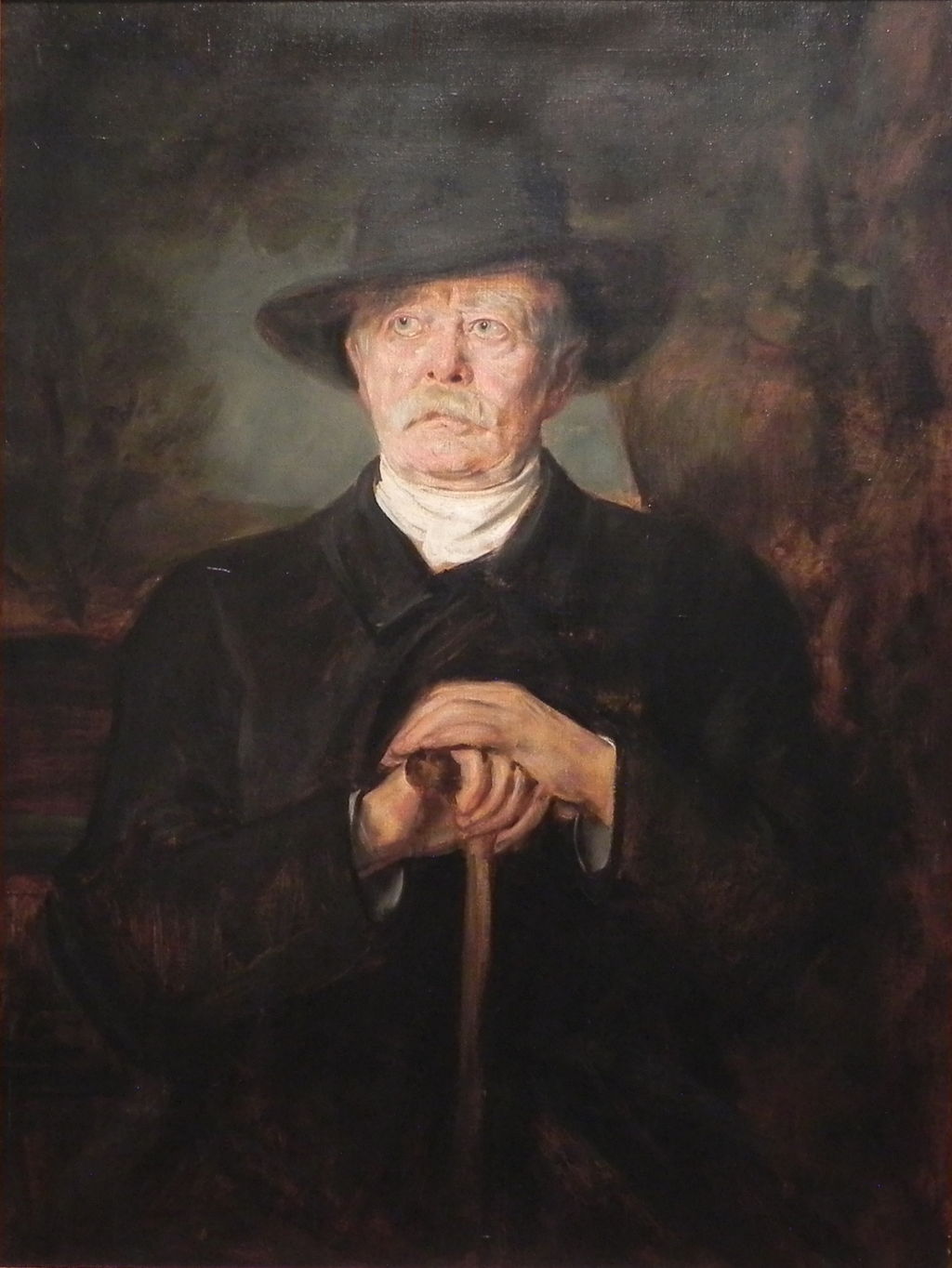 A Realist portrait of Otto von Bismarck. Modernist artists largely rejected realism. The dominant trends of industrial Victorian England were opposed, from about 1850, by the English poets and painters that constituted the Pre-Raphaelite Brotherhood, because of their "opposition to technical skill without inspiration."[30]: 815 They were influenced by the writings of the art critic John Ruskin (1819–1900), who had strong feelings about the role of art in helping to improve the lives of the urban working classes, in the rapidly expanding industrial cities of Britain.[30]: 816 Art critic Clement Greenberg describes the Pre-Raphaelite Brotherhood as proto-Modernists: "There the proto-Modernists were, of all people, the pre-Raphaelites (and even before them, as proto-proto-Modernists, the German Nazarenes). The Pre-Raphaelites actually foreshadowed Manet (1832–1883), with whom Modernist painting most definitely begins. They acted on a dissatisfaction with painting as practiced in their time, holding that its realism wasn't truthful enough."[31] Rationalism has also had opponents in the philosophers Søren Kierkegaard (1813–1855)[32] and later Friedrich Nietzsche (1844–1900), both of whom had significant influence on existentialism and nihilism.[33]: 120 However, the Industrial Revolution continued. Influential innovations included steam-powered industrialization, and especially the development of railways, starting in Britain in the 1830s,[34] and the subsequent advancements in physics, engineering, and architecture associated with this. A major 19th-century engineering achievement was The Crystal Palace, the huge cast-iron and plate glass exhibition hall built for the Great Exhibition of 1851 in London. Glass and iron were used in a similar monumental style in the construction of major railway terminals in London, such as Paddington Station (1854)[35] and King's Cross station (1852).[36] These technological advances led to the building of later structures like the Brooklyn Bridge (1883) and the Eiffel Tower (1889). The latter broke all previous limitations on how tall man-made objects could be. These engineering marvels radically altered the 19th-century urban environment and the daily lives of people. The human experience of time itself was altered, with the development of the electric telegraph from 1837,[37] and the adoption of standard time by British railway companies from 1845, and in the rest of the world over the next fifty years.[38] Despite continuing technological advances, the idea that history and civilization were inherently progressive, and that progress was always good, came under increasing attack in the nineteenth century. Arguments arose that the values of the artist and those of society were not merely different, but that Society was antithetical to Progress, and could not move forward in its present form. Early in the century, the philosopher Schopenhauer (1788–1860) (The World as Will and Representation, 1819) had called into question the previous optimism, and his ideas had an important influence on later thinkers, including Nietzsche.[32] Two of the most significant thinkers of the mid nineteenth century were biologist Charles Darwin (1809–1882), author of On the Origin of Species by Means of Natural Selection (1859), and political scientist Karl Marx (1818–1883), author of Das Kapital (1867). Darwin's theory of evolution by natural selection undermined religious certainty and the idea of human uniqueness. In particular, the notion that human beings were driven by the same impulses as "lower animals" proved to be difficult to reconcile with the idea of an ennobling spirituality.[39] Karl Marx argued that there were fundamental contradictions within the capitalist system, and that the workers were anything but free.[40] 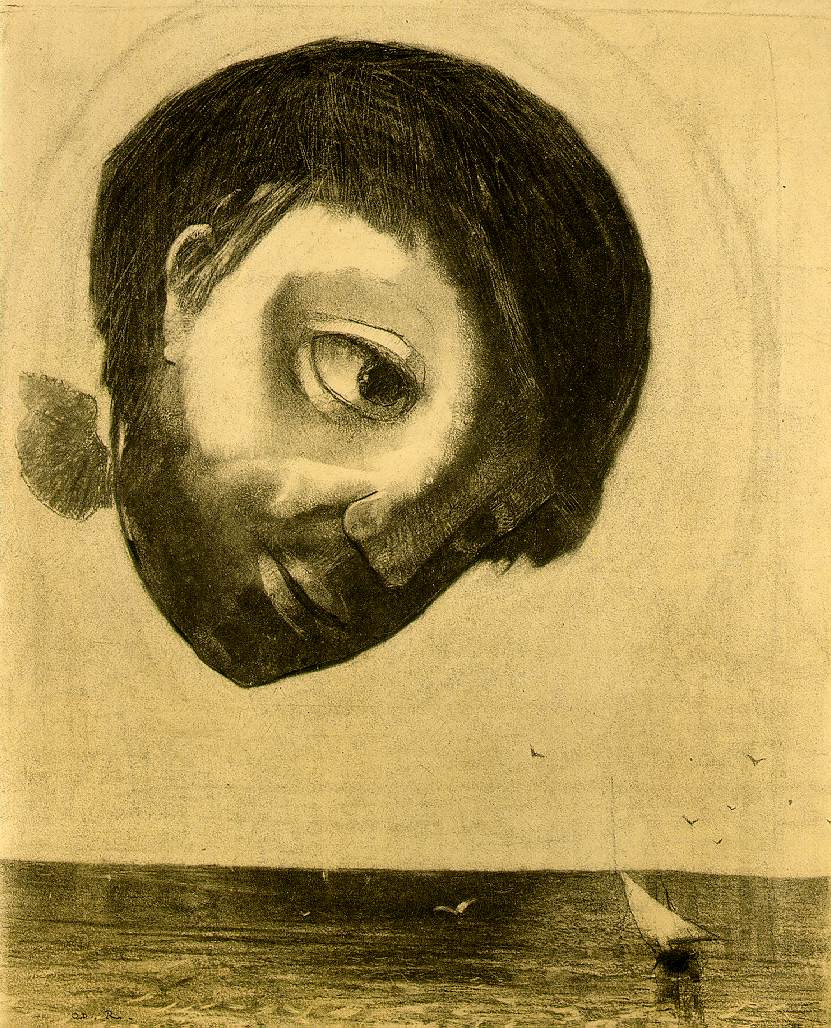 Odilon Redon, Guardian Spirit of the Waters, 1878, charcoal on paper, Art Institute of Chicago The beginnings in the late nineteenth century Historians, and writers in different disciplines, have suggested various dates as starting points for modernism. Historian William Everdell, for example, has argued that modernism began in the 1870s, when metaphorical (or ontological) continuity began to yield to the discrete with mathematician Richard Dedekind's (1831–1916) Dedekind cut, and Ludwig Boltzmann's (1844–1906) statistical thermodynamics.[12] Everdell also thinks modernism in painting began in 1885–1886 with Seurat's Divisionism, the "dots" used to paint A Sunday Afternoon on the Island of La Grande Jatte. On the other hand, visual art critic Clement Greenberg called Immanuel Kant (1724–1804) "the first real Modernist",[41] though he also wrote, "What can be safely called Modernism emerged in the middle of the last century—and rather locally, in France, with Baudelaire in literature and Manet in painting, and perhaps with Flaubert, too, in prose fiction. (It was a while later, and not so locally, that Modernism appeared in music and architecture)."[31] The poet Baudelaire's Les Fleurs du mal (The Flowers of Evil), and Flaubert's novel Madame Bovary were both published in 1857. Baudelaire's essay "The Painter of Modern Life" (1863) inspired young artists to break away from tradition and innovate new ways of portraying their world in art. In the arts and letters, two important approaches developed separately in France, beginning in the 1860s. The first was Impressionism, a school of painting that initially focused on work done, not in studios, but outdoors (en plein air). Impressionist paintings attempted to convey that human beings do not see objects, but instead see light itself. The school gathered adherents despite internal divisions among its leading practitioners, and became increasingly influential. Initially rejected from the most important commercial show of the time, the government-sponsored Paris Salon, the Impressionists organized yearly group exhibitions in commercial venues during the 1870s and 1880s, timing them to coincide with the official Salon. A significant event of 1863 was the Salon des Refusés, created by Emperor Napoleon III to display all of the paintings rejected by the Paris Salon. While most were in standard styles, but by inferior artists, the work of Manet attracted tremendous attention, and opened commercial doors to the movement. The second French school was Symbolism, which literary historians see beginning with Charles Baudelaire (1821–1867), and including the later poets, Arthur Rimbaud (1854–1891) Une Saison en Enfer (A Season in Hell, 1873), Paul Verlaine (1844–1896), Stéphane Mallarmé (1842–1898), and Paul Valéry (1871–1945). The symbolists "stressed the priority of suggestion and evocation over direct description and explicit analogy," and were especially interested in "the musical properties of language."[42] Cabaret, which gave birth to so many of the arts of modernism, including the immediate precursors of film, may be said to have begun in France in 1881 with the opening of the Black Cat in Montmartre, the beginning of the ironic monologue, and the founding of the Society of Incoherent Arts.[43]  Henri Matisse, Le bonheur de vivre, 1905–06, Barnes Foundation, Merion, PA. An early Fauvist masterpiece. Influential in the early days of modernism were the theories of Sigmund Freud (1856–1939). Freud's first major work was Studies on Hysteria (with Josef Breuer, 1895). Central to Freud's thinking is the idea "of the primacy of the unconscious mind in mental life," so that all subjective reality was based on the play of basic drives and instincts, through which the outside world was perceived. Freud's description of subjective states involved an unconscious mind full of primal impulses, and counterbalancing self-imposed restrictions derived from social values.[30]: 538  Henri Matisse, The Dance, 1910, Hermitage Museum, St. Petersburg, Russia. At the beginning of the 20th century Henri Matisse and several other young artists including the pre-cubist Georges Braque, André Derain, Raoul Dufy and Maurice de Vlaminck revolutionized the Paris art world with "wild", multi-colored, expressive landscapes and figure paintings that the critics called Fauvism. Henri Matisse's second version of The Dance signifies a key point in his career and in the development of modern painting.[44] Friedrich Nietzsche (1844–1900) was another major precursor of modernism,[45] with a philosophy in which psychological drives, specifically the "will to power" (Wille zur Macht), was of central importance: "Nietzsche often identified life itself with 'will to power', that is, with an instinct for growth and durability."[46][47] Henri Bergson (1859–1941), on the other hand, emphasized the difference between scientific, clock time and the direct, subjective, human experience of time.[33]: 131 His work on time and consciousness "had a great influence on twentieth-century novelists," especially those modernists who used the stream of consciousness technique, such as Dorothy Richardson, James Joyce, and Virginia Woolf (1882–1941).[48] Also important in Bergson's philosophy was the idea of élan vital, the life force, which "brings about the creative evolution of everything."[33]: 132 His philosophy also placed a high value on intuition, though without rejecting the importance of the intellect.[33]: 132 Important literary precursors of modernism were Fyodor Dostoevsky (1821–1881), who wrote the novels Crime and Punishment (1866) and The Brothers Karamazov (1880);[49] Walt Whitman (1819–1892), who published the poetry collection Leaves of Grass (1855–1891); and August Strindberg (1849–1912), especially his later plays, including the trilogy To Damascus 1898–1901, A Dream Play (1902) and The Ghost Sonata (1907). Henry James has also been suggested as a significant precursor, in a work as early as The Portrait of a Lady (1881).[50] Out of the collision of ideals derived from Romanticism, and an attempt to find a way for knowledge to explain that which was as yet unknown, came the first wave of works in the first decade of the 20th century, which, while their authors considered them extensions of existing trends in art, broke the implicit contract with the general public that artists were the interpreters and representatives of bourgeois culture and ideas. These "Modernist" landmarks include the atonal ending of Arnold Schoenberg's Second String Quartet in 1908, the expressionist paintings of Wassily Kandinsky starting in 1903, and culminating with his first abstract painting and the founding of the Blue Rider group in Munich in 1911, and the rise of fauvism and the inventions of cubism from the studios of Henri Matisse, Pablo Picasso, Georges Braque, and others, in the years between 1900 and 1910. |
初期の歴史 起源  ウジェーヌ・ドラクロワの「民衆を率いる自由」1830年、ロマン主義の作品. ある批評家によれば、モダニズムは産業革命の影響とブルジョワ的価値観に対するロマン主義の反乱から発展した: 「モダニズムの根本的な動機は、19世紀のブルジョア社会秩序とその世界観に対する批判であったとグラフは主張する。19世紀最大の風景画家の一人である ターナー(1775-1851)は、「光、色彩、大気の研究の先駆者」としてロマン主義運動の一員であったが、彼は「従来の表現形式を打破するという点 で、フランスの印象派を先取りし」、ひいてはモダニズムを先取りした[29]。  オットー・フォン・ビスマルクのリアリズム肖像画。モダニズムの芸術家たちは写実主義を大きく否定した。 工業化されたヴィクトリア朝イングランドの支配的な傾向に対して、1850年頃からラファエル前派を構成するイギリスの詩人や画家たちは、「インスピレー ションを伴わない技術的な技巧に反対」していた[30]。 「彼らは美術批評家ジョン・ラスキン(1819-1900)の著作に影響を受けており、彼は急速に拡大するイギリスの工業都市において、都市労働者階級の 生活向上に役立つ芸術の役割について強い感情を抱いていた[30]: 816 美術批評家クレメント・グリーンバーグは、ラファエル前派同胞団をプロト・モダニストと評している: 「そこでのプロト・モダニストとは、他でもない、ラファエル前派であった(そしてさらにその前のプロト・プロト・モダニストとしては、ドイツのナザレ派で あった)。ラファエル前派は、実はマネ(1832-1883)の前身であり、モダニズム絵画はマネから始まる。ラファエル前派は、当時行われていた絵画に 対する不満から行動し、その写実主義が真実味に欠けるとしていた: 120 しかし、産業革命は続いた。影響力のある技術革新としては、蒸気を動力とする工業化、特に1830年代にイギリスで始まった鉄道の発達[34]、それに伴 う物理学、工学、建築学の進歩が挙げられる。19世紀の主要な工学的業績は、1851年にロンドンで開催された万国博覧会のために建設された巨大な鋳鉄と 板ガラスの展示ホールであるクリスタル・パレスであった。ガラスと鉄は、パディントン駅(1854年)[35]やキングス・クロス駅(1852年)といっ たロンドンの主要な鉄道ターミナルの建設においても、同様の記念碑的スタイルで使用された[36]。エッフェル塔は、人工物の高さに関するそれまでの制限 をすべて打ち破った。これらの工学的驚異は、19世紀の都市環境と人々の日常生活を根本的に変えた。1837年からの電気電信の開発[37]、1845年 からのイギリスの鉄道会社による標準時の採用、そしてその後の50年間にわたる世界の他の地域での標準時の採用によって、人間の時間体験そのものが変化し た[38]。 技術の進歩が続いていたにもかかわらず、歴史と文明は本質的に進歩的であり、進歩は常に善であるという考え方は、19世紀になるとますます攻撃されるよう になった。芸術家の価値観と社会の価値観は単に異なっているだけでなく、社会は進歩とは相反するものであり、現在の形では前進できないという主張が生まれ た。世紀初頭、哲学者ショーペンハウアー(1788-1860)(『意志と表象としての世界』1819年)はそれまでの楽観主義に疑問を投げかけ、彼の考 えはニーチェを含む後の思想家たちに重要な影響を与えた。 [32]19世紀半ばの最も重要な2人の思想家は、『自然淘汰による種の起源』(1859年)の著者である生物学者チャールズ・ダーウィン(1809- 1882年)と、『資本論』(1867年)の著者である政治学者カール・マルクス(1818-1883年)であった。ダーウィンの自然淘汰による進化論 は、宗教的な確信と人間の独自性という考えを根底から覆した。特に、人間は「下等動物」と同じ衝動に突き動かされているという考え方は、崇高な精神性の考 え方と調和させることが困難であることが判明した[39]。カール・マルクスは、資本主義システムの中には根本的な矛盾があり、労働者は自由であるとは言 えないと主張した[40]。  オディロン・ルドン《水の守護霊》1878年、紙に木炭、シカゴ美術館蔵 19世紀後半の始まり 歴史家やさまざまな分野の作家は、モダニズムの出発点としてさまざまな時期を提示してきた。例えば、歴史家のウィリアム・エヴァーデルは、数学者リチャー ド・デデキント(1831-1916)のデデキント・カットやルートヴィヒ・ボルツマン(1844-1906)の統計熱力学によって、隠喩的な(あるいは 存在論的な)連続性が離散的なものに屈し始めた1870年代にモダニズムが始まったと主張している。 [12] エヴァーデルはまた、絵画におけるモダニズムは、1885年から1886年にかけて、スーラが『ラ・グランド・ジャット島の日曜日の午後』を描くために用 いた「点」による分割主義から始まったと考えている。一方、視覚芸術批評家のクレメント・グリーンバーグは、イマニュエル・カント(1724-1804) を「最初の真のモダニスト」と呼んだが[41]、彼はまた、「モダニズムと安全に呼べるものは、前世紀の中頃に、むしろフランスで、文学のボードレールや 絵画のマネ、そしておそらく散文小説のフローベールによって出現した。(詩人ボードレールの『悪の華』(Les Fleurs du mal)とフローベールの小説『ボヴァリー夫人』(Madame Bovary)はともに1857年に出版された。ボードレールのエッセイ『現代生活の画家』(1863年)は、若い芸術家たちに伝統から脱却し、芸術で自 分たちの世界を描く新しい方法を革新するよう促した。 芸術と文字の分野では、1860年代からフランスで2つの重要なアプローチが別々に発展した。ひとつは印象派で、当初はアトリエではなく屋外(en plein air)での制作に重点を置いていた。印象派の絵画は、人間が物を見るのではなく、光そのものを見ていることを伝えようとした。この一派は、主要な画家た ちの内部分裂にもかかわらず支持者を集め、影響力を増していった。当初、政府主催のパリ・サロンという当時最も重要な商業的展覧会から退けられていた印象 派は、1870年代から1880年代にかけて、公式のサロンと時期を合わせ、商業的な会場で毎年グループ展を開催した。1863年の重要なイベントは、皇 帝ナポレオン3世がパリ・サロンで却下された絵画を展示するために創設した「拒絶のサロン」だった。ほとんどの作品は標準的なスタイルであったが、劣った 画家たちによるものであったが、マネの作品は大きな注目を集め、この運動への商業的な扉を開いた。第二のフランス派は象徴主義で、文学史家はシャルル・ ボードレール(1821-1867)に始まり、アルチュール・ランボー(1854-1891)『地獄の季節』(1873)、ポール・ヴェルレーヌ (1844-1896)、ステファン・マラルメ(1842-1898)、ポール・ヴァレリー(1871-1945)ら後期の詩人を含むと見ている。象徴主 義者たちは「直接的な描写や明示的な類推よりも暗示や喚起の優先を強調」し、特に「言語の音楽的特性」に関心を寄せていた[42]。 キャバレーは、モンマルトルの黒猫の開店、皮肉な一人芝居の始まり、支離滅裂な芸術協会の設立とともに、1881年にフランスで始まったと言えるかもしれ ない[43]。  アンリ・マティス《Le bonheur de vivre》1905-06年、バーンズ財団、ペンシルベニア州メリオン。フォーヴィスム初期の傑作。 モダニズムの初期に影響を与えたのは、ジークムント・フロイト(1856-1939)の理論である。フロイトの最初の主著は『ヒステリー研究』(ヨーゼ フ・ブロイヤーとの共著、1895年)である。フロイトの考え方の中心は、「精神生活における無意識の優位性」という考え方であり、すべての主観的現実は 基本的な衝動と本能の戯れに基づいており、それを通して外界が知覚されるというものであった。フロイトの主観的状態に関する記述は、原始的な衝動に満ちた 無意識の心と、社会的価値観に由来する自己に課された制限の均衡をとることとを含んでいた[30]: 538  アンリ・マティス《ダンス》1910年、エルミタージュ美術館、サンクトペテルブルク、ロシア。20世紀初頭、アンリ・マティスをはじめ、キュービズム以 前のジョルジュ・ブラック、アンドレ・ドラン、ラウル・デュフィ、モーリス・ド・ヴラマンクら数人の若い芸術家たちは、批評家たちがフォーヴィスムと呼ん だ「野性的」で多色的、表現力豊かな風景画や人物画でパリ画壇に革命を起こした。アンリ・マティスの『ダンス』の第2版は、彼のキャリアと近代絵画の発展 における重要なポイントを意味する[44]。 フリードリヒ・ニーチェ(1844-1900)は、モダニズムのもう一人の主要な先駆者であり[45]、心理的衝動、特に「力への意志」(Wille zur Macht)が中心的な重要性を持つ哲学者であった: ニーチェはしばしば生そのものを「力への意志」、つまり成長と耐久性への本能と同一視していた」[46][47]。一方、アンリ・ベルクソン(1859- 1941)は科学的な時計の時間と直接的で主観的な人間の時間体験との違いを強調していた[33]: 131 時間と意識に関する彼の研究は「20世紀の小説家たち、特にドロシー・リチャードソン、ジェイムズ・ジョイス、ヴァージニア・ウルフ(1882- 1941)といった意識の流れの技法を用いたモダニストたちに大きな影響を与えた」[48]: 132 彼の哲学はまた、知性の重要性を否定することなく、直観に高い価値を置いていた[33]: 132 モダニズムの重要な文学的先駆者は、小説『罪と罰』(1866年)と『カラマーゾフの兄弟』(1880年)を書いたフョードル・ドストエフスキー (1821-1881年)である; [49]詩集『草の葉』(1855-1891)を出版したウォルト・ホイットマン(1819-1892)、アウグスト・ストリンドベリ(1849- 1912)、特に『ダマスカスへ』(1898-1901)、『夢の劇』(1902)、『ゴースト・ソナタ』(1907)の三部作を含む晩年の戯曲。ヘン リー・ジェイムズもまた、『ある貴婦人の肖像』(1881年)という初期の作品において、重要な先駆者として示唆されている[50]。 ロマン主義から派生した理想と、まだ未知であったものを説明する知識を見出そうとする試みの衝突から、20世紀の最初の10年間に最初の作品の波が押し寄 せた。これらの作品は、作者たちが既存の芸術の傾向の延長線上にあると考える一方で、芸術家はブルジョア文化や思想の解釈者であり代表者であるという一般 大衆との暗黙の契約を破った。これらの「モダニズム」のランドマークには、1908年のアーノルド・シェーンベルクの弦楽四重奏曲第2番の無調の終結、 1903年に始まったワシリー・カンディンスキーの表現主義絵画、1911年の彼の最初の抽象絵画とミュンヘンでの「青い騎手」グループの創設に至るま で、1900年から1910年にかけてのアンリ・マティス、パブロ・ピカソ、ジョルジュ・ブラックらのアトリエからのフォーヴィスムの台頭とキュビスムの 発明が含まれる。 |
Main period, 1900-1930; 1930-1945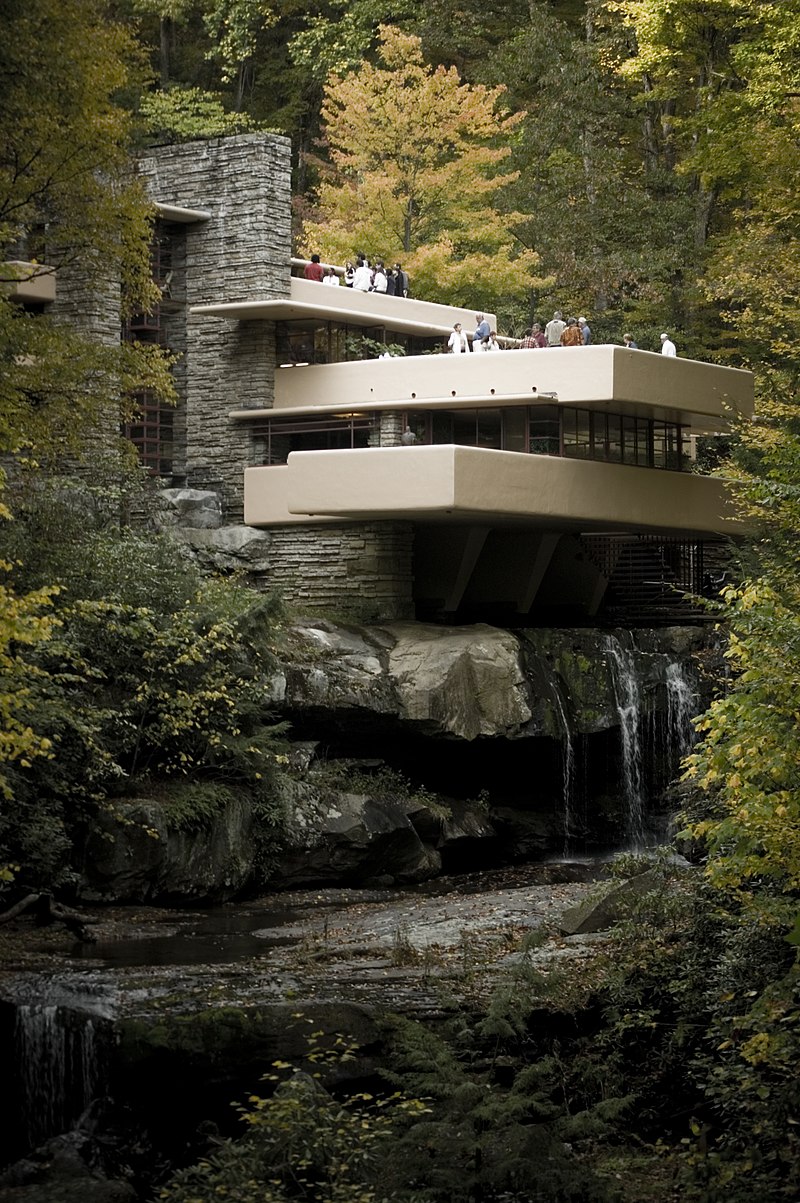 Frank Lloyd Wright, Fallingwater, Mill Run, Pennsylvania (1937). Fallingwater was one of Wright's most famous private residences (completed 1937). Early 20th century to 1930 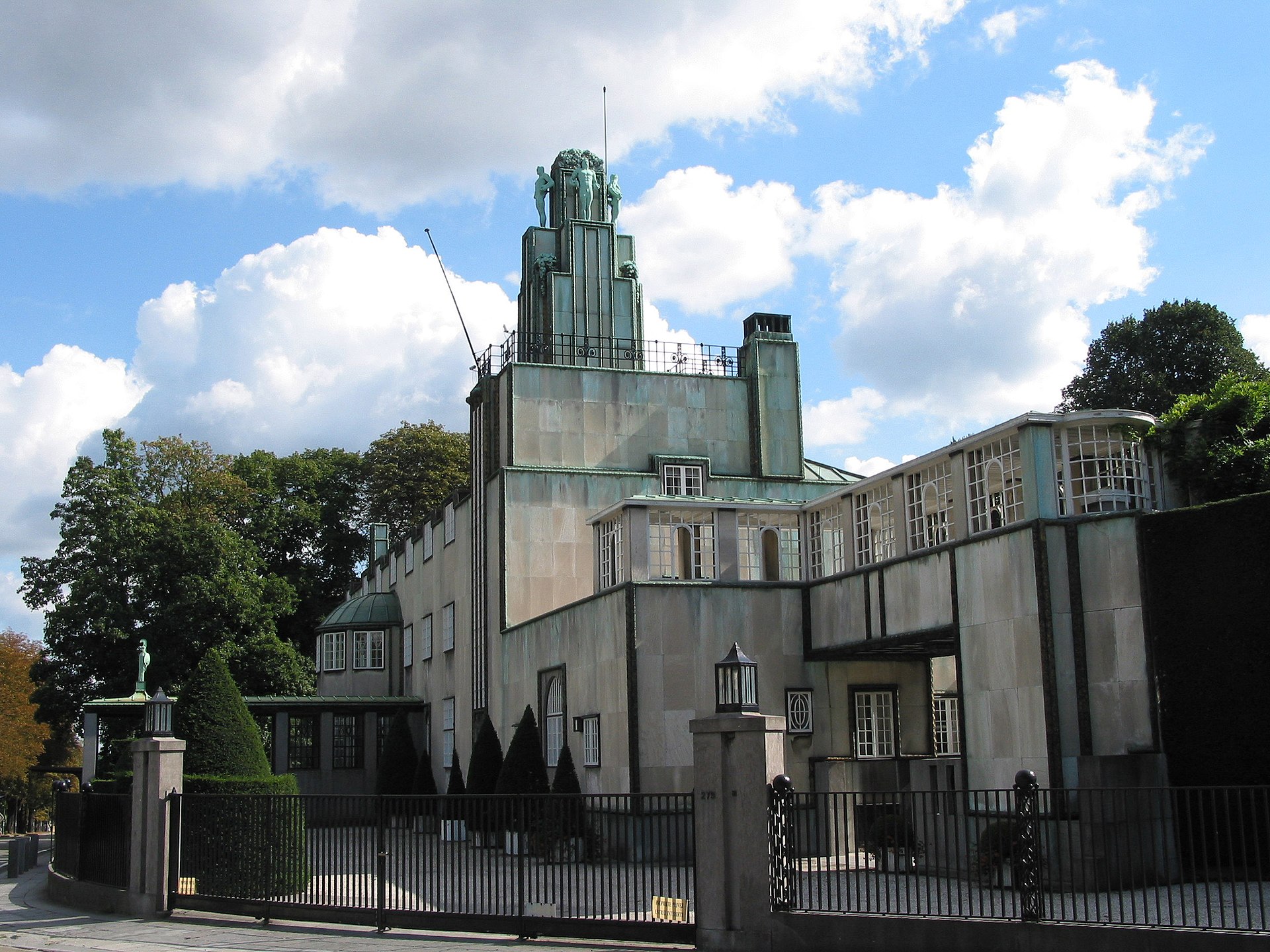 Palais Stoclet (1905–1911) by modernist architect Josef Hoffmann 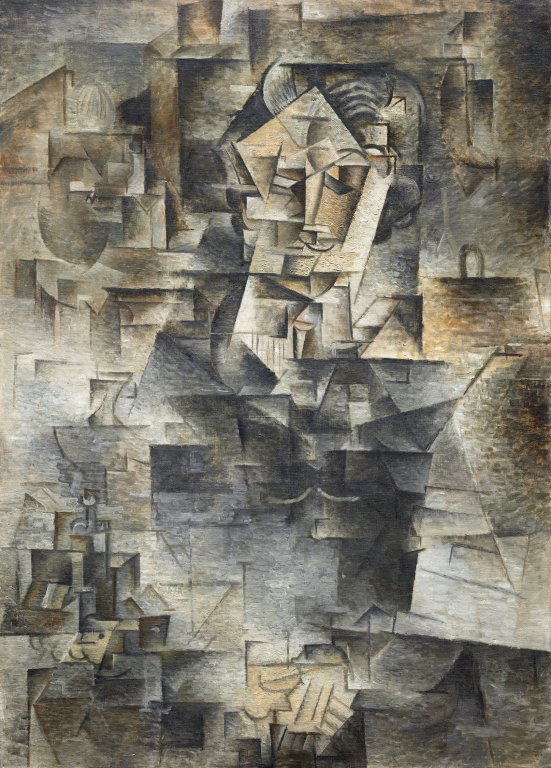 Pablo Picasso, Portrait of Daniel-Henry Kahnweiler, 1910, Art Institute of Chicago An important aspect of modernism is how it relates to tradition through its adoption of techniques like reprise, incorporation, rewriting, recapitulation, revision and parody in new forms.[b][c] 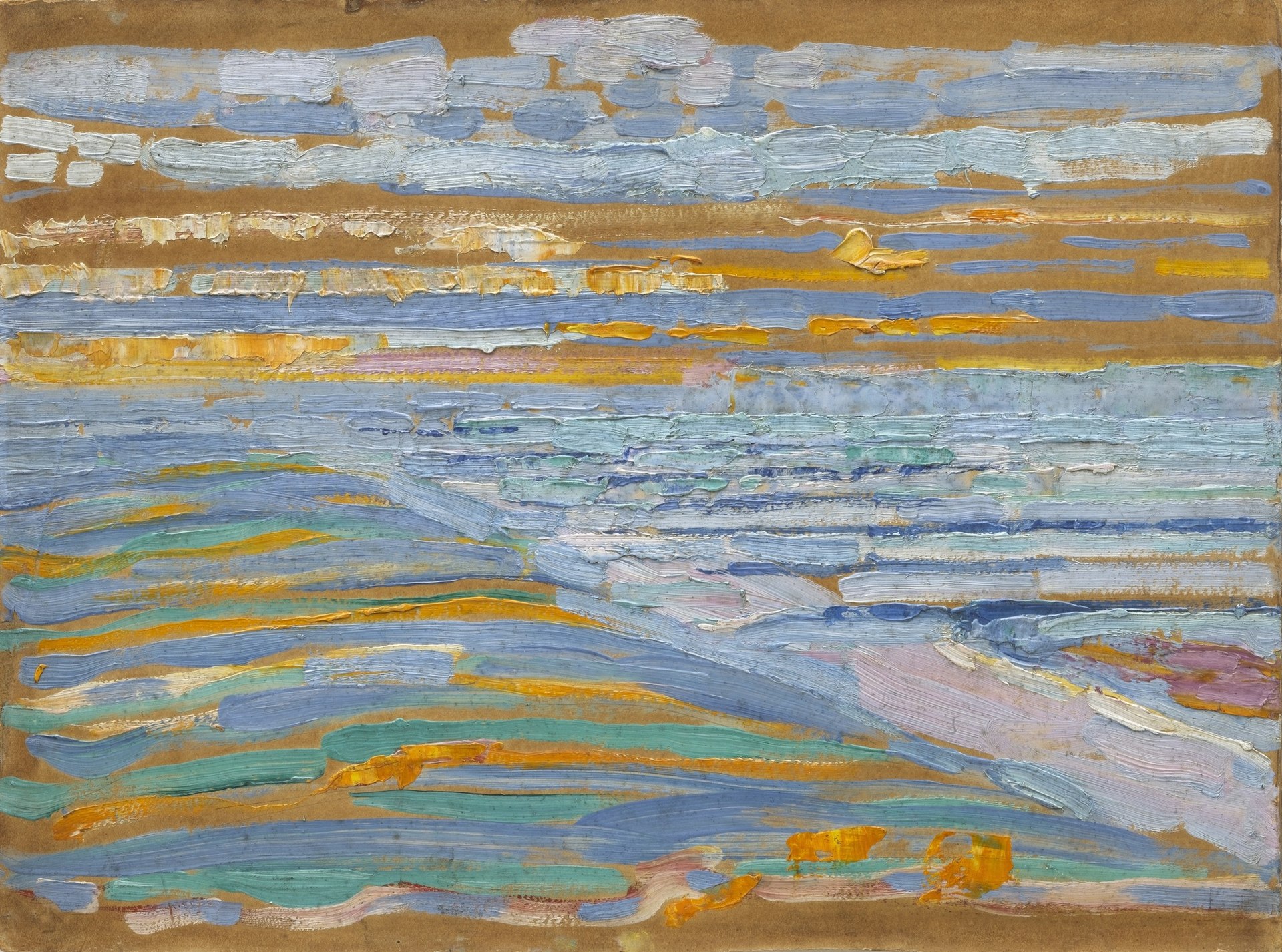 Piet Mondrian, View from the Dunes with Beach and Piers, Domburg, 1909, oil and pencil on cardboard, Museum of Modern Art, New York City  The Museo Nacional Centro de Arte Reina Sofía (MNCARS) is Spain's national museum of 20th-century art, located in Madrid. The photo shows the old building with the addition of one of the contemporary glass towers to the exterior by Ian Ritchie Architects with the closeup of the modern art tower. T. S. Eliot made significant comments on the relation of the artist to tradition, including: "[W]e shall often find that not only the best, but the most individual parts of [a poet's] work, may be those in which the dead poets, his ancestors, assert their immortality most vigorously."[53] However, the relationship of Modernism with tradition was complex, as literary scholar Peter Childs indicates: "There were paradoxical if not opposed trends towards revolutionary and reactionary positions, fear of the new and delight at the disappearance of the old, nihilism and fanatical enthusiasm, creativity and despair."[4] An example of how Modernist art can be both revolutionary and yet be related to past tradition, is the music of the composer Arnold Schoenberg. On the one hand Schoenberg rejected traditional tonal harmony, the hierarchical system of organizing works of music that had guided music making for at least a century and a half. He believed he had discovered a wholly new way of organizing sound, based in the use of twelve-note rows. Yet while this was indeed wholly new, its origins can be traced back in the work of earlier composers, such as Franz Liszt,[54] Richard Wagner, Gustav Mahler, Richard Strauss and Max Reger.[55][56] Schoenberg also wrote tonal music throughout his career. In the world of art, in the first decade of the 20th century, young painters such as Pablo Picasso and Henri Matisse were causing a shock with their rejection of traditional perspective as the means of structuring paintings,[57][58] though the impressionist Monet had already been innovative in his use of perspective.[59] In 1907, as Picasso was painting Les Demoiselles d'Avignon, Oskar Kokoschka was writing Mörder, Hoffnung der Frauen (Murderer, Hope of Women), the first Expressionist play (produced with scandal in 1909), and Arnold Schoenberg was composing his String Quartet No.2 in F sharp minor (1908), his first composition without a tonal centre. A primary influence that led to Cubism was the representation of three-dimensional form in the late works of Paul Cézanne, which were displayed in a retrospective at the 1907 Salon d'Automne.[60] In Cubist artwork, objects are analyzed, broken up and reassembled in an abstracted form; instead of depicting objects from one viewpoint, the artist depicts the subject from a multitude of viewpoints to represent the subject in a greater context.[61] Cubism was brought to the attention of the general public for the first time in 1911 at the Salon des Indépendants in Paris (held 21 April – 13 June). Jean Metzinger, Albert Gleizes, Henri Le Fauconnier, Robert Delaunay, Fernand Léger and Roger de La Fresnaye were shown together in Room 41, provoking a 'scandal' out of which Cubism emerged and spread throughout Paris and beyond. Also in 1911, Kandinsky painted Bild mit Kreis (Picture with a Circle), which he later called the first abstract painting.[62]: 167 In 1912, Metzinger and Gleizes wrote the first (and only) major Cubist manifesto, Du "Cubisme", published in time for the Salon de la Section d'Or, the largest Cubist exhibition to date. In 1912 Metzinger painted and exhibited his enchanting La Femme au Cheval (Woman with a Horse) and Danseuse au Café (Dancer in a Café). Albert Gleizes painted and exhibited his Les Baigneuses (The Bathers) and his monumental Le Dépiquage des Moissons (Harvest Threshing). This work, along with La Ville de Paris (City of Paris) by Robert Delaunay, was the largest and most ambitious Cubist painting undertaken during the pre-War Cubist period.[63] In 1905, a group of four German artists, led by Ernst Ludwig Kirchner, formed Die Brücke (the Bridge) in the city of Dresden. This was arguably the founding organization for the German Expressionist movement, though they did not use the word itself. A few years later, in 1911, a like-minded group of young artists formed Der Blaue Reiter (The Blue Rider) in Munich. The name came from Wassily Kandinsky's Der Blaue Reiter painting of 1903. Among their members were Kandinsky, Franz Marc, Paul Klee, and August Macke. However, the term "Expressionism" did not firmly establish itself until 1913.[62]: 274 Though initially mainly a German artistic movement,[f] most predominant in painting, poetry and the theatre between 1910 and 1930, most precursors of the movement were not German. Furthermore, there have been expressionist writers of prose fiction, as well as non-German speaking expressionist writers, and, while the movement had declined in Germany with the rise of Adolf Hitler in the 1930s, there were subsequent expressionist works. 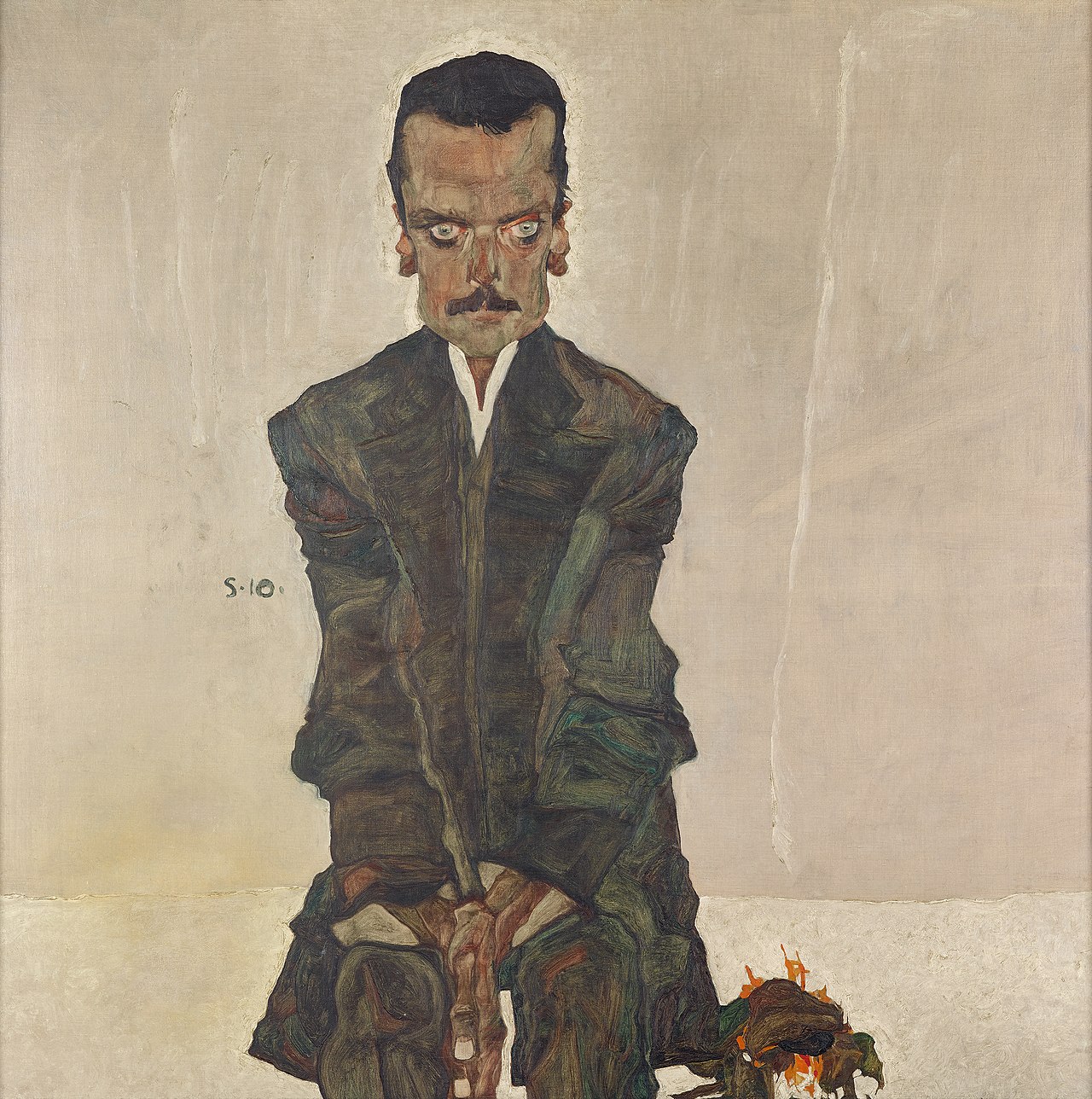 Portrait of Eduard Kosmack (1910) by Egon Schiele 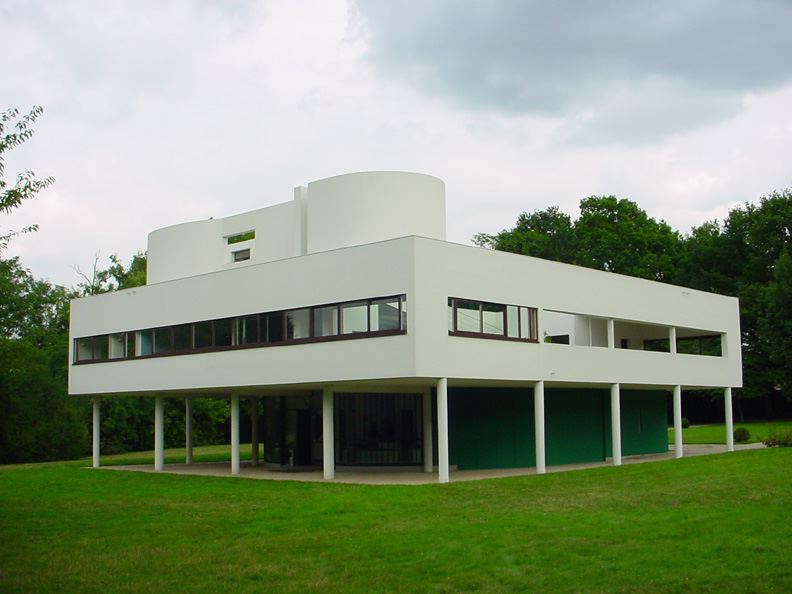 Le Corbusier, The Villa Savoye in Poissy (1928–1931) Expressionism is notoriously difficult to define, in part because it "overlapped with other major 'isms' of the modernist period: with Futurism, Vorticism, Cubism, Surrealism and Dada."[66] Richard Murphy also comments: "the search for an all-inclusive definition is problematic to the extent that the most challenging expressionists" such as the novelist Franz Kafka, poet Gottfried Benn, and novelist Alfred Döblin were simultaneously the most vociferous anti-expressionists.[67]: 43 What, however, can be said, is that it was a movement that developed in the early 20th century mainly in Germany in reaction to the dehumanizing effect of industrialization and the growth of cities, and that "one of the central means by which expressionism identifies itself as an avant-garde movement, and by which it marks its distance to traditions and the cultural institution as a whole is through its relationship to realism and the dominant conventions of representation."[67]: 43 More explicitly: that the expressionists rejected the ideology of realism.[67]: 43–48 [68] There was a concentrated Expressionist movement in early 20th century German theatre, of which Georg Kaiser and Ernst Toller were the most famous playwrights. Other notable Expressionist dramatists included Reinhard Sorge, Walter Hasenclever, Hans Henny Jahnn, and Arnolt Bronnen. They looked back to Swedish playwright August Strindberg and German actor and dramatist Frank Wedekind as precursors of their dramaturgical experiments. Oskar Kokoschka's Murderer, the Hope of Women was the first fully Expressionist work for the theatre, which opened on 4 July 1909 in Vienna.[69] The extreme simplification of characters to mythic types, choral effects, declamatory dialogue and heightened intensity would become characteristic of later Expressionist plays. The first full-length Expressionist play was The Son by Walter Hasenclever, which was published in 1914 and first performed in 1916.[70] Futurism is yet another modernist movement.[71] In 1909, the Parisian newspaper Le Figaro published F. T. Marinetti's first manifesto. Soon afterwards a group of painters (Giacomo Balla, Umberto Boccioni, Carlo Carrà, Luigi Russolo, and Gino Severini) co-signed the Futurist Manifesto. Modeled on Marx and Engels' famous "Communist Manifesto" (1848), such manifestoes put forward ideas that were meant to provoke and to gather followers. However, arguments in favor of geometric or purely abstract painting were, at this time, largely confined to "little magazines" which had only tiny circulations. Modernist primitivism and pessimism were controversial, and the mainstream in the first decade of the 20th century was still inclined towards a faith in progress and liberal optimism. 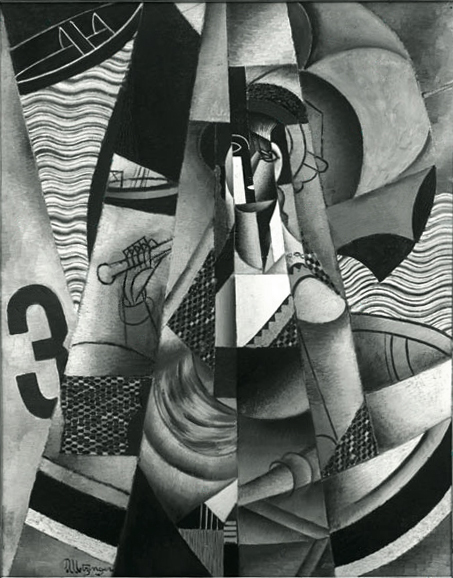 Jean Metzinger, 1913, En Canot (Im Boot), oil on canvas, 146 x 114 cm (57.5 in × 44.9 in), exhibited at Moderni Umeni, S.V.U. Mánes, Prague, 1914, acquired in 1916 by Georg Muche at the Galerie Der Sturm, confiscated by the Nazis circa 1936–1937, displayed at the Degenerate Art show in Munich, and missing ever since.[72] Abstract artists, taking as their examples the impressionists, as well as Paul Cézanne (1839–1906) and Edvard Munch (1863–1944), began with the assumption that color and shape, not the depiction of the natural world, formed the essential characteristics of art.[73] Western art had been, from the Renaissance up to the middle of the 19th century, underpinned by the logic of perspective and an attempt to reproduce an illusion of visible reality. The arts of cultures other than the European had become accessible and showed alternative ways of describing visual experience to the artist. By the end of the 19th century many artists felt a need to create a new kind of art which would encompass the fundamental changes taking place in technology, science and philosophy. The sources from which individual artists drew their theoretical arguments were diverse, and reflected the social and intellectual preoccupations in all areas of Western culture at that time.[74] Wassily Kandinsky, Piet Mondrian, and Kazimir Malevich all believed in redefining art as the arrangement of pure color. The use of photography, which had rendered much of the representational function of visual art obsolete, strongly affected this aspect of modernism.[75] Modernist architects and designers, such as Frank Lloyd Wright[76] and Le Corbusier,[77] believed that new technology rendered old styles of building obsolete. Le Corbusier thought that buildings should function as "machines for living in", analogous to cars, which he saw as machines for traveling in.[78] Just as cars had replaced the horse, so modernist design should reject the old styles and structures inherited from Ancient Greece or from the Middle Ages. Following this machine aesthetic, modernist designers typically rejected decorative motifs in design, preferring to emphasize the materials used and pure geometrical forms.[79] The skyscraper is the archetypal modernist building, and the Wainwright Building, a 10-story office building built 1890–91, in St. Louis, Missouri, United States, is among the first skyscrapers in the world.[80] Ludwig Mies van der Rohe's Seagram Building in New York (1956–1958) is often regarded as the pinnacle of this modernist high-rise architecture.[81] Many aspects of modernist design still persist within the mainstream of contemporary architecture, though previous dogmatism has given way to a more playful use of decoration, historical quotation, and spatial drama. 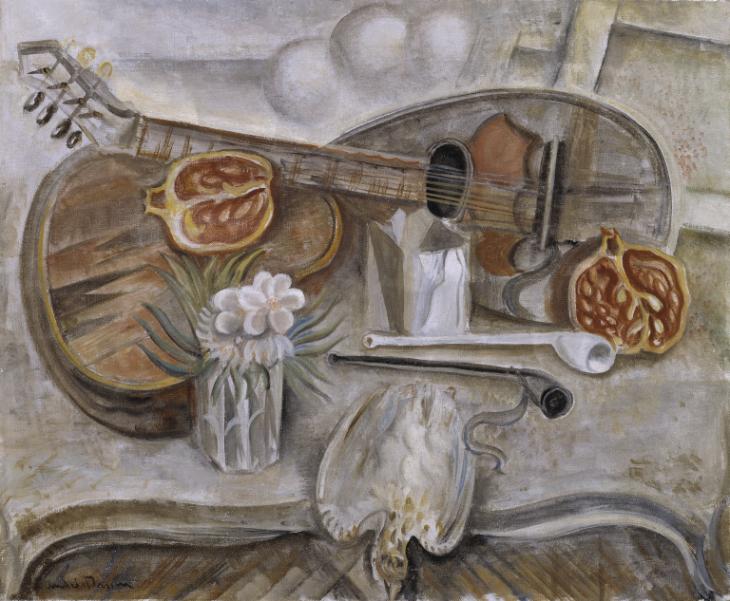 André Masson, Pedestal Table in the Studio 1922, early example of Surrealism In 1913—which was the year of philosopher Edmund Husserl's Ideas, physicist Niels Bohr's quantized atom, Ezra Pound's founding of imagism, the Armory Show in New York, and in Saint Petersburg the "first futurist opera", Mikhail Matyushin's Victory over the Sun—another Russian composer, Igor Stravinsky, composed The Rite of Spring, a ballet that depicts human sacrifice, and has a musical score full of dissonance and primitive rhythm. This caused uproar on its first performance in Paris. At this time though modernism was still "progressive", increasingly it saw traditional forms and traditional social arrangements as hindering progress, and was recasting the artist as a revolutionary, engaged in overthrowing rather than enlightening society. Also in 1913 a less violent event occurred in France with the publication of the first volume of Marcel Proust's important novel sequence À la recherche du temps perdu (1913–1927) (In Search of Lost Time). This is often presented as an early example of a writer using the stream-of-consciousness technique, but Robert Humphrey comments that Proust "is concerned only with the reminiscent aspect of consciousness" and that he "was deliberately recapturing the past for the purpose of communicating; hence he did not write a stream-of-consciousness novel."[82] Stream of consciousness was an important modernist literary innovation, and it has been suggested that Arthur Schnitzler (1862–1931) was the first to make full use of it in his short story "Leutnant Gustl" ("None but the Brave") (1900).[83] Dorothy Richardson was the first English writer to use it, in the early volumes of her novel sequence Pilgrimage (1915–1967).[g] The other modernist novelists that are associated with the use of this narrative technique include James Joyce in Ulysses (1922) and Italo Svevo in La coscienza di Zeno (1923).[85] However, with the coming of the Great War of 1914–1918 and the Russian Revolution of 1917, the world was drastically changed and doubt cast on the beliefs and institutions of the past. The failure of the previous status quo seemed self-evident to a generation that had seen millions die fighting over scraps of earth: prior to 1914 it had been argued that no one would fight such a war, since the cost was too high. The birth of a machine age which had made major changes in the conditions of daily life in the 19th century now had radically changed the nature of warfare. The traumatic nature of recent experience altered basic assumptions, and realistic depiction of life in the arts seemed inadequate when faced with the fantastically surreal nature of trench warfare. The view that mankind was making steady moral progress now seemed ridiculous in the face of the senseless slaughter, described in works such as Erich Maria Remarque's novel All Quiet on the Western Front (1929). Therefore, modernism's view of reality, which had been a minority taste before the war, became more generally accepted in the 1920s. In literature and visual art some modernists sought to defy expectations mainly in order to make their art more vivid, or to force the audience to take the trouble to question their own preconceptions. This aspect of modernism has often seemed a reaction to consumer culture, which developed in Europe and North America in the late 19th century. Whereas most manufacturers try to make products that will be marketable by appealing to preferences and prejudices, high modernists rejected such consumerist attitudes in order to undermine conventional thinking. The art critic Clement Greenberg expounded this theory of modernism in his essay Avant-Garde and Kitsch.[86] Greenberg labeled the products of consumer culture "kitsch", because their design aimed simply to have maximum appeal, with any difficult features removed. For Greenberg, modernism thus formed a reaction against the development of such examples of modern consumer culture as commercial popular music, Hollywood, and advertising. Greenberg associated this with the revolutionary rejection of capitalism. Some modernists saw themselves as part of a revolutionary culture that included political revolution. In Russia after the 1917 Revolution there was indeed initially a burgeoning of avant-garde cultural activity, which included Russian Futurism. However others rejected conventional politics as well as artistic conventions, believing that a revolution of political consciousness had greater importance than a change in political structures. But many modernists saw themselves as apolitical. Others, such as T. S. Eliot, rejected mass popular culture from a conservative position. Some even argue that modernism in literature and art functioned to sustain an elite culture which excluded the majority of the population.[86] Surrealism, which originated in the early 1920s, came to be regarded by the public as the most extreme form of modernism, or "the avant-garde of Modernism".[87] The word "surrealist" was coined by Guillaume Apollinaire and first appeared in the preface to his play Les Mamelles de Tirésias, which was written in 1903 and first performed in 1917. Major surrealists include Paul Éluard, Robert Desnos,[88] Max Ernst, Hans Arp, Antonin Artaud, Raymond Queneau, Joan Miró, and Marcel Duchamp.[89] By 1930, Modernism had won a place in the establishment, including the political and artistic establishment, although by this time Modernism itself had changed. Modernism continues: 1930–1945 Modernism continued to evolve during the 1930s. Between 1930 and 1932 composer Arnold Schoenberg worked on Moses und Aron, one of the first operas to make use of the twelve-tone technique,[90] Pablo Picasso painted in 1937 Guernica, his cubist condemnation of fascism, while in 1939 James Joyce pushed the boundaries of the modern novel further with Finnegans Wake. Also by 1930 Modernism began to influence mainstream culture, so that, for example, The New Yorker magazine began publishing work, influenced by Modernism, by young writers and humorists like Dorothy Parker,[91] Robert Benchley, E. B. White, S. J. Perelman, and James Thurber, amongst others.[92] Perelman is highly regarded for his humorous short stories that he published in magazines in the 1930s and 1940s, most often in The New Yorker, which are considered to be the first examples of surrealist humor in America.[93] Modern ideas in art also began to appear more frequently in commercials and logos, an early example of which, from 1916, is the famous London Underground logo designed by Edward Johnston.[94] One of the most visible changes of this period was the adoption of new technologies into daily life of ordinary people in Western Europe and North America. Electricity, the telephone, the radio, the automobile—and the need to work with them, repair them and live with them—created social change. The kind of disruptive moment that only a few knew in the 1880s became a common occurrence. For example, the speed of communication reserved for the stock brokers of 1890 became part of family life, at least in middle class North America. Associated with urbanization and changing social mores also came smaller families and changed relationships between parents and their children.  London Underground logo designed by Edward Johnston. This is the modern version (with minor modifications) of one that was first used in 1916. Another strong influence at this time was Marxism. After the generally primitivistic/irrationalist aspect of pre-World War I Modernism (which for many modernists precluded any attachment to merely political solutions) and the neoclassicism of the 1920s (as represented most famously by T. S. Eliot and Igor Stravinsky—which rejected popular solutions to modern problems), the rise of fascism, the Great Depression, and the march to war helped to radicalise a generation. Bertolt Brecht, W. H. Auden, André Breton, Louis Aragon and the philosophers Antonio Gramsci and Walter Benjamin are perhaps the most famous exemplars of this Modernist form of Marxism. There were, however, also modernists explicitly of 'the right', including Salvador Dalí, Wyndham Lewis, T. S. Eliot, Ezra Pound, the Dutch author Menno ter Braak and others.[95] Significant Modernist literary works continued to be created in the 1920s and 1930s, including further novels by Marcel Proust, Virginia Woolf, Robert Musil, and Dorothy Richardson. The American Modernist dramatist Eugene O'Neill's career began in 1914, but his major works appeared in the 1920s, 1930s and early 1940s. Two other significant Modernist dramatists writing in the 1920s and 1930s were Bertolt Brecht and Federico García Lorca. D. H. Lawrence's Lady Chatterley's Lover was privately published in 1928, while another important landmark for the history of the modern novel came with the publication of William Faulkner's The Sound and the Fury in 1929. In the 1930s, in addition to further major works by Faulkner, Samuel Beckett published his first major work, the novel Murphy (1938). Then in 1939 James Joyce's Finnegans Wake appeared. This is written in a largely idiosyncratic language, consisting of a mixture of standard English lexical items and neologistic multilingual puns and portmanteau words, which attempts to recreate the experience of sleep and dreams.[96] In poetry T. S. Eliot, E. E. Cummings, and Wallace Stevens were writing from the 1920s until the 1950s. While Modernist poetry in English is often viewed as an American phenomenon, with leading exponents including Ezra Pound, T. S. Eliot, Marianne Moore, William Carlos Williams, H.D., and Louis Zukofsky, there were important British Modernist poets, including David Jones, Hugh MacDiarmid, Basil Bunting, and W. H. Auden. European Modernist poets include Federico García Lorca, Anna Akhmatova, Constantine Cavafy, and Paul Valéry. James Joyce statue on North Earl Street, Dublin, by Marjorie FitzGibbon The Modernist movement continued during this period in Soviet Russia. In 1930 composer Dimitri Shostakovich's (1906–1975) opera The Nose was premiered, in which he uses a montage of different styles, including folk music, popular song and atonality. Amongst his influences was Alban Berg's (1885–1935) opera Wozzeck (1925), which "had made a tremendous impression on Shostakovich when it was staged in Leningrad."[97] However, from 1932 Socialist realism began to oust Modernism in the Soviet Union,[98] and in 1936 Shostakovich was attacked and forced to withdraw his 4th Symphony.[99] Alban Berg wrote another significant, though incomplete, Modernist opera, Lulu, which premiered in 1937. Berg's Violin Concerto was first performed in 1935. Like Shostakovich, other composers faced difficulties in this period. In Germany Arnold Schoenberg (1874–1951) was forced to flee to the U.S. when Hitler came to power in 1933, because of his Modernist atonal style as well as his Jewish ancestry.[100] His major works from this period are a Violin Concerto, Op. 36 (1934/36), and a Piano Concerto, Op. 42 (1942). Schoenberg also wrote tonal music in this period with the Suite for Strings in G major (1935) and the Chamber Symphony No. 2 in E♭ minor, Op. 38 (begun in 1906, completed in 1939).[100] During this time Hungarian Modernist Béla Bartók (1881–1945) produced a number of major works, including Music for Strings, Percussion and Celesta (1936) and the Divertimento for String Orchestra (1939), String Quartet No. 5 (1934), and No. 6 (his last, 1939). But he too left for the US in 1940, because of the rise of fascism in Hungary.[100] Igor Stravinsky (1882–1971) continued writing in his neoclassical style during the 1930s and 1940s, writing works like the Symphony of Psalms (1930), Symphony in C (1940) and Symphony in Three Movements (1945). He also emigrated to the US because of World War II. Olivier Messiaen (1908–1992), however, served in the French army during the war and was imprisoned at Stalag VIII-A by the Germans, where he composed his famous Quatuor pour la fin du temps ("Quartet for the End of Time"). The quartet was first performed in January 1941 to an audience of prisoners and prison guards.[101] In painting, during the 1920s and the 1930s and the Great Depression, modernism was defined by Surrealism, late Cubism, Bauhaus, De Stijl, Dada, German Expressionism, and Modernist and masterful color painters like Henri Matisse and Pierre Bonnard as well as the abstractions of artists like Piet Mondrian and Wassily Kandinsky which characterized the European art scene. In Germany, Max Beckmann, Otto Dix, George Grosz and others politicized their paintings, foreshadowing the coming of World War II, while in America, modernism is seen in the form of American Scene painting and the social realism and regionalism movements that contained both political and social commentary dominated the art world. Artists like Ben Shahn, Thomas Hart Benton, Grant Wood, George Tooker, John Steuart Curry, Reginald Marsh, and others became prominent. Modernism is defined in Latin America by painters Joaquín Torres-García from Uruguay and Rufino Tamayo from Mexico, while the muralist movement with Diego Rivera, David Siqueiros, José Clemente Orozco, Pedro Nel Gómez and Santiago Martínez Delgado, and Symbolist paintings by Frida Kahlo, began a renaissance of the arts for the region, characterized by a freer use of color and an emphasis on political messages. Diego Rivera is perhaps best known by the public world for his 1933 mural, Man at the Crossroads, in the lobby of the RCA Building at Rockefeller Center. When his patron Nelson Rockefeller discovered that the mural included a portrait of Vladimir Lenin and other communist imagery, he fired Rivera, and the unfinished work was eventually destroyed by Rockefeller's staff. Frida Kahlo's works are often characterized by their stark portrayals of pain. Kahlo was deeply influenced by indigenous Mexican culture, which is apparent in her paintings' bright colors and dramatic symbolism. Christian and Jewish themes are often depicted in her work as well; she combined elements of the classic religious Mexican tradition, which were often bloody and violent. Frida Kahlo's Symbolist works relate strongly to Surrealism and to the magic realism movement in literature. Political activism was an important piece of David Siqueiros' life, and frequently inspired him to set aside his artistic career. His art was deeply rooted in the Mexican Revolution. The period from the 1920s to the 1950s is known as the Mexican Renaissance, and Siqueiros was active in the attempt to create an art that was at once Mexican and universal. The young Jackson Pollock attended the workshop and helped build floats for the parade. During the 1930s radical leftist politics characterized many of the artists connected to Surrealism, including Pablo Picasso.[102] On 26 April 1937, during the Spanish Civil War, the Basque town of Gernika was bombed by Nazi Germany's Luftwaffe. The Germans were attacking to support the efforts of Francisco Franco to overthrow the Basque government and the Spanish Republican government. Pablo Picasso painted his mural-sized Guernica to commemorate the horrors of the bombing. During the Great Depression of the 1930s and through the years of World War II, American art was characterized by social realism and American Scene painting, in the work of Grant Wood, Edward Hopper, Ben Shahn, Thomas Hart Benton, and several others. Nighthawks (1942) is a painting by Edward Hopper that portrays people sitting in a downtown diner late at night. It is not only Hopper's most famous painting, but one of the most recognizable in American art. The scene was inspired by a diner in Greenwich Village. Hopper began painting it immediately after the attack on Pearl Harbor. After this event there was a large feeling of gloominess over the country, a feeling that is portrayed in the painting. The urban street is empty outside the diner, and inside none of the three patrons is apparently looking or talking to the others but instead is lost in their own thoughts. This portrayal of modern urban life as empty or lonely is a common theme throughout Hopper's work. American Gothic is a painting by Grant Wood from 1930. Portraying a pitchfork-holding farmer and a younger woman in front of a house of Carpenter Gothic style, it is one of the most familiar images in 20th-century American art. Art critics had favorable opinions about the painting; like Gertrude Stein and Christopher Morley, they assumed the painting was meant to be a satire of rural small-town life. It was thus seen as part of the trend towards increasingly critical depictions of rural America, along the lines of Sherwood Anderson's 1919 Winesburg, Ohio, Sinclair Lewis's 1920 Main Street, and Carl Van Vechten's The Tattooed Countess in literature.[103] However, with the onset of the Great Depression, the painting came to be seen as a depiction of steadfast American pioneer spirit. The situation for artists in Europe during the 1930s deteriorated rapidly as the Nazis' power in Germany and across Eastern Europe increased. Degenerate art was a term adopted by the Nazi regime in Germany for virtually all modern art. Such art was banned on the grounds that it was un-German or Jewish Bolshevist in nature, and those identified as degenerate artists were subjected to sanctions. These included being dismissed from teaching positions, being forbidden to exhibit or to sell their art, and in some cases being forbidden to produce art entirely. Degenerate Art was also the title of an exhibition, mounted by the Nazis in Munich in 1937. The climate became so hostile for artists and art associated with modernism and abstraction that many left for the Americas. German artist Max Beckmann and scores of others fled Europe for New York. In New York City a new generation of young and exciting Modernist painters led by Arshile Gorky, Willem de Kooning, and others were just beginning to come of age. Arshile Gorky's portrait of someone who might be Willem de Kooning is an example of the evolution of abstract expressionism from the context of figure painting, cubism and surrealism. Along with his friends de Kooning and John D. Graham, Gorky created biomorphically shaped and abstracted figurative compositions that by the 1940s evolved into totally abstract paintings. Gorky's work seems to be a careful analysis of memory, emotion and shape, using line and color to express feeling and nature. |
主要な時期(1900〜1930年;1930年〜1945年) フランク・ロイド・ライト《フォーリングウォーター》(ペンシルベニア州ミル・ラン、1937年)。フォーリングウォーターは、ライトの最も有名な個人邸 宅のひとつ(1937年完成)。 20世紀初頭~1930年  モダニズム建築家ヨーゼフ・ホフマンによるストクレ宮(1905年~1911年  パブロ・ピカソ《ダニエル=ヘンリー・カーンヴァイラーの肖像》1910年、シカゴ美術館蔵 モダニズムの重要な側面は、新しい形式における再演、取り込み、書き換え、再現、改訂、パロディといった技法の採用を通じて、伝統とどのように関わるかと いうことである[b][c]。  ピエト・モンドリアン《砂丘からの眺めと浜辺と桟橋、ドンブルグ》1909年、油彩、鉛筆、厚紙、ニューヨーク近代美術館蔵  国立レイナ・ソフィア美術館(MNCARS)は、マドリードにあるスペインの国立20世紀美術館。写真は、イアン・リッチー・アーキテクツによる現代的な ガラスタワーのひとつを外観に加えた旧館と、現代美術タワーのクローズアップ。 T. S.エリオットは、芸術家と伝統との関係について、次のような重要なコメントを残している: 「詩人の)作品の最良の部分だけでなく、最も個性的な部分は、死んだ詩人、つまり彼の祖先が最も力強くその不滅性を主張している部分であることがよくあ る」[53] しかし、文学者ピーター・チャイルズが示すように、モダニズムと伝統の関係は複雑であった: 「革命的な立場と反動的な立場、新しいものへの恐怖と古いものの消滅への喜び、ニヒリズムと狂信的な熱狂、創造性と絶望など、対立的ではないにせよ逆説的 な傾向があった」[4]。 モダニズム芸術がいかに革命的でありながら、過去の伝統と関係しうるかを示す例として、作曲家アーノルド・シェーンベルクの音楽が挙げられる。一方で シェーンベルクは、少なくとも1世紀半にわたって音楽制作を導いてきた伝統的な調性和声、つまり音楽作品を組織する階層的なシステムを否定した。彼は、 12音列を使ったまったく新しい音の構成法を発見したと信じていた。しかし、これは確かに全く新しいものではあったが、その起源は、フランツ・リスト [54]、リヒャルト・ワーグナー、グスタフ・マーラー、リヒャルト・シュトラウス、マックス・レーガーといった、それ以前の作曲家の作品にまで遡ること ができる。 美術の世界では、20世紀の最初の10年間、パブロ・ピカソやアンリ・マティスといった若い画家たちが、絵画を構成する手段としての伝統的な遠近法を否定 して衝撃を与えていた[57][58]。 [1907年、ピカソが『レ・ドゥモワゼル・ダヴィニヨン』を描いていた頃、オスカー・ココシュカは表現主義初の戯曲『殺人者、女たちの希望』 (Mörder, Hoffnung der Frauen)を書いており(1909年にスキャンダルで上演)、アーノルド・シェーンベルクは弦楽四重奏曲第2番嬰ヘ短調(1908年)を作曲してい た。嬰ヘ短調、1908年)を作曲していた。 キュービズムにつながる主な影響は、1907年のサロン・ドートンヌでの回顧展で展示されたポール・セザンヌの晩年の作品における三次元的な形の表現で あった[60]。 [60]キュビズムの作品では、対象物は分析され、分解され、抽象化された形で再構築される。対象物を一つの視点から描くのではなく、画家は対象をより大 きな文脈で表現するために多数の視点から描く。[61] キュビズムは1911年、パリのサロン・デ・アンデパンダン(4月21日~6月13日開催)で初めて一般大衆の注目を集めた。ジャン・メッツィンガー、ア ルベール・グライーズ、アンリ・ル・フォコニエ、ロベール・ドローネ、フェルナン・レジェ、ロジェ・ド・ラ・フレネが41号室で一堂に会し、「スキャンダ ル」を引き起こした。また1911年、カンディンスキーは後に最初の抽象絵画と呼ばれる《円のある絵》を描いた[62]: 167 1912年、メッツィンガーとグライズは、最初の(そして唯一の)主要なキュビズム宣言書『キュビスム』を執筆。1912年、メッツィンガーは魅惑的な 《馬を連れた女》と《カフェの踊り子》を描き、展示した。アルベール・グライズは、『水浴女たち』(Les Baigneuses)と記念碑的な『収穫の脱穀』(Le Dépiquage des Moissons)を描き、展示した。この作品は、ロベール・ドローネイの『パリの街』(La Ville de Paris)と共に、戦前のキュビズム時代に描かれたキュビズム絵画の中で最大かつ最も野心的なものであった[63]。 1905年、エルンスト・ルートヴィヒ・キルヒナーに率いられた4人のドイツ人芸術家のグループは、ドレスデンの街で「橋(Die Brücke)」を結成した。これは間違いなくドイツ表現主義運動の創始組織であったが、彼らはこの言葉自体は使わなかった。数年後の1911年、志を同 じくする若い芸術家たちがミュンヘンで「青い騎手」を結成した。この名前は、ワシリー・カンディンスキーが1903年に描いた「青い騎手」に由来する。メ ンバーの中には、カンディンスキー、フランツ・マルク、パウル・クレー、アウグスト・マッケらがいた。しかし、「表現主義」という言葉が定着したのは 1913年のことである[62]: 274当初は主にドイツの芸術運動であり、1910年から1930年にかけて絵画、詩、演劇において最も優勢であったが[f]、この運動の前駆者のほとん どはドイツ人ではなかった。さらに、散文小説の表現主義作家やドイツ語圏以外の表現主義作家も存在し、ドイツでは1930年代にアドルフ・ヒトラーが台頭 して運動は衰退したが、その後の表現主義作品も存在した。  エゴン・シーレ作『エドゥアルド・コスマックの肖像』(1910年  ル・コルビュジエ『ポワシーのサヴォワ邸』(1928-1931年) 表現主義は、「未来派、ヴォルティズム、キュビスム、シュルレアリスム、ダダなど、モダニズム期の他の主要な "イズム "と重なっていた」[66]こともあり、定義が難しいことで知られている: 小説家フランツ・カフカ、詩人ゴットフリート・ベン、小説家アルフレッド・デブリンのような「最も挑戦的な表現主義者」が、同時に最も声高な反表現主義者 であったという点で、包括的な定義の探求には問題がある」[67]: 43 しかし言えることは、表現主義が20世紀初頭に主にドイツで、工業化と都市の発展による非人間的な影響への反動として発展した運動であり、「表現主義が自 らをアヴァンギャルド運動として識別し、伝統や文化制度全体との距離を示す中心的な手段のひとつは、リアリズムや支配的な表現の慣習との関係を通じてであ る」ということである[67]: 43 より明確には、表現主義者たちはリアリズムのイデオロギーを否定していた: ゲオルク・カイザーとエルンスト・トラーが最も有名な劇作家である。他の著名 な表現主義劇作家には、ラインハルト・ゾルゲ、ヴァルター・ハーゼンクレーヴァー、ハンス・ヘニー・ヤーン、アーノルト・ブロンネンらがいた。彼らは、ス ウェーデンの劇作家アウグスト・ストリンドベリやドイツの俳優兼劇作家フランク・ヴェーデキントを、演劇的実験の先駆者として振り返った。1909年7月 4日にウィーンで初演されたオスカー・ココシュカの『殺人者、女たちの希望』は、劇場のための最初の完全な表現主義作品であった[69]。登場人物を神話 的なタイプに極端に単純化し、合唱的な効果、宣言的な台詞、激しさを増した演出は、後の表現主義劇の特徴となる。最初の長編表現主義戯曲は、1914年に 出版され、1916年に初演されたヴァルター・ハーセンスレーヴァーの『息子』である[70]。 未来派はまた別のモダニズム運動である[71]。1909年、パリの新聞『ル・フィガロ』がF・T・マリネッティの最初のマニフェストを掲載。その直後、 画家のグループ(ジャコモ・バッラ、ウンベルト・ボッチョーニ、カルロ・カッラ、ルイジ・ルッソロ、ジーノ・セヴェリーニ)が未来派宣言に共同署名した。 マルクスとエンゲルスの有名な「共産党宣言」(1848年)に倣い、このようなマニフェストは、フォロワーを刺激し、集めることを意図したアイデアを提唱 する。しかし、幾何学的な絵画や純粋な抽象絵画を支持する主張は、この当時、部数の少ない「小さな雑誌」に限られていた。モダニズムのプリミティヴィズム とペシミズムは物議を醸し、20世紀最初の10年の主流はまだ進歩信仰とリベラルな楽観主義に傾いていた。  Jean Metzinger, 1913, En Canot (Im Boot), oil on canvas, 146 x 114 cm (57.5 × 44.9 in), S.V.U. Mánes, Prague, Moderni Umeni, S.V.U. Mánes, Prague, 1914で展示され、1916年にGalerie Der SturmでGeorg Mucheによって入手され、1936年から1937年頃にナチスによって没収され、ミュンヘンの退廃芸術展で展示され、それ以来行方不明になっている [72]。 抽象芸術家たちは、印象派やポール・セザンヌ(1839-1906)、エドヴァルド・ムンク(1863-1944)を手本とし、自然界の描写ではなく、色 と形が芸術の本質的な特徴を形成するという仮定から出発した[73]。ルネサンスから19世紀半ばまでの西洋美術は、遠近法の論理に支えられ、目に見える 現実の幻想を再現しようとする試みによって支えられていた。ヨーロッパ以外の文化の芸術は身近なものとなり、芸術家にとって視覚的経験を描写する代替的な 方法を示すようになった。19世紀末には、多くの芸術家が、技術、科学、哲学の根本的な変化を包含する新しい芸術を創造する必要性を感じていた。ワシ リー・カンディンスキー、ピエト・モンドリアン、カジミール・マレーヴィチは、純粋な色彩の配置として芸術を再定義することを信条としていた。視覚芸術の 具象的機能の多くを時代遅れにしていた写真の使用は、モダニズムのこの側面に強く影響を与えた[75]。 フランク・ロイド・ライト[76]やル・コルビュジエ[77]のようなモダニズムの建築家やデザイナーは、新しい技術が古い建築様式を時代遅れにすると信 じていた。ル・コルビュジエは、建物は「住むための機械」として機能すべきであり、それは自動車になぞらえられ、自動車は移動するための機械であると考え た[78]。自動車が馬に取って代わったように、モダニズムのデザインは古代ギリシャや中世から受け継いだ古い様式や構造を否定すべきであった。超高層ビ ルは典型的なモダニズム建築であり、1890年から91年にかけてアメリカ合衆国ミズーリ州セントルイスに建設された10階建てのオフィスビル、ウェイン ライトビルは世界初の超高層ビルのひとつである。 [80]ルートヴィヒ・ミース・ファン・デル・ローエのニューヨークのシーグラム・ビルディング(1956-1958)は、しばしばこのモダニズム高層建 築の頂点と見なされている[81]。モダニズム・デザインの多くの側面は、現代建築の主流の中でまだ存続しているが、以前の独断主義は、装飾、歴史的引 用、空間ドラマをより遊び心に満ちた使い方に道を譲っている。  アンドレ・マッソン《アトリエの台座テーブル》1922年、シュルレアリスムの初期例 1913年といえば、哲学者エドムント・フッサールの「イデア」、物理学者ニールス・ボーアの量子化原子、エズラ・パウンドのイマジズム創始、ニューヨー クのアーモリーショー、サンクトペテルブルクでの「最初の未来派オペラ」ミハイル・マチューシンの「太陽の勝利」があった年である。これはパリでの初演時 に騒動を引き起こした。この頃、モダニズムはまだ「進歩的」であったが、伝統的な形式や伝統的な社会体制が進歩を妨げていると考えるようになり、芸術家を 革命家として捉え直し、社会を啓蒙するのではなく転覆させることに従事していた。また1913年には、マルセル・プルーストの重要な小説群『失われた時を 求めて』(À la recherche du temps perdu、1913-1927)の第1巻が出版され、フランスではそれほど暴力的ではない出来事が起こった。これはしばしば、意識の流れの技法を用いた 作家の初期の例として紹介されるが、ロバート・ハンフリーは、プルーストは「意識の回想的側面にのみ関心を抱いており」、「コミュニケーションを目的とし て意図的に過去を捉え直していたのであり、それゆえ彼は意識の流れの小説を書いていない」とコメントしている[82]。 意識の流れはモダニズム文学の重要な革新であり、アーサー・シュニッツラー(1862-1931)が短編小説『ロイトナント・グストル』(『勇者以外誰も いない』)(1900年)で初めてそれを駆使したと示唆されている。 [ドロシー・リチャードソンは、彼女の小説『巡礼』(1915-1967)の初期の巻で、これを使用した最初のイギリス人作家であった。 しかし、1914年から1918年にかけての第一次世界大戦と1917年のロシア革命が起こると、世界は大きく変わり、過去の信念や制度に疑念が投げかけ られた。1914年以前は、そのような戦争はコストがかかりすぎるため、誰も戦わないと論じられていた。19世紀に日常生活の状況に大きな変化をもたらし た機械時代の誕生は、今や戦争の本質を根本的に変えてしまった。最近の体験のトラウマ的な性質は基本的な前提を変え、芸術における現実的な生活描写は、塹 壕戦の幻想的で超現実的な性質に直面したときには不十分なものに思えた。エーリッヒ・マリア・レマルクの小説『西部戦線異状なし』(1929年)などに描 かれた無分別な殺戮を前にすると、人類が道徳的に着実に進歩しているという見方は滑稽に思えた。そのため、戦前は少数派だったモダニズムの現実観が、 1920年代にはより一般的に受け入れられるようになった。 文学や視覚芸術において、一部のモダニストたちは、主に自分たちの芸術をより鮮烈なものにするため、あるいは観客に自分たちの先入観を疑う手間を強いるた めに、期待に逆らおうとした。モダニズムのこうした側面は、19世紀後半にヨーロッパと北米で発展した消費文化への反動と思われがちだ。多くのメーカー が、嗜好や偏見に訴えかけることで市場性のある製品を作ろうとするのに対し、ハイ・モダニストたちは、従来の考え方を根底から覆すために、そのような消費 者主義的な態度を否定した。美術批評家のクレメント・グリーンバーグは、そのエッセイ『アヴァンギャルドとキッチュ』の中で、このモダニズム論を展開して いる[86]。グリーンバーグは、消費者文化の製品に「キッチュ」というレッテルを貼った。グリーンバーグにとってモダニズムは、商業的なポピュラー音 楽、ハリウッド、広告といった現代の消費文化の発展に対する反動であった。グリーンバーグはこのことを、資本主義に対する革命的な拒絶と結びつけた。 モダニストの中には、自分たちが政治革命を含む革命文化の一部であると考える者もいた。1917年革命後のロシアでは、確かに当初、ロシア未来派を含む前 衛的な文化活動が急成長した。しかし、政治構造の変化よりも政治意識の革命の方が重要であると考え、従来の政治や芸術の常識を否定した人々もいた。しか し、モダニストの多くは自分たちを政治的な存在ではないと考えた。また、T・S・エリオットのように、保守的な立場から大衆文化を否定する者もいた。文学 や芸術におけるモダニズムは、人口の大多数を排除するエリート文化を維持するために機能していたと主張する者さえいる[86]。 1920年代初頭に生まれたシュルレアリスムは、モダニズムの最も極端な形態、あるいは「モダニズムの前衛」と世間からみなされるようになった[87]。 シュルレアリスト」という言葉はギョーム・アポリネールによって作られ、1903年に書かれ、1917年に初演された彼の戯曲『ティレジアスの夢』の序文 に初めて登場した。主なシュルレアリストには、ポール・エリュアール、ロベール・デスノス、マックス・エルンスト、ハンス・アルプ、アントナン・アル トー、レイモン・クノー、ジョアン・ミロ、マルセル・デュシャンなどがいる[89]。 1930年までに、モダニズムは政治的、芸術的エスタブリッシュメントを含むエスタブリッシュメントの中で地位を獲得したが、この頃にはモダニズムそのも のが変化していた。 モダニズムは続く: 1930-1945 モダニズムは1930年代も進化を続けた。1930年から1932年にかけて、作曲家アーノルド・シェーンベルクは、十二音技法を用いた最初のオペラのひ とつである『モーゼとアロン』に取り組み[90]、パブロ・ピカソは、1937年にファシズムをキュービズムで非難した『ゲルニカ』を描き、1939年に はジェイムズ・ジョイスが『フィネガンズ・ウェイク』で近代小説の境界をさらに押し広げた。また、1930年までにはモダニズムが文化の主流に影響を及ぼ し始め、例えば『ニューヨーカー』誌はモダニズムの影響を受けたドロシー・パーカー、[91] ロバート・ベンチリー、E・B・ホワイト、S・J・ペレルマン、ジェームズ・サーバーなどの若手作家やユーモア作家の作品を掲載し始めた。 [ペレルマンは、1930年代から1940年代にかけて雑誌に発表したユーモラスな短編小説で高く評価されており、中でも『ニューヨーカー』誌に掲載され ることが多く、アメリカにおけるシュルレアリスム的ユーモアの最初の例と考えられている[93]。芸術におけるモダンなアイデアも、コマーシャルやロゴに 頻繁に登場するようになり、その初期の例として、1916年にエドワード・ジョンストンがデザインした有名なロンドンの地下鉄のロゴが挙げられる [94]。 この時代の最も目に見える変化のひとつは、西ヨーロッパと北米の一般庶民の日常生活に新しい技術が取り入れられたことである。電気、電話、ラジオ、自動 車、そしてそれらを使って仕事をし、修理し、生活する必要性が、社会に変化をもたらした。1880年代にはごく一部の人しか知らなかったような破壊的な瞬 間が、日常茶飯事となった。たとえば、1890年には株式ブローカーにしか許されなかったコミュニケーションのスピードが、少なくとも北米の中流階級では 家庭生活の一部となった。都市化と社会風俗の変化に伴い、家族の人数も減り、親子関係も変化した。  エドワード・ジョンストンがデザインしたロンドン地下鉄のロゴ。1916年に初めて使用されたものの現代版(若干の修正あり)。 この時期、もうひとつ強い影響を受けたのがマルクス主義だった。第一次世界大戦前のモダニズム(多くのモダニストにとって、単なる政治的解決策への執着を 排除していた)や1920年代の新古典主義(T・S・エリオットやイーゴリ・ストラヴィンスキーに代表されるように、現代的な問題に対する大衆的な解決策 を否定していた)は、概して原始主義的/非合理主義的な側面を持っていた。ベルトルト・ブレヒト、W・H・オーデン、アンドレ・ブルトン、ルイ・アラゴ ン、そして哲学者のアントニオ・グラムシとヴァルター・ベンヤミンが、マルクス主義のモダニズムの最も有名な模範であろう。しかし、サルバドール・ダリ、 ウィンダム・ルイス、T・S・エリオット、エズラ・パウンド、オランダの作家メンノ・テル・ブラックなど、明確に「右派」のモダニストもいた[95]。 マルセル・プルースト、ヴァージニア・ウルフ、ロバート・ムージル、ドロシー・リチャードソンによる小説など、1920年代から1930年代にかけても重 要なモダニズム文学作品が創作され続けた。アメリカのモダニズム劇作家ユージン・オニールのキャリアは1914年に始まったが、代表作は1920年代、 1930年代、1940年代初頭に登場した。1920年代と1930年代に書かれた他の2人の重要なモダニズム劇作家は、ベルトルト・ブレヒトとフェデリ コ・ガルシア・ロルカである。D.H.ロレンスの『チャタレイ夫人の恋人』は1928年に私家出版され、1929年にウィリアム・フォークナーの『音と怒 り』が出版されたのも、近代小説史にとって重要な画期的出来事だった。1930年代には、フォークナーのさらなる大作に加え、サミュエル・ベケットが初の 大作となる小説『マーフィー』(1938年)を発表。そして1939年、ジェイムズ・ジョイスの『フィネガンズ・ウェイク』が発表された。この作品は、標 準的な英語の語彙項目と新語的な多言語のダジャレやポルトマントー語の混合からなる、主に特異な言語で書かれており、睡眠や夢の経験を再現しようと試みて いる[96]。詩においては、T・S・エリオット、E・E・カミングス、ウォレス・スティーヴンスが1920年代から1950年代まで執筆していた。英語 におけるモダニズム詩は、エズラ・パウンド、T.S.エリオット、マリアンヌ・ムーア、ウィリアム・カルロス・ウィリアムズ、H.D.、ルイス・ズコフス キーなどの代表的な表現者を含むアメリカの現象と見なされることが多いが、デイヴィッド・ジョーンズ、ヒュー・マクダイアミッド、バジル・バンティング、 W.H.オーデンなどの重要なイギリスのモダニズム詩人もいた。ヨーロッパのモダニズム詩人には、フェデリコ・ガルシア・ロルカ、アンナ・アフマートワ、 コンスタンティン・カヴァフィ、ポール・ヴァレリーなどがいる。 【省略】 ダブリン、ノース・アール・ストリートのジェイムズ・ジョイス像(マージョリー・フィッツギボン作 この時期、ソビエト・ロシアではモダニズム運動が続いていた。1930年、作曲家ディミトリ・ショスタコーヴィチ(1906~1975)のオペラ『鼻』が 初演され、彼は民族音楽、ポピュラーソング、無調など、さまざまなスタイルのモンタージュを用いた。彼の影響の中には、アルバン・ベルク(1885- 1935)のオペラ『ヴォツェック』(1925)があり、「レニングラードで上演されたとき、ショスタコーヴィチに多大な印象を与えた」[97]。しか し、1932年からソ連では社会主義リアリズムがモダニズムを追放し始め[98]、1936年にショスタコーヴィチは攻撃され、交響曲第4番を撤回させら れた[99]。ベルクのヴァイオリン協奏曲は1935年に初演された。ショスタコーヴィチと同様、この時期、他の作曲家たちも困難に直面した。 ドイツでは、アルノルト・シェーンベルク(1874~1951)が、1933年にヒトラーが政権を握ると、そのモダニズム的な無調の作風とユダヤ人の先祖 を理由に、アメリカへの亡命を余儀なくされた[100]。この時期の主な作品は、ヴァイオリン協奏曲作品36(1934/36)とピアノ協奏曲作品42 (1942)である。シェーンベルクはこの時期、弦楽のための組曲ト長調(1935年)や室内交響曲第2番変ホ短調作品38(1906年着手、1939年 完成)といった調性音楽も書いている。 [100]この時期、ハンガリーのモダニスト、ベラ・バルトーク(1881~1945)は、「弦楽器、打楽器とチェレスタのための音楽」(1936)、 「弦楽オーケストラのためのディヴェルティメント」(1939)、「弦楽四重奏曲第5番」(1934)、「第6番」(最後の作品、1939)など、数多く の大作を残した。イーゴリ・ストラヴィンスキー(1882-1971)は、1930年代から1940年代にかけても新古典主義のスタイルで作曲を続け、交 響詩篇(1930)、交響曲ハ長調(1940)、交響曲三楽章(1945)といった作品を書いた。また、第二次世界大戦のためアメリカに移住した。しか し、オリヴィエ・メシアン(1908-1992)は戦時中フランス軍に従軍し、ドイツ軍によってシュターラークVIII-Aに収監され、そこで有名な《時 の終わりのための四重奏曲》を作曲した。この四重奏曲は1941年1月に囚人と看守の聴衆を前に初演された[101]。 絵画においては、1920年代から1930年代、そして世界恐慌の時代にかけて、モダニズムはシュルレアリスム、後期キュビスム、バウハウス、デ・ステイ ル、ダダ、ドイツ表現主義、そしてアンリ・マティスやピエール・ボナールのようなモダニストで優れた色彩の画家たち、さらにはピエト・モンドリアンやワシ リー・カンディンスキーのような抽象画によって定義され、ヨーロッパのアートシーンを特徴づけた。ドイツでは、マックス・ベックマン、オットー・ディック ス、ジョージ・グロッシュらが、第二次世界大戦の到来を予感させる政治的な絵画を制作し、アメリカでは、モダニズムはアメリカ風景画の形で見られ、政治 的・社会的な批評を含む社会的リアリズム運動や地域主義運動が美術界を席巻した。ベン・シャーン、トーマス・ハート・ベントン、グラント・ウッド、ジョー ジ・トゥーカー、ジョン・ステュアート・カリー、レジナルド・マーシュなどの芸術家が著名になった。ラテンアメリカでは、ウルグアイの画家ホアキン・トー レス=ガルシアとメキシコのルフィノ・タマヨによってモダニズムが定義され、ディエゴ・リベラ、ダビド・シケイロス、ホセ・クレメンテ・オロスコ、ペド ロ・ネル・ゴメス、サンティアゴ・マルティネス・デルガドによる壁画運動、フリーダ・カーロによる象徴主義の絵画が、より自由な色使いと政治的メッセージ の強調を特徴とするこの地域の芸術のルネサンスを始めた。 ディエゴ・リベラは、ロックフェラー・センターのRCAビルのロビーにある1933年の壁画『十字路の男』で、おそらく世間一般に最もよく知られている。 彼のパトロンであったネルソン・ロックフェラーは、この壁画にウラジーミル・レーニンの肖像やその他の共産主義的なイメージが含まれていることを知ると、 リベラを解雇し、未完成の作品は最終的にロックフェラーのスタッフによって破壊された。フリーダ・カーロの作品の特徴は、しばしばその峻烈な痛みの描写に ある。カーロはメキシコの土着文化に深く影響を受けており、それは彼女の絵画の鮮やかな色彩と劇的な象徴主義に表れている。キリスト教やユダヤ教のテーマ もしばしば彼女の作品に描かれている。彼女は、しばしば血なまぐさく暴力的であった古典的な宗教的メキシコの伝統の要素を組み合わせたのである。フリー ダ・カーロの象徴主義の作品は、シュルレアリスムや文学におけるマジック・リアリズム運動と強く関連している。 政治活動はダビッド・シケイロスの人生の重要な一部であり、芸術家としてのキャリアを脇に置くよう、たびたび彼を鼓舞した。彼の芸術はメキシコ革命に深く 根ざしていた。1920年代から1950年代にかけての時代はメキシコ・ルネッサンスと呼ばれ、シケイロスはメキシコ的でありながら普遍的な芸術を創造し ようと積極的に活動した。若き日のジャクソン・ポロックもワークショップに参加し、パレードの山車作りを手伝った。 1930年代には、パブロ・ピカソをはじめ、シュルレアリスムにつながる芸術家の多くが急進的な左翼政治を特徴としていた[102]。スペイン内戦中の 1937年4月26日、バスクの町ゲルニカがナチス・ドイツ空軍の爆撃を受けた。ドイツ軍は、バスク政府とスペイン共和国政府を転覆させようとするフラン シスコ・フランコの努力を支援するために攻撃していた。パブロ・ピカソはこの爆撃の恐怖を記念して、壁画サイズのゲルニカを描いた。 1930年代の世界恐慌から第二次世界大戦にかけて、アメリカ美術はグラント・ウッド、エドワード・ホッパー、ベン・シャーン、トーマス・ハート・ベント ン、その他数人の作品に見られる社会的リアリズムとアメリカ風景画を特徴とした。ナイトホークス』(1942年)はエドワード・ホッパーの作品で、深夜の ダウンタウンのダイナーに座る人々を描いている。ホッパーの最も有名な絵であるだけでなく、アメリカ美術の中で最もよく知られた絵のひとつである。この シーンは、グリニッジ・ヴィレッジのダイナーから着想を得た。ホッパーがこの絵を描き始めたのは、真珠湾攻撃の直後だった。この出来事の後、この国には大 きな暗澹たる気分が広がっていたが、それはこの絵にも描かれている。ダイナーの外には誰もいない都会の通り、店内では3人の常連客の誰も他の客に目もくれ ず、会話もなく、それぞれの思索に耽っているようだ。このように現代の都市生活を空虚なもの、孤独なものとして描くことは、ホッパーの作品に共通するテー マである。 アメリカン・ゴシック』はグラント・ウッドが1930年に描いた作品だ。カーペンター・ゴシック様式の家の前で投石器を持つ農夫と若い女性を描いたこの作 品は、20世紀アメリカ美術の中で最も親しまれているイメージのひとつである。美術批評家たちは、ガートルード・スタインやクリストファー・モーリーのよ うに、この絵が田舎の小さな町の生活を風刺していると考え、好意的に評価した。そのため、シャーウッド・アンダーソンの『オハイオ州ワインズバーグ』 (1919年)、シンクレア・ルイスの『メイン・ストリート』(1920年)、カール・ヴァン・ヴェヒテンの『刺青をした伯爵夫人』(文学)のように、ア メリカの田舎を批判的に描く傾向が強まる中で、この絵もその流れの一部と見なされた[103]。しかし、世界恐慌が始まると、この絵はアメリカの揺るぎな い開拓者精神を描いたものと見なされるようになった。 1930年代のヨーロッパでは、ナチスがドイツと東ヨーロッパ全域で勢力を拡大するにつれて、芸術家を取り巻く状況は急速に悪化した。退廃芸術とは、ドイ ツのナチス政権が事実上すべての現代美術に対して採用した言葉である。そのような芸術は、ドイツ的でない、あるいはユダヤ人ボリシェヴィスト的であるとい う理由で禁止され、退廃芸術家と認定された者は制裁の対象となった。このような制裁には、教職から解雇されること、展示や販売を禁止されること、場合に よっては芸術作品の制作を全面的に禁止されることなどが含まれた。1937年にナチスがミュンヘンで開催した展覧会のタイトルも「退廃芸術」だった。モダ ニズムや抽象主義に関連する芸術家や芸術を敵視する風潮が強まり、多くの芸術家がアメリカ大陸へと去っていった。ドイツ人画家のマックス・ベックマンをは じめ、多くの芸術家たちがヨーロッパからニューヨークへと向かった。ニューヨークでは、アルシール・ゴーリキーやウィレム・デ・クーニングらに代表され る、若く刺激的なモダニズムの画家たちが新時代を迎えようとしていた。 アルシール・ゴーリキーが描いたウィレム・デ・クーニングと思われる人物の肖像画は、人物画、キュビスム、シュルレアリスムの文脈から抽象表現主義が進化 した一例である。ゴーリキーは、友人であったデ・クーニングやジョン・D・グラハムとともに、生物的な形をした抽象化された具象画を制作し、1940年代 には完全に抽象化された絵画へと発展させた。ゴーリキーの作品は、記憶、感情、形を注意深く分析し、線と色を使って感情や自然を表現しているようだ。 |
| After World War II See also: Late modernism While The Oxford Encyclopedia of British Literature states that modernism ended by c. 1939[104] with regard to British and American literature, "When (if) Modernism petered out and postmodernism began has been contested almost as hotly as when the transition from Victorianism to Modernism occurred."[105] Clement Greenberg sees modernism ending in the 1930s, with the exception of the visual and performing arts,[31] but with regard to music, Paul Griffiths notes that, while Modernism "seemed to be a spent force" by the late 1920s, after World War II, "a new generation of composers—Boulez, Barraqué, Babbitt, Nono, Stockhausen, Xenakis" revived modernism".[106] In fact many literary modernists lived into the 1950s and 1960s, though generally they were no longer producing major works. The term "late modernism" is also sometimes applied to Modernist works published after 1930.[107][108] Among modernists (or late modernists) still publishing after 1945 were Wallace Stevens, Gottfried Benn, T. S. Eliot, Anna Akhmatova, William Faulkner, Dorothy Richardson, John Cowper Powys, and Ezra Pound. Basil Bunting, born in 1901, published his most important Modernist poem Briggflatts in 1965. In addition, Hermann Broch's The Death of Virgil was published in 1945 and Thomas Mann's Doctor Faustus in 1947. Samuel Beckett, who died in 1989, has been described as a "later Modernist".[109] Beckett is a writer with roots in the expressionist tradition of Modernism, who produced works from the 1930s until the 1980s, including Molloy (1951), Waiting for Godot (1953), Happy Days (1961), and Rockaby (1981). The terms "minimalist" and "post-Modernist" have also been applied to his later works.[110] The poets Charles Olson (1910–1970) and J. H. Prynne (born 1936) are among the writers in the second half of the 20th century who have been described as late modernists.[111] More recently the term "late modernism" has been redefined by at least one critic and used to refer to works written after 1945, rather than 1930. With this usage goes the idea that the ideology of modernism was significantly re-shaped by the events of World War II, especially the Holocaust and the dropping of the atom bomb.[112] The postwar period left the capitals of Europe in upheaval with an urgency to economically and physically rebuild and to politically regroup. In Paris (the former center of European culture and the former capital of the art world) the climate for art was a disaster. Important collectors, dealers, and Modernist artists, writers, and poets had fled Europe for New York and America. The surrealists and modern artists from every cultural center of Europe had fled the onslaught of the Nazis for safe haven in the United States. Many of those who did not flee perished. A few artists, notably Pablo Picasso, Henri Matisse, and Pierre Bonnard, remained in France and survived. The 1940s in New York City heralded the triumph of American abstract expressionism, a Modernist movement that combined lessons learned from Henri Matisse, Pablo Picasso, surrealism, Joan Miró, cubism, Fauvism, and early modernism via great teachers in America like Hans Hofmann and John D. Graham. American artists benefited from the presence of Piet Mondrian, Fernand Léger, Max Ernst and the André Breton group, Pierre Matisse's gallery, and Peggy Guggenheim's gallery The Art of This Century, as well as other factors. Paris, moreover, recaptured much of its luster in the 1950s and 60s as the center of a machine art florescence, with both of the leading machine art sculptors Jean Tinguely and Nicolas Schöffer having moved there to launch their careers—and which florescence, in light of the technocentric character of modern life, may well have a particularly long lasting influence.[113] Theatre of the Absurd  Samuel Beckett's En attendant Godot, (Waiting for Godot) Festival d'Avignon, 1978 The term "Theatre of the Absurd" is applied to plays, written primarily by Europeans, that express the belief that human existence has no meaning or purpose and therefore all communication breaks down. Logical construction and argument gives way to irrational and illogical speech and to its ultimate conclusion, silence.[114] While there are significant precursors, including Alfred Jarry (1873–1907), the Theatre of the Absurd is generally seen as beginning in the 1950s with the plays of Samuel Beckett. Critic Martin Esslin coined the term in his 1960 essay "Theatre of the Absurd". He related these plays based on a broad theme of the Absurd, similar to the way Albert Camus uses the term in his 1942 essay, The Myth of Sisyphus.[115] The Absurd in these plays takes the form of man's reaction to a world apparently without meaning, and/or man as a puppet controlled or menaced by invisible outside forces. Though the term is applied to a wide range of plays, some characteristics coincide in many of the plays: broad comedy, often similar to vaudeville, mixed with horrific or tragic images; characters caught in hopeless situations forced to do repetitive or meaningless actions; dialogue full of clichés, wordplay, and nonsense; plots that are cyclical or absurdly expansive; either a parody or dismissal of realism and the concept of the "well-made play". Playwrights commonly associated with the Theatre of the Absurd include Samuel Beckett (1906–1989), Eugène Ionesco (1909–1994), Jean Genet (1910–1986), Harold Pinter (1930–2008), Tom Stoppard (born 1937), Alexander Vvedensky (1904–1941), Daniil Kharms (1905–1942), Friedrich Dürrenmatt (1921–1990), Alejandro Jodorowsky (born 1929), Fernando Arrabal (born 1932), Václav Havel (1936–2011) and Edward Albee (1928–2016). Pollock and abstract influences During the late 1940s Jackson Pollock's radical approach to painting revolutionized the potential for all contemporary art that followed him. To some extent Pollock realized that the journey toward making a work of art was as important as the work of art itself. Like Pablo Picasso's innovative reinventions of painting and sculpture in the early 20th century via Cubism and constructed sculpture, Pollock redefined the way art is made. His move away from easel painting and conventionality was a liberating signal to the artists of his era and to all who came after. Artists realized that Jackson Pollock's process—placing unstretched raw canvas on the floor where it could be attacked from all four sides using artistic and industrial materials; dripping and throwing linear skeins of paint; drawing, staining, and brushing; using imagery and nonimagery—essentially blasted artmaking beyond any prior boundary. Abstract expressionism generally expanded and developed the definitions and possibilities available to artists for the creation of new works of art. The other abstract expressionists followed Pollock's breakthrough with new breakthroughs of their own. In a sense the innovations of Jackson Pollock, Willem de Kooning, Franz Kline, Mark Rothko, Philip Guston, Hans Hofmann, Clyfford Still, Barnett Newman, Ad Reinhardt, Robert Motherwell, Peter Voulkos and others opened the floodgates to the diversity and scope of all the art that followed them. Rereadings into abstract art by art historians such as Linda Nochlin,[116] Griselda Pollock[117] and Catherine de Zegher[118] critically show, however, that pioneering women artists who produced major innovations in modern art had been ignored by official accounts of its history. International figures from British art Henry Moore (1898–1986) emerged after World War II as Britain's leading sculptor. He was best known for his semi-abstract monumental bronze sculptures which are located around the world as public works of art. His forms are usually abstractions of the human figure, typically depicting mother-and-child or reclining figures, usually suggestive of the female body, apart from a phase in the 1950s when he sculpted family groups. His forms are generally pierced or contain hollow spaces. 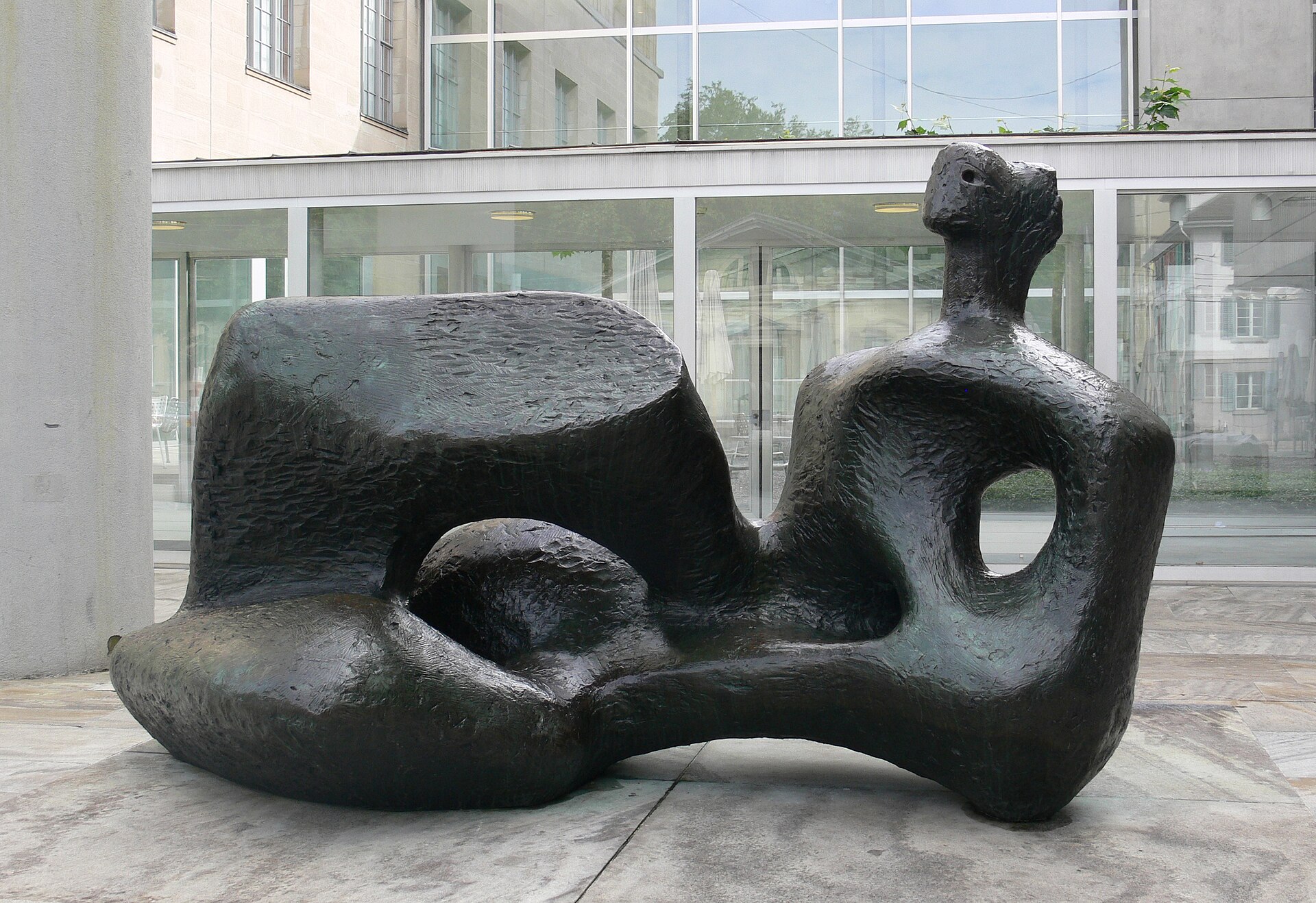 Henry Moore, Reclining Figure (1957). In front of the Kunsthaus Zürich, Switzerland. In the 1950s, Moore began to receive increasingly significant commissions, including a reclining figure for the UNESCO building in Paris in 1958.[119] With many more public works of art, the scale of Moore's sculptures grew significantly. The last three decades of Moore's life continued in a similar vein, with several major retrospectives taking place around the world, notably a prominent exhibition in the summer of 1972 in the grounds of the Forte di Belvedere overlooking Florence. By the end of the 1970s, there were some 40 exhibitions a year featuring his work. On the campus of the University of Chicago in December 1967, 25 years to the minute after the team of physicists led by Enrico Fermi achieved the first controlled, self-sustaining nuclear chain reaction, Moore's Nuclear Energy was unveiled.[120][121] Also in Chicago, Moore commemorated science with a large bronze sundial, locally named Man Enters the Cosmos (1980), which was commissioned to recognise the space exploration program.[122] The "London School" of figurative painters, including Francis Bacon (1909–1992), Lucian Freud (1922–2011), Frank Auerbach (born 1931), Leon Kossoff (born 1926), and Michael Andrews (1928–1995), have received widespread international recognition.[123] Francis Bacon was an Irish-born British figurative painter known for his bold, graphic and emotionally raw imagery.[124] His painterly but abstracted figures typically appear isolated in glass or steel geometrical cages set against flat, nondescript backgrounds. Bacon began painting during his early 20s but worked only sporadically until his mid-30s. His breakthrough came with the 1944 triptych Three Studies for Figures at the Base of a Crucifixion which sealed his reputation as a uniquely bleak chronicler of the human condition.[125] His output can be crudely described as consisting of sequences or variations on a single motif; beginning with the 1940s male heads isolated in rooms, the early 1950s screaming popes, and mid to late 1950s animals and lone figures suspended in geometric structures. These were followed by his early 1960s modern variations of the crucifixion in the triptych format. From the mid-1960s to early 1970s, Bacon mainly produced strikingly compassionate portraits of friends. Following the suicide of his lover George Dyer in 1971, his art became more personal, inward-looking, and preoccupied with themes and motifs of death. During his lifetime, Bacon was equally reviled and acclaimed.[126] Lucian Freud was a German-born British painter, known chiefly for his thickly impastoed portrait and figure paintings, who was widely considered the pre-eminent British artist of his time.[127][128][129][130] His works are noted for their psychological penetration, and for their often discomforting examination of the relationship between artist and model.[131] According to William Grimes of The New York Times, "Lucien Freud and his contemporaries transformed figure painting in the 20th century. In paintings like Girl with a White Dog (1951–1952),[132] Freud put the pictorial language of traditional European painting in the service of an anti-romantic, confrontational style of portraiture that stripped bare the sitter's social facade. Ordinary people—many of them his friends—stared wide-eyed from the canvas, vulnerable to the artist's ruthless inspection."[127] In the 1960s after abstract expressionism Main articles: Post-painterly abstraction, Color field, Lyrical abstraction, Arte Povera, Process art, and Western painting In abstract painting during the 1950s and 1960s several new directions like hard-edge painting and other forms of geometric abstraction began to appear in artist studios and in radical avant-garde circles as a reaction against the subjectivism of abstract expressionism. Clement Greenberg became the voice of post-painterly abstraction when he curated an influential exhibition of new painting that toured important art museums throughout the United States in 1964. color field painting, hard-edge painting and lyrical abstraction[133] emerged as radical new directions. By the late 1960s however, postminimalism, process art and Arte Povera[134] also emerged as revolutionary concepts and movements that encompassed both painting and sculpture, via lyrical abstraction and the postminimalist movement, and in early conceptual art.[134] Process art as inspired by Pollock enabled artists to experiment with and make use of a diverse encyclopedia of style, content, material, placement, sense of time, and plastic and real space. Nancy Graves, Ronald Davis, Howard Hodgkin, Larry Poons, Jannis Kounellis, Brice Marden, Colin McCahon, Bruce Nauman, Richard Tuttle, Alan Saret, Walter Darby Bannard, Lynda Benglis, Dan Christensen, Larry Zox, Ronnie Landfield, Eva Hesse, Keith Sonnier, Richard Serra, Pat Lipsky, Sam Gilliam, Mario Merz and Peter Reginato were some of the younger artists who emerged during the era of late modernism that spawned the heyday of the art of the late 1960s.[135] Pop art 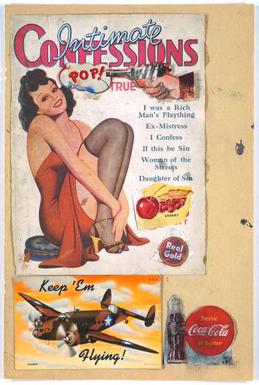 Eduardo Paolozzi. I was a Rich Man's Plaything (1947) is considered the initial standard bearer of "pop art" and first to display the word "pop". Main articles: Pop art and Western painting In 1962 the Sidney Janis Gallery mounted The New Realists, the first major pop art group exhibition in an uptown art gallery in New York City. Janis mounted the exhibition in a 57th Street storefront near his gallery. The show sent shockwaves through the New York School and reverberated worldwide. Earlier in England in 1958 the term "Pop Art" was used by Lawrence Alloway to describe paintings that celebrated the consumerism of the post World War II era. This movement rejected abstract expressionism and its focus on the hermeneutic and psychological interior in favor of art that depicted and often celebrated material consumer culture, advertising, and the iconography of the mass production age. The early works of David Hockney and the works of Richard Hamilton and Eduardo Paolozzi (who created the groundbreaking I was a Rich Man's Plaything, 1947) are considered seminal examples in the movement. Meanwhile, in the downtown scene in New York's East Village 10th Street galleries, artists were formulating an American version of pop art. Claes Oldenburg had his storefront, and the Green Gallery on 57th Street began to show the works of Tom Wesselmann and James Rosenquist. Later Leo Castelli exhibited the works of other American artists, including those of Andy Warhol and Roy Lichtenstein for most of their careers. There is a connection between the radical works of Marcel Duchamp and Man Ray, the rebellious Dadaists with a sense of humor, and pop artists like Claes Oldenburg, Andy Warhol, and Roy Lichtenstein, whose paintings reproduce the look of Ben-Day dots, a technique used in commercial reproduction. Minimalism Main articles: Minimalism, Minimal music, Literary minimalism, Postminimalism, and 20th-century Western painting Minimalism describes movements in various forms of art and design, especially visual art and music, wherein artists intend to expose the essence or identity of a subject through eliminating all nonessential forms, features, or concepts. Minimalism is any design or style wherein the simplest and fewest elements are used to create the maximum effect. As a specific movement in the arts it is identified with developments in post–World War II Western art, most strongly with American visual arts in the 1960s and early 1970s. Prominent artists associated with this movement include Donald Judd, John McCracken, Agnes Martin, Dan Flavin, Robert Morris, Ronald Bladen, Anne Truitt, and Frank Stella.[136] It derives from the reductive aspects of modernism and is often interpreted as a reaction against Abstract expressionism and a bridge to Postminimal art practices. By the early 1960s minimalism emerged as an abstract movement in art (with roots in the geometric abstraction of Kazimir Malevich,[137] the Bauhaus and Piet Mondrian) that rejected the idea of relational and subjective painting, the complexity of abstract expressionist surfaces, and the emotional zeitgeist and polemics present in the arena of action painting. Minimalism argued that extreme simplicity could capture all of the sublime representation needed in art. Minimalism is variously construed either as a precursor to postmodernism, or as a postmodern movement itself. In the latter perspective, early minimalism yielded advanced Modernist works, but the movement partially abandoned this direction when some artists like Robert Morris changed direction in favor of the anti-form movement. Hal Foster, in his essay The Crux of Minimalism,[138] examines the extent to which Donald Judd and Robert Morris both acknowledge and exceed Greenbergian Modernism in their published definitions of minimalism.[138] He argues that minimalism is not a "dead end" of Modernism, but a "paradigm shift toward postmodern practices that continue to be elaborated today."[138] Minimal music The terms have expanded to encompass a movement in music that features such repetition and iteration as those of the compositions of La Monte Young, Terry Riley, Steve Reich, Philip Glass, and John Adams. Minimalist compositions are sometimes known as systems music. The term 'minimal music' is generally used to describe a style of music that developed in America in the late 1960s and 1970s; and that was initially connected with the composers.[139] The minimalism movement originally involved some composers, and other lesser known pioneers included Pauline Oliveros, Phill Niblock, and Richard Maxfield. In Europe, the music of Louis Andriessen, Karel Goeyvaerts, Michael Nyman, Howard Skempton, Eliane Radigue, Gavin Bryars, Steve Martland, Henryk Górecki, Arvo Pärt and John Tavener. Postminimalism 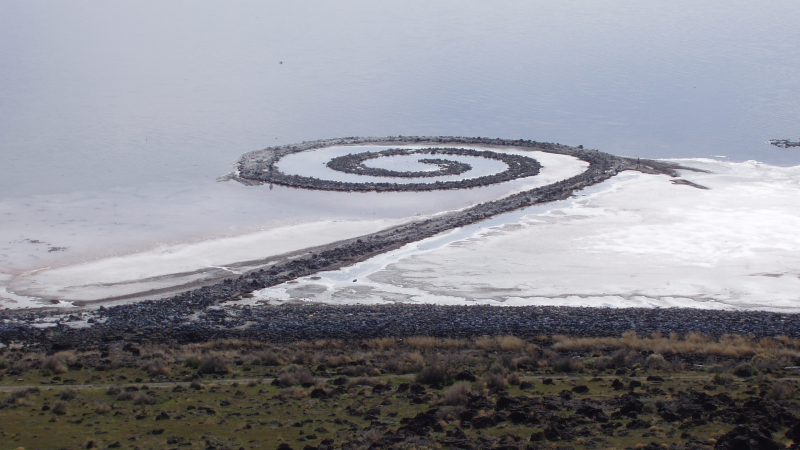 Smithson's Spiral Jetty from atop Rozel Point, Utah, US, in mid-April 2005. Created in 1970, it still exists although it has often been submerged by the fluctuating lake level. It consists of some 6500 tons of basalt, earth and salt. In the late 1960s Robert Pincus-Witten[134] coined the term "postminimalism" to describe minimalist-derived art which had content and contextual overtones that minimalism rejected. The term was applied by Pincus-Whitten to the work of Eva Hesse, Keith Sonnier, Richard Serra and new work by former minimalists Robert Smithson, Robert Morris, Sol LeWitt, Barry Le Va, and others. Other minimalists including Donald Judd, Dan Flavin, Carl Andre, Agnes Martin, John McCracken and others continued to produce late Modernist paintings and sculpture for the remainders of their careers. Since then, many artists have embraced minimal or postminimal styles, and the label "Postmodern" has been attached to them. Collage, assemblage, installations Main articles: Collage, Assemblage (art), and Installation art Related to abstract expressionism was the emergence of combining manufactured items with artist materials, moving away from previous conventions of painting and sculpture. The work of Robert Rauschenberg exemplifies this trend. His "combines" of the 1950s were forerunners of pop art and installation art, and used assemblages of large physical objects, including stuffed animals, birds and commercial photographs. Rauschenberg, Jasper Johns, Larry Rivers, John Chamberlain, Claes Oldenburg, George Segal, Jim Dine, and Edward Kienholz were among important pioneers of both abstraction and pop art. Creating new conventions of art-making, they made acceptable in serious contemporary art circles the radical inclusion in their works of unlikely materials. Another pioneer of collage was Joseph Cornell, whose more intimately scaled works were seen as radical because of both his personal iconography and his use of found objects. Neo-Dada Main article: Neo-Dada In the early 20th century Marcel Duchamp submitted for exhibition a urinal as a sculpture.[140] He professed his intent that people look at the urinal as if it were a work of art because he said it was a work of art. He referred to his work as "readymades". Fountain was a urinal signed with the pseudonym "R. Mutt", the exhibition of which shocked the art world in 1917. This and Duchamp's other works are generally labelled as Dada. Duchamp can be seen as a precursor to conceptual art, other famous examples being John Cage's 4′33″, which is four minutes and thirty three seconds of silence, and Rauschenberg's Erased de Kooning Drawing. Many conceptual works take the position that art is the result of the viewer viewing an object or act as art, not of the intrinsic qualities of the work itself. In choosing "an ordinary article of life" and creating "a new thought for that object" Duchamp invited onlookers to view Fountain as a sculpture.[141] Marcel Duchamp famously gave up "art" in favor of chess. Avant-garde composer David Tudor created a piece, Reunion (1968), written jointly with Lowell Cross, that features a chess game in which each move triggers a lighting effect or projection. Duchamp and Cage played the game at the work's premier.[142] Steven Best and Douglas Kellner identify Rauschenberg and Jasper Johns as part of the transitional phase, influenced by Duchamp, between Modernism and Postmodernism. Both used images of ordinary objects, or the objects themselves, in their work, while retaining the abstraction and painterly gestures of high Modernism.[143] Performance and happenings Main articles: Performance art, Happening, and Fluxus 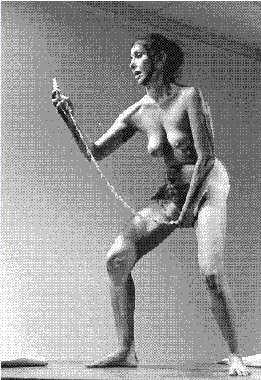 Carolee Schneemann, performing her piece Interior Scroll, 1975. Yves Klein in France, and Carolee Schneemann (pictured), Yayoi Kusama, Charlotte Moorman, and Yoko Ono in New York City were pioneers of performance based works of art, that often entailed nudity.[144] During the late 1950s and 1960s artists with a wide range of interests began to push the boundaries of contemporary art. Yves Klein in France, Carolee Schneemann, Yayoi Kusama, Charlotte Moorman and Yoko Ono in New York City, and Joseph Beuys, Wolf Vostell and Nam June Paik in Germany were pioneers of performance-based works of art. Groups like The Living Theatre with Julian Beck and Judith Malina collaborated with sculptors and painters creating environments, radically changing the relationship between audience and performer, especially in their piece Paradise Now. The Judson Dance Theater, located at the Judson Memorial Church, New York; and the Judson dancers, notably Yvonne Rainer, Trisha Brown, Elaine Summers, Sally Gross, Simonne Forti, Deborah Hay, Lucinda Childs, Steve Paxton and others; collaborated with artists Robert Morris, Robert Whitman, John Cage, Robert Rauschenberg, and engineers like Billy Klüver. Park Place Gallery was a center for musical performances by electronic composers Steve Reich, Philip Glass, and other notable performance artists including Joan Jonas. These performances were intended as works of a new art form combining sculpture, dance, and music or sound, often with audience participation. They were characterized by the reductive philosophies of minimalism and the spontaneous improvisation and expressivity of abstract expressionism. Images of Schneeman's performances of pieces meant to shock are occasionally used to illustrate these kinds of art, and she is often seen photographed while performing her piece Interior Scroll. However, according to modernist philosophy surrounding performance art, it is cross-purposes to publish images of her performing this piece, for performance artists reject publication entirely: the performance itself is the medium. Thus, other media cannot illustrate performance art; performance is momentary, evanescent, and personal, not for capturing; representations of performance art in other media, whether by image, video, narrative or otherwise, select certain points of view in space or time or otherwise involve the inherent limitations of each medium. The artists deny that recordings illustrate the medium of performance as art. During the same period, various avant-garde artists created Happenings, mysterious and often spontaneous and unscripted gatherings of artists and their friends and relatives in various specified locations, often incorporating exercises in absurdity, physicality, costuming, spontaneous nudity, and various random or seemingly disconnected acts. Notable creators of happenings included Allan Kaprow—who first used the term in 1958,[145] Claes Oldenburg, Jim Dine, Red Grooms, and Robert Whitman.[146] Intermedia, multi-media Main article: Intermedia Another trend in art which has been associated with the term postmodern is the use of a number of different media together. Intermedia is a term coined by Dick Higgins and meant to convey new art forms along the lines of Fluxus, concrete poetry, found objects, performance art, and computer art. Higgins was the publisher of the Something Else Press, a concrete poet married to artist Alison Knowles and an admirer of Marcel Duchamp. Ihab Hassan includes "Intermedia, the fusion of forms, the confusion of realms," in his list of the characteristics of postmodern art.[147] One of the most common forms of "multi-media art" is the use of video-tape and CRT monitors, termed video art. While the theory of combining multiple arts into one art is quite old, and has been revived periodically, the postmodern manifestation is often in combination with performance art, where the dramatic subtext is removed, and what is left is the specific statements of the artist in question or the conceptual statement of their action. Fluxus Main article: Fluxus Fluxus was named and loosely organized in 1962 by George Maciunas (1931–1978), a Lithuanian-born American artist. Fluxus traces its beginnings to John Cage's 1957 to 1959 Experimental Composition classes at The New School for Social Research in New York City. Many of his students were artists working in other media with little or no background in music. Cage's students included Fluxus founding members Jackson Mac Low, Al Hansen, George Brecht and Dick Higgins. Fluxus encouraged a do-it-yourself aesthetic and valued simplicity over complexity. Like Dada before it, Fluxus included a strong current of anti-commercialism and an anti-art sensibility, disparaging the conventional market-driven art world in favor of an artist-centered creative practice. Fluxus artists preferred to work with whatever materials were at hand, and either created their own work or collaborated in the creation process with their colleagues. Andreas Huyssen criticises attempts to claim Fluxus for Postmodernism as "either the master-code of postmodernism or the ultimately unrepresentable art movement—as it were, postmodernism's sublime."[148] Instead he sees Fluxus as a major Neo-Dadaist phenomena within the avant-garde tradition. It did not represent a major advance in the development of artistic strategies, though it did express a rebellion against "the administered culture of the 1950s, in which a moderate, domesticated modernism served as ideological prop to the Cold War."[148] Avant-garde popular music Main article: Avant-pop Modernism had an uneasy relationship with popular forms of music (both in form and aesthetic) while rejecting popular culture.[149] Despite this, Stravinsky used jazz idioms on his pieces like "Ragtime" from his 1918 theatrical work Histoire du Soldat and 1945's Ebony Concerto.[150] In the 1960s, as popular music began to gain cultural importance and question its status as commercial entertainment, musicians began to look to the post-war avant-garde for inspiration.[151] In 1959, music producer Joe Meek recorded I Hear a New World (1960), which Tiny Mix Tapes' Jonathan Patrick calls a "seminal moment in both electronic music and avant-pop history [...] a collection of dreamy pop vignettes, adorned with dubby echoes and tape-warped sonic tendrils" which would be largely ignored at the time.[152] Other early avant-pop productions included the Beatles's 1966 song "Tomorrow Never Knows", which incorporated techniques from musique concrète, avant-garde composition, Indian music, and electro-acoustic sound manipulation into a 3-minute pop format, and the Velvet Underground's integration of La Monte Young's minimalist and drone music ideas, beat poetry, and 1960s pop art.[151] Late period Main article: Late modernism 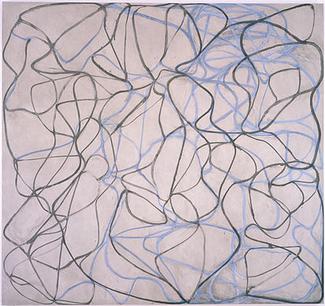 Brice Marden, Vine, 1992–93, oil on linen, 240 by 260 cm (8 by 8+1⁄2 ft), Museum of Modern Art, New York The continuation of abstract expressionism, color field painting, lyrical abstraction, geometric abstraction, minimalism, abstract illusionism, process art, pop art, postminimalism, and other late 20th-century Modernist movements in both painting and sculpture continued through the first decade of the 21st century and constitute radical new directions in those mediums.[153][154][155] At the turn of the 21st century, well-established artists such as Sir Anthony Caro, Lucian Freud, Cy Twombly, Robert Rauschenberg, Jasper Johns, Agnes Martin, Al Held, Ellsworth Kelly, Helen Frankenthaler, Frank Stella, Kenneth Noland, Jules Olitski, Claes Oldenburg, Jim Dine, James Rosenquist, Alex Katz, Philip Pearlstein, and younger artists including Brice Marden, Chuck Close, Sam Gilliam, Isaac Witkin, Sean Scully, Mahirwan Mamtani, Joseph Nechvatal, Elizabeth Murray, Larry Poons, Richard Serra, Walter Darby Bannard, Larry Zox, Ronnie Landfield, Ronald Davis, Dan Christensen, Pat Lipsky, Joel Shapiro, Tom Otterness, Joan Snyder, Ross Bleckner, Archie Rand, Susan Crile, and others continued to produce vital and influential paintings and sculpture. Modern architecture Many skyscrapers in Hong Kong and Frankfurt have been inspired by Le Corbusier and modernist architecture, and his style is still used as influence for buildings worldwide.[156] |
第二次世界大戦後 こちらもご覧ください: 後期モダニズム オックスフォード英国文学百科事典』は、イギリス文学とアメリカ文学に関してモダニズムは1939年頃までに終わったとしているが[104]、「いつ(も し)モダニズムが終焉し、ポストモダニズムが始まったかは、ヴィクトリア朝からモダニズムへの移行がいつ起こったかと同じくらい激しく論争されてきた。 「クレメント・グリーンバーグは、視覚芸術と舞台芸術を除いて、モダニズムは1930年代に終わったと見ている[31]が、音楽に関しては、ポール・グリ フィスは、モダニズムは1920年代後半には「使い果たされたように見えた」が、第二次世界大戦後、「新しい世代の作曲家たち-ブーレーズ、バラケ、バ ビット、ノーノ、シュトックハウゼン、クセナキス」がモダニズムを復活させたと指摘している[106]。実際、多くの文学的モダニストは1950年代や 1960年代まで生きたが、一般的に彼らはもはや主要な作品を制作していなかった。後期モダニズム」という用語は、1930年以降に発表されたモダニズム 作品に適用されることもある[107][108]。1945年以降も発表していたモダニスト(または後期モダニスト)の中には、ウォレス・スティーヴン ス、ゴットフリート・ベン、T・S・エリオット、アンナ・アフマートワ、ウィリアム・フォークナー、ドロシー・リチャードソン、ジョン・カウパー・パウイ ズ、エズラ・パウンドなどがいる。1901年生まれのバジル・バンティングは、1965年に最も重要なモダニズム詩『ブリッグフラッツ』を発表している。 さらに、ヘルマン・ブロッホの『ヴァージルの死』が1945年に、トーマス・マンの『ファウストゥス博士』が1947年に出版された。1989年に死去し たサミュエル・ベケットは「後期モダニスト」と評されている[109]。ベケットはモダニズムの表現主義の伝統にルーツを持つ作家であり、1930年代か ら1980年代にかけて『モロイ』(1951年)、『ゴドーを待ちながら』(1953年)、『ハッピー・デイズ』(1961年)、『ロッカビー』 (1981年)などの作品を発表した。ミニマリスト」や「ポスト・モダニズム」という用語も彼の後期の作品に適用されている[110]。詩人のチャール ズ・オルソン(1910-1970)とJ・H・プリン(1936年生まれ)は、後期モダニストとして記述されてきた20世紀後半の作家の一人である [111]。 より最近では、「後期モダニズム」という用語は少なくとも一人の批評家によって再定義され、1930年よりもむしろ1945年以降に書かれた作品を指すも のとして使用されている。この用法は、モダニズムのイデオロギーが第二次世界大戦の出来事、特にホロコーストと原子爆弾の投下によって大きく再形成された という考えをもたらす[112]。 戦後、ヨーロッパの首都は経済的、物理的に再建し、政治的に再編成する必要に迫られ、激動の中にあった。パリ(かつてのヨーロッパ文化の中心地であり、か つての美術界の首都)では、美術を取り巻く環境は最悪だった。重要なコレクター、ディーラー、モダニズムの芸術家、作家、詩人たちがヨーロッパを離れ、 ニューヨークやアメリカに向かった。ヨーロッパのあらゆる文化の中心地から、シュルレアリストやモダン・アーティストたちが、ナチスの猛攻撃から逃れ、安 全な避難先としてアメリカにたどり着いたのだ。逃亡しなかった人々の多くは命を落とした。パブロ・ピカソ、アンリ・マティス、ピエール・ボナールなど数人 の芸術家はフランスに残り、生き延びた。 このモダニズム運動は、アンリ・マティス、パブロ・ピカソ、シュルレアリスム、ジョアン・ミロ、キュビスム、フォーヴィスム、初期モダニズムから学んだこ とを、ハンス・ホフマンやジョン・D・グラハムといったアメリカの偉大な教師を通じて融合させたものだった。アメリカのアーティストたちは、ピエト・モン ドリアン、フェルナン・レジェ、マックス・エルンストとアンドレ・ブルトン・グループ、ピエール・マティスのギャラリー、ペギー・グッゲンハイムのギャラ リー「The Art of This Century」などの存在から恩恵を受けた。 さらに、パリは1950年代から60年代にかけて、マシン・アートの華やかさの中心地として輝きを取り戻し、マシン・アートの代表的な彫刻家であるジャ ン・ティンゲリーとニコラ・シェーファーは、キャリアをスタートさせるためにパリに移り住んだ。 不条理演劇  サミュエル・ベケットの『ゴドーを待ちながら』、アヴィニョン演劇祭、1978年 不条理演劇」という言葉は、主にヨーロッパ人によって書かれた、人間の存在には意味も目的もなく、したがってすべてのコミュニケーションは崩壊するという 信念を表現した戯曲に適用される。アルフレッド・ジャリ(1873-1907)をはじめとする重要な先駆者がいる一方で、不条理演劇は一般的にサミュエ ル・ベケットの戯曲によって1950年代に始まったと見なされている。 批評家のマーティン・エスリン(Martin Esslin)は、1960年に発表したエッセイ『不条理演劇(Theatre of the Absurd)』でこの言葉を生み出した。彼は、アルベール・カミュが1942年のエッセイ『シジフォスの神話』でこの言葉を用いているのと同様に、不条 理という広範なテーマに基づいてこれらの戯曲を関連づけた[115]。これらの戯曲における不条理は、明らかに意味のない世界に対する人間の反応、および /または目に見えない外部の力によってコントロールされたり脅かされたりする操り人形としての人間という形をとっている。この用語はさまざまな戯曲に適用 されるが、いくつかの特徴は多くの戯曲で一致している。すなわち、しばしばボードビルに似た広範な喜劇と、おぞましいイメージや悲劇的なイメージの混合、 絶望的な状況に追い込まれた登場人物が反復的で無意味な行動を強いられる、決まり文句や言葉遊び、ナンセンスに満ちた台詞、循環的で不条理な広がりを持つ プロット、リアリズムや「よくできた戯曲」の概念のパロディや否定である。 不条理劇場によく関連する劇作家には、サミュエル・ベケット(1906~1989)、ウジェーヌ・イヨネスコ(1909~1994)、ジャン・ジュネ (1910~1986)、ハロルド・ピンター(1930~2008)、トム・ストッパード(1937年生まれ)などがいる、 アレクサンドル・ヴヴェデンスキー(1904-1941)、ダニール・ハルムス(1905-1942)、フリードリヒ・デュレンマット(1921- 1990)、アレハンドロ・ホドロフスキー(1929年生まれ)、フェルナンド・アラバル(1932年生まれ)、ヴァーツラフ・ハヴェル(1936- 2011)、エドワード・アルビー(1928-2016)。 ポロックと抽象画の影響 1940年代後半、ジャクソン・ポロックの絵画に対する急進的なアプローチは、彼に続くすべての現代美術の可能性に革命をもたらした。ポロックはある程度 まで、芸術作品を制作するまでの道のりが、芸術作品そのものと同じくらい重要であることに気づいていた。20世紀初頭にパブロ・ピカソがキュビスムや構築 彫刻を通じて絵画と彫刻を革新的に再発明したように、ポロックは芸術の作り方を再定義した。彼のイーゼル・ペインティングや型にはまったものからの脱却 は、同時代の芸術家たち、そしてその後のすべての芸術家たちに解放のシグナルを送った。アーティストたちは、ジャクソン・ポロックのプロセス、つまり、芸 術的・工業的素材を用いて四方から攻撃できるように、伸ばされていない生のキャンバスを床に置くこと、絵具を垂らしたり投げたりすること、ドローイング、 染色、ブラッシング、イメージや非想像を用いることが、本質的にそれまでの境界線を超えてアート制作を爆発させたことに気づいた。抽象表現主義は一般的 に、芸術家が新しい作品を創作するために利用できる定義と可能性を拡大し、発展させた。他の抽象表現主義者たちは、ポロックの躍進に続いて、独自の新たな 躍進を遂げた。ある意味で、ジャクソン・ポロック、ウィレム・デ・クーニング、フランツ・クライン、マーク・ロスコ、フィリップ・グストン、ハンス・ホフ マン、クライフォード・スティル、バーネット・ニューマン、アド・ラインハート、ロバート・マザーウェル、ピーター・ヴルコスらの革新は、彼らに続くすべ ての芸術の多様性と範囲への門戸を開いたのである。しかし、リンダ・ノクリン[116]、グリゼルダ・ポロック[117]、カトリーヌ・ド・ゼーガー [118]といった美術史家たちによる抽象美術の再読は、近代美術に大きな革新をもたらした先駆的な女性アーティストたちが、その歴史に関する公式の説明 では無視されてきたことを批判的に示している。 イギリス美術の国際的人物 ヘンリー・ムーア(1898-1986)は第二次世界大戦後、イギリスを代表する彫刻家として頭角を現した。彼は、公共芸術作品として世界中にある半抽象 的な記念碑的ブロンズ彫刻で最もよく知られている。彼のフォルムは通常、人物の抽象化であり、1950年代に家族のグループを彫刻した時期を除けば、母子 像や涅槃像など、女性の身体を暗示するものが多い。彼の造形は一般的に、穴が開いていたり、空洞を含んでいたりする。  ヘンリー・ムーア《涅槃像》(1957年)。スイス、チューリッヒ美術館前 にて。 1958年にはパリのユネスコ・ビルディングのための涅槃像を制作するなど、1950年代に入るとムーアはますます大きな仕事を受けるようになる [119]。ムーアの生涯の最後の30年間は、同じような調子で続き、いくつかの大規模な回顧展が世界中で開催され、特に1972年の夏には、フィレン ツェを見下ろすベルヴェデーレ要塞の敷地内で著名な展覧会が開催された。1970年代の終わりには、彼の作品を紹介する展覧会が年間40回ほど開催される ようになった。1967年12月、シカゴ大学のキャンパスで、エンリコ・フェルミ率いる物理学者チームが、制御された自立的な核連鎖反応を初めて達成して から25年後に、ムーアの『Nuclear Energy(核エネルギー)』が公開された[120][121]。またシカゴでは、ムーアは科学を記念して、地元では『Man Enters the Cosmos』(1980)と名付けられた大きなブロンズの日時計を制作。 フランシス・ベーコン(1909-1992)、ルシアン・フロイト(1922-2011)、フランク・アウアーバッハ(1931年生まれ)、レオン・コソ フ(1926年生まれ)、マイケル・アンドリュース(1928-1995)を含む具象画家の「ロンドン派」は、国際的に広く認知されている[123]。 フランシス・ベーコンは、アイルランド生まれのイギリスの具象画家で、大胆でグラフィック、感情的に生々しいイメージで知られている[124]。彼の絵画 的だが抽象的な人物は、通常、平坦で何の変哲もない背景に置かれたガラスやスチールの幾何学的なケージの中で孤立しているように見える。ベーコンは20代 前半に絵を描き始めたが、30代半ばまでは散発的にしか制作していなかった。彼の作品は、1940年代の部屋に隔離された男性の頭部、1950年代初期の 叫び声を上げる教皇、1950年代中期から後期にかけての幾何学的な構造物に吊るされた動物や孤独な人物など、単一のモチーフの連続やバリエーションから 構成されていると粗雑に表現することができる。続いて、1960年代初頭には、トリプティク形式による磔刑像のモダンなヴァリエーションが描かれた。 1960年代半ばから1970年代初頭にかけて、ベーコンは主に友人たちの慈愛に満ちた肖像画を制作した。1971年に恋人のジョージ・ダイアーが自殺し た後、彼の芸術はより個人的で内向的なものとなり、死のテーマやモチーフに夢中になった。生前、ベーコンは酷評されることも絶賛されることもあった [126]。 ルシアン・フロイトはドイツ生まれのイギリス人画家であり、主に厚塗りのインパストによる肖像画や人物画で知られ、同時代のイギリス人アーティストの中で も傑出した存在であったと広く考えられている[127][128][129][130]。白い犬を連れた少女』(1951-1952)のような絵画におい て、フロイトは伝統的なヨーロッパ絵画の絵画言語を、被写体の社会的な面を剥き出しにする反ロマン主義的で対立的な肖像画のスタイルに役立てた。普通の人 々、その多くは彼の友人たちであったが、画家の冷酷な視線に対して無防備に、キャンバスから目を見開いて見つめていた」[127]。 抽象表現主義の後の1960年代 主な記事 ポスト絵画的抽象、カラーフィールド、叙情的抽象、アルテ・ポーヴェラ、プロセス・アート、西洋絵画 1950年代から1960年代にかけての抽象絵画では、抽象表現主義の主観主義に対する反動として、ハードエッジ絵画や幾何学的抽象のような新しい方向性 が、アーティストのアトリエや急進的な前衛サークルに現れ始めた。クレメント・グリーンバーグは、1964年に全米の重要な美術館を巡回した新しい絵画の 影響力のある展覧会を企画した際に、ポスト絵画的抽象の代弁者となり、カラーフィールド・ペインティング、ハードエッジ・ペインティング、叙情的抽象 [133]が急進的な新しい方向性として登場した。 しかし1960年代後半になると、ポスト・ミニマリズム、プロセス・アート、アルテ・ポーヴェラ[134]もまた、叙情的抽象やポスト・ミニマリズム運 動、初期のコンセプチュアル・アート[134]を経て、絵画と彫刻の両方を包括する革命的な概念と運動として台頭した。ポロックに触発されたプロセス・ アートは、アーティストたちがスタイル、内容、素材、配置、時間感覚、可塑的空間と現実空間の多様な百科事典を試し、活用することを可能にした。ナン シー・グレイヴス、ロナルド・デイヴィス、ハワード・ホジキン、ラリー・プーンズ、ヤニス・クネリス、ブリス・マーデン、コリン・マッカホン、ブルース・ ナウマン、リチャード・タトル、アラン・サレット、ウォルター・ダービー・バナード、リンダ・ベングリス、ダン・クリステンセン、ラリー・ゾックス、ロ ニー・ランドフィールド、 エヴァ・ヘッセ、キース・ソニエ、リチャード・セラ、パット・リプスキー、サム・ギリアム、マリオ・メルツ、ピーター・レジナートは、1960年代後半の 芸術の全盛期を生み出した後期モダニズムの時代に登場した若手アーティストの一人である。 [135] ポップ・アート  エドゥアルド・パオロッツィ I was a Rich Man's Plaything』(1947年)は、「ポップ・アート」の最初の旗手であり、「ポップ」という言葉を最初に使った作品とされている。 主な記事 ポップ・アートと西洋絵画 1962年、シドニー・ジャニス・ギャラリーは、ニューヨークのアップタウンの画廊で初の大規模なポップ・アートのグループ展「The New Realists」を開催した。ジャニスはこの展覧会をギャラリーの近くにある57丁目の店先で開催した。この展覧会はニューヨーク派に衝撃を与え、世界 中に反響を呼んだ。それ以前の1958年、イギリスでは、ローレンス・アロウェイによって、第二次世界大戦後の消費主義を賛美する絵画を「ポップ・アー ト」と呼ぶようになった。この運動は、抽象表現主義やその解釈学的・心理学的内面への焦点を否定し、物質的な消費文化や広告、大量生産時代の図像を描き、 しばしばそれを賛美する芸術を支持した。デヴィッド・ホックニーの初期の作品や、リチャード・ハミルトンやエドゥアルド・パオロッツィ(画期的な『私は金 持ちのおもちゃだった』(1947年)を制作)の作品は、このムーブメントの代表的な例とみなされている。一方、ニューヨークのイースト・ヴィレッジ10 番街のギャラリーの繁華街では、アーティストたちがアメリカ版ポップ・アートを形成していた。クレス・オルデンバーグは店舗を構え、57丁目のグリーン・ ギャラリーではトム・ヴェッセルマンやジェームズ・ローゼンクイストの作品を展示し始めた。その後、レオ・カステリは、アンディ・ウォーホルやロイ・リキ テンスタインなど、他のアメリカ人アーティストの作品を彼らのキャリアの大半にわたって展示した。マルセル・デュシャンやマン・レイの過激な作品、ユーモ アのセンスを持った反抗的なダダイスト、そしてクレス・オルデンバーグ、アンディ・ウォーホル、ロイ・リキテンスタインのようなポップ・アーティストの作 品は、商業的複製に使われる技法であるベン・デイ・ドットの外観を絵画で再現している。 ミニマリズム 主な記事 ミニマリズム、ミニマル・ミュージック、文学的ミニマリズム、ポスト・ミニマリズム、20世紀西洋絵画 ミニマリズムとは、芸術やデザイン、特に視覚芸術や音楽の様々な形態における動きを表すもので、芸術家たちは、本質的でない形や特徴、概念をすべて排除す ることで、対象の本質やアイデンティティを明らかにすることを意図している。ミニマリズムとは、最大限の効果を生み出すために、最もシンプルで少ない要素 を使用するデザインやスタイルのことである。 芸術における特定の運動としては、第二次世界大戦後の西洋美術の発展、とりわけ1960年代から1970年代初頭にかけてのアメリカの視覚芸術と強く結び ついている。この運動に関連する著名なアーティストには、ドナルド・ジャッド、ジョン・マクラッケン、アグネス・マーティン、ダン・フラヴィン、ロバー ト・モリス、ロナルド・ブラデン、アン・トゥルーイット、フランク・ステラなどがいる[136]。モダニズムの還元的な側面から派生したものであり、抽象 表現主義に対する反動として、またポストミニマル・アートへの橋渡しとして解釈されることが多い。1960年代初頭までに、ミニマリズムは、関係的で主観 的な絵画、抽象表現主義の表面の複雑さ、アクション・ペインティングの場に存在する感情的な時代精神や極論を否定する、(カジミール・マレーヴィチの幾何 学的抽象、[137]バウハウスやピエト・モンドリアンにルーツを持つ)芸術における抽象運動として出現した。ミニマリズムは、極限まで単純化すること で、芸術に必要な崇高な表現のすべてを捉えることができると主張した。ミニマリズムは、ポストモダニズムの先駆けとして、あるいはポストモダニズム運動そ のものとして、さまざまに解釈されている。後者の観点では、初期のミニマリズムは先進的なモダニズム作品を生み出したが、ロバート・モリスのような何人か のアーティストが反形式運動に方向転換したことで、この運動は部分的にこの方向性を放棄した。 ハル・フォスターは、そのエッセイ『The Crux of Minimalism』[138]の中で、ドナルド・ジャッドとロバート・モリスが発表したミニマリズムの定義において、グリーンバーグ的なモダニズムを 認め、また超えている度合いを検証している[138]。 ミニマル・ミュージック この用語は、ラ・モンテ・ヤング、テリー・ライリー、スティーヴ・ライヒ、フィリップ・グラス、ジョン・アダムスの作曲のような反復と繰り返しを特徴とす る音楽の動きを包含するように拡大してきた。ミニマリズムの作曲は、システム音楽として知られることもある。ミニマル・ミュージック」という用語は一般的 に、1960年代後半から1970年代にかけてアメリカで発展した音楽のスタイルを表すのに使われ、当初は作曲家たちと結びついていた[139]。ミニマ リズム運動にはもともと何人かの作曲家が関わっており、その他にあまり知られていないが、ポーリーン・オリヴェロス、フィル・ニブロック、リチャード・ マックスフィールドなどが先駆者として挙げられる。ヨーロッパでは、ルイ・アンドリーセン、カレル・ゲイヴァーツ、マイケル・ナイマン、ハワード・スケン プトン、エリアーヌ・ラディーグ、ギャヴィン・ブライヤーズ、スティーヴ・マートランド、ヘンリク・ゴレツキ、アルヴォ・ペルト、ジョン・タヴェナーの音 楽が挙げられる。 ポストミニマリズム  2005年4月中旬、米国ユタ州ロゼル・ポイントの頂上から見たスミッソンのスパイラル・ジェッティ。1970年に制作されたこの桟橋は、湖の水位の変動 によってしばしば水没してきたが、現在も存在している。約6500トンの玄武岩、土、塩でできている。 1960年代後半、ロバート・ピンカス=ウィッテン[134]は、ミニマリズムが否定した内容や文脈的な含みを持つミニマリズム由来の芸術を表すために 「ポストミニマリズム」という言葉を作った。この用語は、エヴァ・ヘッセ、キース・ソニエ、リチャード・セラの作品や、かつてのミニマリストであるロバー ト・スミッソン、ロバート・モリス、ソル・ルウィット、バリー・ルヴァらによる新しい作品に適用された。ドナルド・ジャッド、ダン・フレイヴィン、カー ル・アンドレ、アグネス・マーティン、ジョン・マクラッケンなどのミニマリストは、後期モダニズムの絵画や彫刻を制作し続けた。 それ以来、多くのアーティストがミニマルやポストミニマルのスタイルを取り入れ、「ポストモダン」というレッテルを貼られるようになった。 コラージュ、アッサンブラージュ、インスタレーション 主な記事 コラージュ、アッサンブラージュ(アート)、インスタレーション・アート 抽象表現主義と関連して、それまでの絵画や彫刻の慣習から離れ、アーティストの素材に製造品を組み合わせることが出現した。ロバート・ラウシェンバーグの 作品は、この傾向を象徴している。1950年代の彼の「コンバイン」は、ポップ・アートとインスタレーション・アートの先駆けであり、ぬいぐるみ、鳥、商 業写真など、大型の物理的な物体のアッサンブラージュを用いた。ラウシェンバーグ、ジャスパー・ジョーンズ、ラリー・リヴァース、ジョン・チェンバレン、 クレス・オルデンバーグ、ジョージ・シーガル、ジム・ダイン、エドワード・キエンホルツは、抽象とポップ・アートの重要な先駆者である。アート制作の新た な常識を作り出した彼らは、ありそうでなかった素材を作品に取り入れることを、本格的な現代美術界で容認させた。コラージュのもう一人のパイオニアはジョ セフ・コーネルで、より親密なスケールの作品は、彼の個人的なイコノグラフィーと拾得物の使用の両方により、急進的と見なされた。 ネオ・ダダ 主な記事 ネオ・ダダ 20世紀初頭、マルセル・デュシャンは小便器を彫刻として展覧会に出品した[140]。彼は自分の作品を「レディ・メイド」と呼んだ。泉》は「R・ムッ ト」というペンネームで署名された小便器で、その展覧会は1917年の美術界に衝撃を与えた。この作品とデュシャンの他の作品は、一般的にダダと呼ばれて いる。デュシャンはコンセプチュアル・アートの先駆けとして見ることができ、他の有名な例としては、4分33秒の沈黙を描いたジョン・ケージの「4′ 33″」や、ラウシェンバーグの「Erased de Kooning Drawing」などがある。コンセプチュアルな作品の多くは、芸術とは作品そのものが持つ本質的な性質ではなく、鑑賞者が物や行為を芸術として鑑賞した 結果であるという立場をとっている。デュシャンは「ありふれた生活用品」を選び、「その物体のための新しい思考」を創造することで、「泉」を彫刻として見 るように見物人に呼びかけた[141]。 マルセル・デュシャンがチェスのために「芸術」を放棄したことは有名である。前衛的な作曲家デイヴィッド・チューダーは、ローウェル・クロスとの共作で、 一手ごとに照明効果や投影が起こるチェス・ゲームをフィーチャーした作品『再会』(1968年)を制作した。デュシャンとケージは、この作品の初演でゲー ムを行った[142]。 スティーブン・ベストとダグラス・ケルナーは、ラウシェンバーグとジャスパー・ジョーンズを、デュシャンの影響を受けた、モダニズムとポストモダニズムの 間の過渡期の一部であると見なしている。両者とも、ハイ・モダニズムの抽象性と絵画的身振りを保ちながら、普通の物体のイメージ、あるいは物体そのものを 作品に用いた[143]。 パフォーマンスとハプニング 主な記事 パフォーマンス・アート、ハプニング、フルクサス  Carolee Schneemann、作品「Interior Scroll」のパフォーマンス、1975年。 フランスのイヴ・クライン、ニューヨークのキャロリー・シュネマン(写真)、草間彌生、シャーロット・ムーアマン、オノ・ヨーコは、しばしばヌードを伴う パフォーマンス・ベースの芸術作品の先駆者であった[144]。 1950年代後半から1960年代にかけて、幅広い関心を持つアーティストたちが現代美術の境界を押し広げ始めた。フランスのイヴ・クライン、ニューヨー クのカロリー・シュナイマン、草間彌生、シャーロット・ムーアマン、オノ・ヨーコ、ドイツのヨーゼフ・ボイス、ヴォルフ・フォステル、ナム・ジュン・パイ クは、パフォーマンス・ベースの芸術作品の先駆者だった。ジュリアン・ベックとジュディス・マリーナが率いるリビング・シアターのようなグループは、彫刻 家や画家とコラボレートして環境を作り出し、特に彼らの作品『パラダイス・ナウ』では、観客とパフォーマーの関係を根本的に変えた。ジャドソン・ダンス・ シアターはニューヨークのジャドソン・メモリアル・チャーチにあり、ジャドソンのダンサーたち、特にイヴォンヌ・レイナー、トリシャ・ブラウン、エレイ ン・サマーズ、サリー・グロス、シモンヌ・フォルティ、デボラ・ヘイ、ルシンダ・チャイルズ、スティーブ・パクストンらと、アーティストのロバート・モリ ス、ロバート・ホイットマン、ジョン・ケージ、ロバート・ラウシェンバーグ、ビリー・クルーヴァーのようなエンジニアたちとコラボレーションを行った。 パークプレイス・ギャラリーは、電子作曲家のスティーブ・ライヒやフィリップ・グラス、ジョーン・ジョナスをはじめとする著名なパフォーマンス・アーティ ストによる音楽パフォーマンスの中心地であった。 これらのパフォーマンスは、彫刻、ダンス、音楽やサウンドを組み合わせた新しい芸術形式の作品として意図され、しばしば観客も参加した。ミニマリズムの還 元的な哲学と、抽象表現主義の自発的な即興性と表現力が特徴であった。シュネーマンが衝撃的な作品を上演した際の映像は、こうした芸術を説明するために使 われることがあり、『インテリア・スクロール』という作品を上演している際に撮影されることも多い。しかし、パフォーマンス・アートをめぐるモダニズムの 哲学によれば、彼女がこの作品を上演している画像を公開することは逆効果であり、パフォーマンス・アーティストは出版を完全に拒否している。したがって、 他のメディアがパフォーマンス・アートを説明することはできない。パフォーマンスは瞬間的で、儚く、個人的なものであり、撮影するためのものではない。他 のメディアにおけるパフォーマンス・アートの表現は、画像、映像、物語、その他にかかわらず、空間や時間における特定の視点を選択するものであり、そうで なければ、それぞれのメディアに固有の制約を伴うものである。アーティストたちは、レコーディングが芸術としてのパフォーマンスの媒体を説明することを否 定している。 同時期、様々な前衛芸術家たちがハプニングを創作した。これは、様々な特定の場所で、芸術家たちとその友人や親族が、神秘的で、しばしば自然発生的で、台 本のない集まりを行うもので、しばしば不条理、身体性、衣装、自然発生的な裸体、様々な無作為の、あるいは一見バラバラに見える行為を取り入れたもので あった。ハプニングの著名なクリエイターには、1958年に初めてこの言葉を使ったアラン・カプロー、[145]クレス・オルデンバーグ、ジム・ダイン、 レッド・グルームズ、ロバート・ホイットマンなどがいる[146]。 インターメディア、マルチメディア 主な記事 インターメディア ポストモダンという言葉とともに語られてきたアートのもうひとつの傾向は、異なるメディアを多数併用することである。インターメディアとは、ディック・ヒ ギンズの造語であり、フルクサス、具体詩、ファウンド・オブジェクト、パフォーマンス・アート、コンピューター・アートの流れを汲む新しい芸術形態を伝え ることを意味している。ヒギンズはサムシング・エルス・プレスの発行人であり、アーティストのアリソン・ノウルズと結婚した具象詩人であり、マルセル・ デュシャンの崇拝者でもあった。イハブ・ハッサンは、ポストモダン・アートの特徴のリストに「インターメディア、形態の融合、領域の混乱」を挙げている [147]。「マルチメディア・アート」の最も一般的な形態のひとつは、ビデオテープとCRTモニターの使用であり、ビデオアートと呼ばれている。複数の 芸術を1つの芸術に統合するという理論は非常に古く、定期的に復活しているが、ポストモダンの現れは、しばしばパフォーマンス・アートと組み合わされ、ド ラマチックなサブテキストが取り除かれ、残されるのは、当該アーティストの具体的な発言、あるいはその行為の概念的な表明である。 フルクサス 主な記事 フルクサス フルクサスは、リトアニア生まれのアメリカ人アーティスト、ジョージ・マチューナス(1931-1978)によって1962年に命名され、緩やかに組織さ れた。フルクサスの始まりは、ジョン・ケージが1957年から1959年にかけてニューヨークのニュー・スクール・フォー・ソーシャル・リサーチで行った 実験的作曲のクラスに遡る。彼の生徒の多くは、音楽の素養がほとんど、あるいはまったくない、他のメディアで活動するアーティストだった。ケージの生徒に は、フルクサス創設メンバーのジャクソン・マック・ロー、アル・ハンセン、ジョージ・ブレヒト、ディック・ヒギンズらがいた。 フルクサスはDIYの美学を奨励し、複雑さよりもシンプルさを重んじた。それ以前のダダと同様、フルクサスには反商業主義と反芸術の強い潮流があり、従来 の市場主導の芸術界を軽蔑し、アーティスト中心の創造的実践を支持した。フルクサスのアーティストたちは、手近にあるどんな素材でも使うことを好み、自分 の作品を作るか、仲間たちと共同制作を行った。 アンドレアス・ホイセンは、フルクサスを「ポストモダニズムのマスター・コード、あるいは究極的に表現不可能な芸術運動、いわばポストモダニズムの崇高 さ」としてポストモダニズムのために主張しようとする試みを批判している。フルクサスは芸術的戦略の発展において大きな前進を意味するものではなかった が、「穏健で飼いならされたモダニズムが冷戦のイデオロギー的支柱として機能していた1950年代の管理された文化」[148]に対する反抗を表現してい た。 前衛ポピュラー音楽 主な記事 アヴァン・ポップ モダニズムは大衆文化を拒絶しながらも、大衆音楽の形式(形式と美意識の両方において)とは不穏な関係にあった[149]。にもかかわらず、ストラヴィン スキーは1918年の演劇作品『兵士の歴史』の「ラグタイム」や1945年の『エボニー協奏曲』のような作品でジャズのイディオムを使用していた [150]。 1960年代、ポピュラー音楽が文化的な重要性を獲得し始め、商業的な娯楽としての地位を疑問視するようになると、音楽家たちはインスピレーションを得る ために戦後のアヴァンギャルドに注目し始めた[151]。 [151]1959年、音楽プロデューサーのジョー・ミークが『I Hear a New World』(1960年)を録音し、Tiny Mix Tapesのジョナサン・パトリックはこれを「エレクトロニック・ミュージックとアヴァン・ポップの歴史における決定的瞬間」と呼んでいるが、当時はほと んど無視されていた。 [152]他の初期のアヴァン・ポップ作品には、ビートルズの1966年の楽曲「トゥモロー・ネヴァー・ノウズ」があり、これはミュジーク・コンクレー ト、アヴァンギャルド作曲、インド音楽、エレクトロ・アコースティック・サウンド・マニュピュレーションのテクニックを3分間のポップ・フォーマットに取 り入れたものであり、ヴェルヴェット・アンダーグラウンドはラ・モンテ・ヤングのミニマリズムとドローン・ミュージックのアイデア、ビート・ポエトリー、 1960年代のポップ・アートを統合したものであった[151]。 後期 主な記事 後期モダニズム  ブリス・マーデン《つる》1992-93年、リネンに油彩、240×260cm、ニューヨーク近代美術館蔵 抽象表現主義、カラーフィールド・ペインティング、叙情的抽象、幾何学的抽象、ミニマリズム、抽象幻想主義、プロセス・アート、ポップ・アート、ポスト・ ミニマリズムなど、絵画と彫刻の両方における20世紀後半のモダニズム運動の継続は、21世紀の最初の10年間も続き、それらのメディアにおける急進的な 新しい方向性を構成している[153][154][155]。 サム・ギリアム、アイザック・ウィトキン、ショーン・スカリー、マヒルワン・マムタニ、ジョセフ・ネクヴァタル、エリザベス・マレー、ラ リー・プーンズ、リチャード・セラ、ウォルター・ダービー・バナード、ラリー・ゾックス、ロニー・ランドフィールド、ロナルド・デイヴィス、ダン・クリス テンセン、パット・リプスキー、ジョエル・シャピロ、トム・オッターネス、ジョーン・スナイダー、ロス・ブレックナー、アーチー・ランド、スーザン・クリ ルなどの若手作家は、重要で影響力のある絵画や彫刻を制作し続けた。 近代建築 香港やフランクフルトの多くの超高層ビルはル・コルビュジエやモダニズム建築に影響を受けており、彼のスタイルは今でも世界中の建築物に影響を与え続けて いる[156]。 |
| Modernism in Africa and Asia See also: Santiniketan: The Making of a Contextual Modernism and Hanshinkan Modernism Peter Kalliney suggests that "Modernist concepts, especially aesthetic autonomy, were fundamental to the literature of decolonization in anglophone Africa."[157] In his opinion, Rajat Neogy, Christopher Okigbo, and Wole Soyinka, were among the writers who "repurposed modernist versions of aesthetic autonomy to declare their freedom from colonial bondage, from systems of racial discrimination, and even from the new postcolonial state".[158] The terms "modernism" and "modernist", according to scholar William J. Tyler, "have only recently become part of the standard discourse in English on modern Japanese literature and doubts concerning their authenticity vis-a-vis Western European modernism remain". Tyler finds this odd, given "the decidedly modern prose" of such "well-known Japanese writers as Kawabata Yasunari, Nagai Kafu, and Jun'ichirō Tanizaki". However, "scholars in the visual and fine arts, architecture, and poetry readily embraced "modanizumu" as a key concept for describing and analyzing Japanese culture in the 1920s and 1930s".[159] In 1924, various young Japanese writers, including Kawabata and Riichi Yokomitsu started a literary journal Bungei Jidai ("The Artistic Age"). This journal was "part of an 'art for art's sake' movement, influenced by European Cubism, Expressionism, Dada, and other modernist styles".[160] Japanese modernist architect Kenzō Tange (1913–2005) was one of the most significant architects of the 20th century, combining traditional Japanese styles with modernism, and designing major buildings on five continents. Tange was also an influential patron of the Metabolist movement. He said: "It was, I believe, around 1959 or at the beginning of the sixties that I began to think about what I was later to call structuralism",[161] He was influenced from an early age by the Swiss modernist, Le Corbusier, Tange gained international recognition in 1949 when he won the competition for the design of Hiroshima Peace Memorial Park. In China the "New Sensationists" (新感觉派, Xīn Gǎnjué Pài) were a group of writers based in Shanghai who in the 1930s and 1940s were influenced, to varying degrees, by Western and Japanese modernism. They wrote fiction that was more concerned with the unconscious and with aesthetics than with politics or social problems. Among these writers were Mu Shiying and Shi Zhecun. In India, the Progressive Artists' Group was a group of modern artists, mainly based in Mumbai, India formed in 1947. Though it lacked any particular style, it synthesised Indian art with European and North America influences from the first half of the 20th century, including Post-Impressionism, Cubism and Expressionism. Differences between modernism and postmodernism By the early 1980s the Postmodern movement in art and architecture began to establish its position through various conceptual and intermedia formats. Postmodernism in music and literature began to take hold earlier. In music, postmodernism is described in one reference work as a "term introduced in the 1970s",[162] while in British literature, The Oxford Encyclopedia of British Literature sees modernism "ceding its predominance to postmodernism" as early as 1939.[104] However, dates are highly debatable, especially as according to Andreas Huyssen: "one critic's postmodernism is another critic's modernism."[163] This includes those who are critical of the division between the two and see them as two aspects of the same movement, and believe that late Modernism continues.[163] Modernism is an encompassing label for a wide variety of cultural movements. Postmodernism is essentially a centralized movement that named itself, based on sociopolitical theory, although the term is now used in a wider sense to refer to activities from the 20th century onwards which exhibit awareness of and reinterpret the modern.[164][165][166] Postmodern theory asserts that the attempt to canonise Modernism "after the fact" is doomed to undisambiguable contradictions.[167] In a narrower sense, what was Modernist was not necessarily also postmodern. Those elements of Modernism which accentuated the benefits of rationality and socio-technological progress were only Modernist.[168] Attack on early modernism  Franz Marc, The fate of the animals, 1913, oil on canvas. The work was displayed at the exhibition of "Entartete Kunst" ("degenerate art") in Munich, Nazi Germany, 1937. Modernism's stress on freedom of expression, experimentation, radicalism, and primitivism disregards conventional expectations. In many art forms this often meant startling and alienating audiences with bizarre and unpredictable effects, as in the strange and disturbing combinations of motifs in Surrealism or the use of extreme dissonance and atonality in Modernist music. In literature this often involved the rejection of intelligible plots or characterization in novels, or the creation of poetry that defied clear interpretation. Within the Catholic Church, the specter of Protestantism and Martin Luther was at play in anxieties over modernism and the notion that doctrine develops and changes over time.[169] From 1932, socialist realism began to oust Modernism in the Soviet Union;[98] it had previously endorsed Futurism and Constructivism. The Nazi government of Germany deemed modernism narcissistic and nonsensical, as well as "Jewish" (see Antisemitism) and "Negro".[170] The Nazis exhibited Modernist paintings alongside works by the mentally ill in an exhibition entitled "Degenerate Art". Accusations of "formalism" could lead to the end of a career, or worse. For this reason many modernists of the postwar generation felt that they were the most important bulwark against totalitarianism, the "canary in the coal mine", whose repression by a government or other group with supposed authority represented a warning that individual liberties were being threatened. Louis A. Sass compared madness, specifically schizophrenia, and modernism in a less fascist manner by noting their shared disjunctive narratives, surreal images, and incoherence.[171] Criticism of late modernity In fact, modernism flourished mainly in consumer/capitalist societies, despite the fact that its proponents often rejected consumerism itself. However, high modernism began to merge with consumer culture after World War II, especially during the 1960s. Modernist devices also started to appear in popular cinema, and later on in music videos. Modernist design also began to enter the mainstream of popular culture, as simplified and stylized forms became popular, often associated with dreams of a space age high-tech future.[172][173] In 2008, Janet Bennett published Modernity and Its Critics through The Oxford Handbook of Political Theory.[174] Merging of consumer and high versions of Modernist culture led to a radical transformation of the meaning of "Modernism". First, it implied that a movement based on the rejection of tradition had become a tradition of its own. Second, it demonstrated that the distinction between elite Modernist and mass consumerist culture had lost its precision. Modernism had become so institutionalized that it was now "post avant-garde", indicating that it had lost its power as a revolutionary movement. Many have interpreted this transformation as the beginning of the phase that became known as postmodernism. For others, such as art critic Robert Hughes, postmodernism represents an extension of modernism. "Anti-modern" or "counter-modern" movements seek to emphasize holism, connection and spirituality as remedies or antidotes to modernism. Such movements see modernism as reductionist, and therefore subject to an inability to see systemic and emergent effects. Some traditionalist artists like Alexander Stoddart reject modernism generally as the product of "an epoch of false money allied with false culture".[175] In some fields, the effects of modernism have remained stronger and more persistent than in others. Visual art has made the most complete break with its past. Most major capital cities have museums devoted to modern art as distinct from post-Renaissance art (c. 1400 to c. 1900). Examples include the Museum of Modern Art in New York, the Tate Modern in London, and the Centre Pompidou in Paris. These galleries make no distinction between modernist and Postmodernist phases, seeing both as developments within Modern Art. |
アフリカとアジアのモダニズム こちらもご覧ください: サンティニケタン: 文脈的モダニズムの形成と漢新館モダニズム ピーター・カリニーは、「モダニズムの概念、特に美的自律性は、英語圏アフリカにおける脱植民地化の文学の基本であった」と指摘している[157]。彼の 意見によれば、ラジャト・ネオギー、クリストファー・オキグボ、ウォレ・ソインカは、「植民地的束縛から、人種差別制度から、さらにはポストコロニアル国 家からの自由を宣言するために、美的自律性のモダニズム版を再利用した」作家の一人である[158]。 研究者のウィリアム・J・タイラーによれば、「モダニズム」と「モダニスト」という用語は、「日本の近代文学に関する英語の標準的な言説の一部となったの はごく最近のことであり、西欧のモダニズムに対するその信憑性に関する疑念は依然として残っている」。川端康成、永井荷風、谷崎潤一郎のような「よく知ら れた日本人作家」の「明らかに現代的な散文」を考えると、タイラー氏はこのことを奇妙に思う。しかし、「視覚芸術、美術、建築、詩の研究者たちは、 1920年代から1930年代にかけての日本文化を記述し、分析するための重要な概念として、『モダニズム』を容易に受け入れた」[159]。 1924年、川端や横光利一をはじめとする日本のさまざまな若手作家たちが、文芸雑誌『文芸時代』を創刊した。この雑誌は「芸術のための芸術」運動の一環 であり、ヨーロッパのキュビスム、表現主義、ダダ、その他のモダニズム様式の影響を受けていた」[160]。 日本のモダニズム建築家である丹下健三(1913-2005)は、日本の伝統的な様式とモダニズムを融合させ、5つの大陸で主要な建築物を設計した、20 世紀で最も重要な建築家の一人である。丹下はまた、メタボリスト運動の有力な後援者でもあった。彼はこう語っている: 「スイスのモダニスト、ル・コルビュジエの影響を幼い頃から受けていた丹下は、1949年、広島平和記念公園の設計コンペで優勝し、国際的な評価を得た。 中国の「新感覚派」(Xīn Gǎnjué Pài、新感覚觉派)は上海を拠点とする作家グループで、1930年代から1940年代にかけて、程度の差こそあれ、西洋や日本のモダニズムの影響を受け ていた。彼らは政治や社会問題よりも、無意識や美学をテーマにした小説を書いた。これらの作家の中には、牟世英や石哲村がいる。 インドでは、進歩芸術家グループが1947年にインドのムンバイを中心に結成されたモダン・アーティストのグループだった。特定のスタイルを持たなかった が、ポスト印象派、キュビスム、表現主義など、20世紀前半のヨーロッパや北米の影響とインド美術を統合した。 モダニズムとポストモダニズムの違い 1980年代初頭までに、美術や建築におけるポストモダンの動きは、さまざまなコンセプチュアルな形式やインターメディア形式を通じて、その地位を確立し 始めた。音楽と文学におけるポストモダニズムは、それ以前に定着し始めた。音楽においては、ポストモダニズムは「1970年代に導入された用語」としてあ る参考文献に記載されており[162]、イギリス文学においては、『Oxford Encyclopedia of British Literature』は、モダニズムが「ポストモダニズムに優位性を譲る」のは1939年と見ている: 「ある批評家のポストモダニズムは別の批評家のモダニズムである」[163]。この2つの間の分裂に批判的であり、同じ運動の2つの側面と見なし、後期モ ダニズムが続いていると信じる人々も含まれる[163]。 モダニズムは多種多様な文化運動を包括するラベルである。ポストモダニズムは本質的に社会政治理論に基づいて自ら名づけた一元的な運動であるが、現在では この用語はモダンを意識し再解釈する20世紀以降の活動を指す広い意味で使用されている[164][165][166]。 ポストモダンの理論は、モダニズムを「事後的に」正典化しようとする試みは曖昧模糊とした矛盾に陥る運命にあると主張している[167]。 狭義には、モダニズム的であったものが必ずしもポストモダン的であるとは限らない。合理性と社会技術的進歩の利点を強調するモダニズムの要素はモダニズム に過ぎなかった[168]。 初期モダニズムへの攻撃  フランツ・マルク《動物たちの運命》1913年、油彩・カンヴァス。1937年、ナチス・ドイツのミュンヘンで開催された「Entartete Kunst(退廃芸術)」展で展示された作品。 表現の自由、実験性、急進性、原始主義を強調するモダニズムは、従来の期待を無視する。シュルレアリスムにおけるモチーフの奇妙で不穏な組み合わせや、モ ダニズム音楽における極端な不協和音や無調性の使用など、多くの芸術形態において、これはしばしば奇妙で予測不可能な効果で観客を驚かせ、疎外することを 意味した。文学の世界では、小説のわかりやすいプロットや人物描写を否定したり、明確な解釈を拒むような詩を創作したりすることもあった。カトリック教会 内では、モダニズムに対する不安や、教義は時代とともに発展し変化するという考え方の中で、プロテスタンティズムとマルティン・ルターの亡霊が作用してい た[169]。 1932年以降、ソ連では社会主義リアリズムがモダニズムを追放し始めた[98]。ナチスは「退廃芸術」と題した展覧会で、モダニズムの絵画を精神病患者 の作品と並べて展示した。形式主義」という非難は、キャリアの終焉、あるいはそれ以上の事態を招きかねなかった。そのため、戦後世代のモダニストの多く は、自分たちこそが全体主義に対する最も重要な防波堤であり、政府やその他の権威ある集団による抑圧は、個人の自由が脅かされているという警告を表す「炭 鉱のカナリア」であると感じていた。ルイス・A・サスは、狂気、特に精神分裂病とモダニズムを、共通する分断された物語、超現実的なイメージ、支離滅裂さ に注目することによって、ファシズム的ではない方法で比較した[171]。 後期モダニティへの批判 実際、モダニズムは、その支持者がしばしば消費主義そのものを否定していたにもかかわらず、主に消費社会/資本主義社会で栄えた。しかし、高度なモダニズ ムは第二次世界大戦後、特に1960年代に消費文化と融合し始めた。モダニズムの装置はポピュラー映画にも登場し始め、後にはミュージックビデオにも使わ れるようになった。モダニズムのデザインもまた大衆文化の主流に入り始め、単純化され様式化された形態が人気を博し、しばしば宇宙時代のハイテクの未来の 夢と結び付けられるようになった[172][173]。 2008年、ジャネット・ベネットは『The Oxford Handbook of Political Theory』を通じて『Modernity and Its Critics』を出版した[174]。モダニズム文化の消費者版と高級版の融合は、「モダニズム」の意味の根本的な変容をもたらした。第一に、伝統の否 定に基づく運動がそれ自身の伝統となったことを示唆した。第二に、エリート的なモダニズム文化と大衆的な消費主義文化との区別が、正確さを失っていること を示した。モダニズムは制度化され、今や「ポスト・アヴァンギャルド」であり、革命運動としての力を失ったことを示していた。この変容を、ポストモダニズ ムとして知られるようになった段階の始まりと解釈する人も多い。また、美術評論家のロバート・ヒューズのように、ポストモダニズムはモダニズムの延長線上 にあると考える者もいる。 「反モダン」あるいは「反モダン」運動は、モダニズムに対する救済策あるいは解毒剤として、全体主義、つながり、精神性を強調しようとする。このような運 動は、モダニズムを還元主義的なものとみなし、それゆえ体系的で創発的な効果を見ることができないとしている。 アレクサンダー・ストッダートのような伝統主義的なアーティストの中には、モダニズムを「誤った文化と結びついた誤った貨幣の時代」の産物として否定する 者もいる[175]。 ある分野においては、モダニズムの影響が他の分野よりも強く、根強く残っている。視覚芸術は過去と最も完全に決別している。ほとんどの主要な首都には、ル ネサンス以降の美術(1400年頃から1900年頃まで)とは異なる近代美術を専門とする美術館がある。ニューヨーク近代美術館、ロンドンのテート・モダ ン、パリのポンピドゥー・センターなどがその例である。これらのギャラリーは、モダニズムとポストモダニズムの段階を区別せず、どちらもモダンアートの中 の発展とみなしている。 |
| American modernism Australian modernism Contemporary classical music Contemporary French literature Contemporary literature Experimental film Experimental literature Experimental music History of theatre History of classical music traditions § 20th century music Islamic modernism Literary modernism List of modernist writers List of modernist women writers Twentieth-century English literature Modern Art Week in Brazil Modern architecture Modernism in the Catholic Church Modernism (music) Modernismo Modernist film Modernist poetry Modernist poetry in English Postmodern art Remodernism Russian avant-garde 20th-century classical music Theosophy and visual arts |
アメリカン・モダニズム オーストラリア・モダニズム 現代クラシック音楽 現代フランス文学 現代文学 実験映画 実験文学 実験音楽 演劇史 クラシック音楽史 § 20世紀音楽 イスラム・モダニズム 文学的モダニズム モダニズム作家一覧 モダニズム女性作家一覧 20世紀イギリス文学 ブラジルの現代美術週間 近代建築 カトリック教会におけるモダニズム モダニズム(音楽) モダニズム モダニズム映画 モダニズム詩 英語のモダニズム詩 ポストモダン芸術 リモダニズム ロシア・アヴァンギャルド 20世紀クラシック音楽 神智学と視覚芸術 |
| https://en.wikipedia.org/wiki/Modernism |
|
リ ンク
文 献
そ の他の情報
Copyleft, CC, Mitzub'ixi Quq Chi'j, 1996-2099
☆ ☆
☆